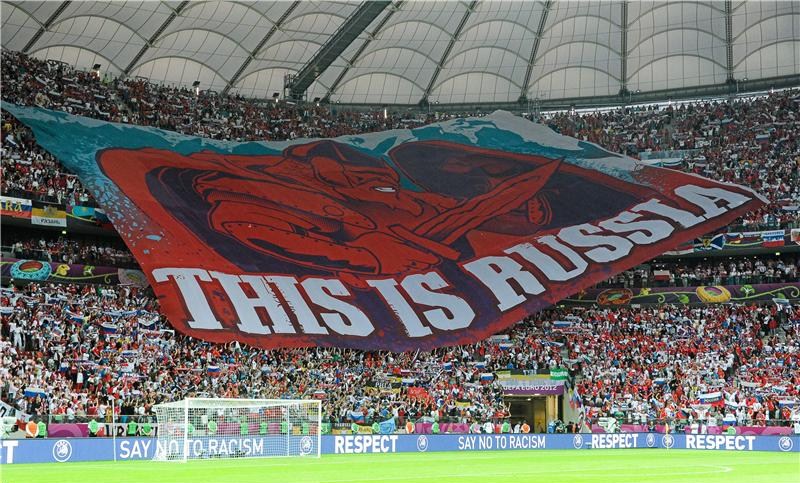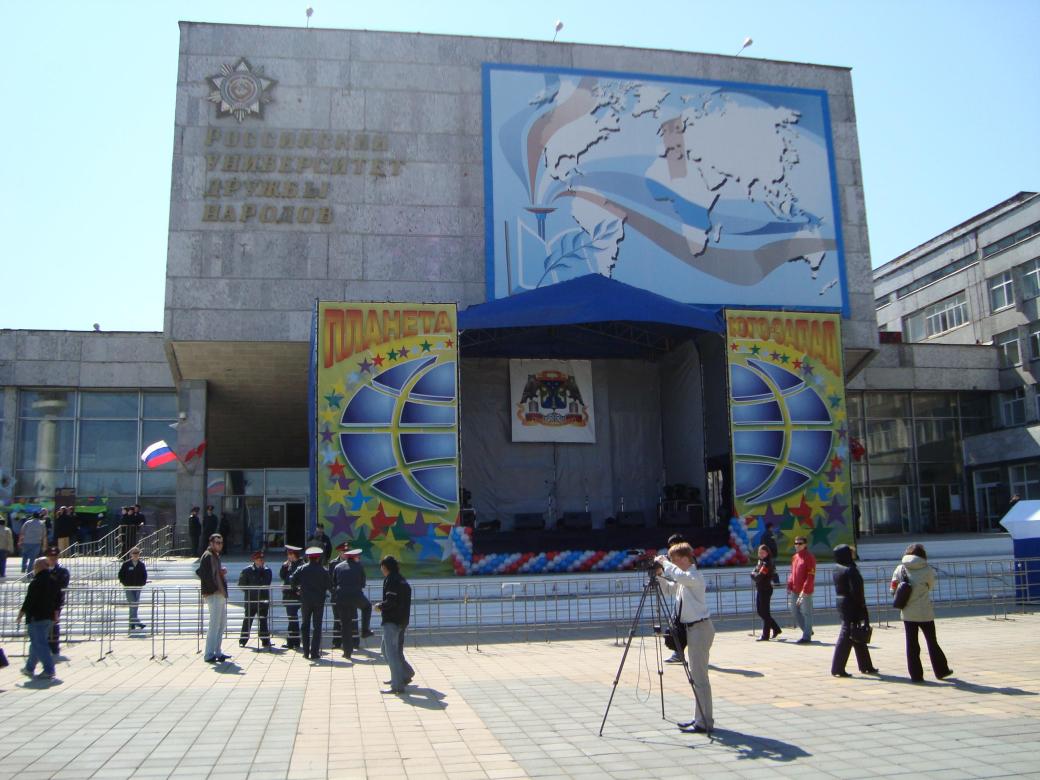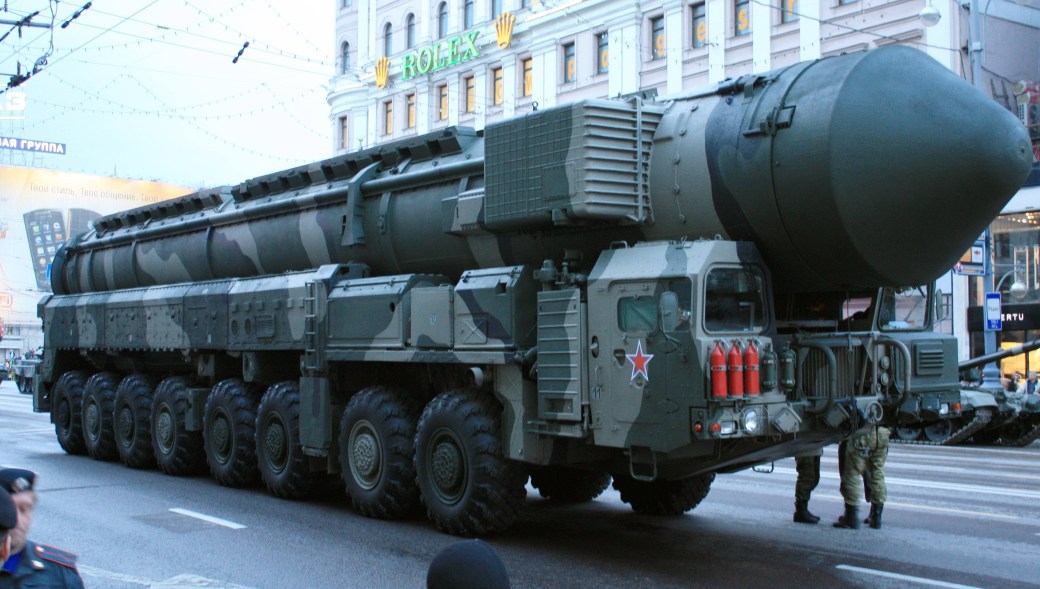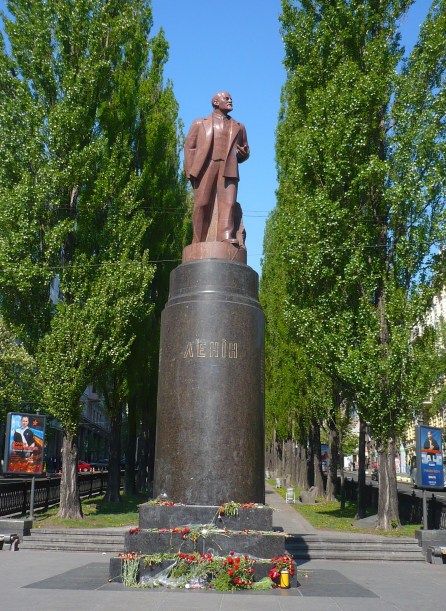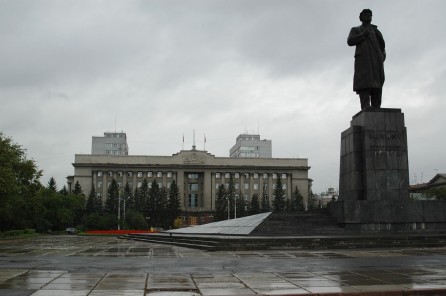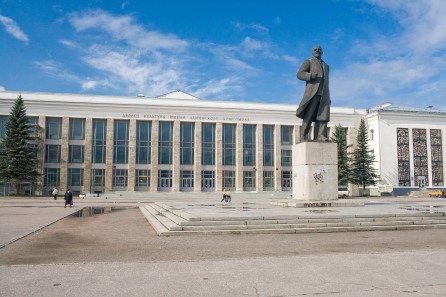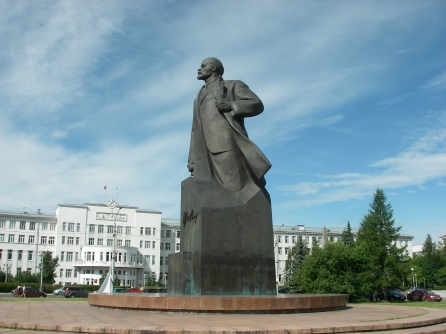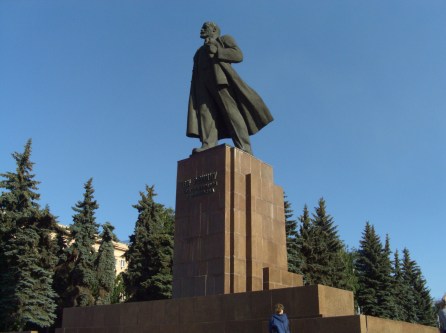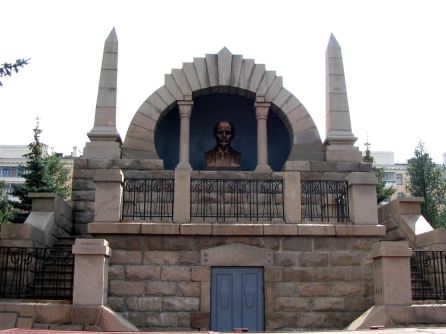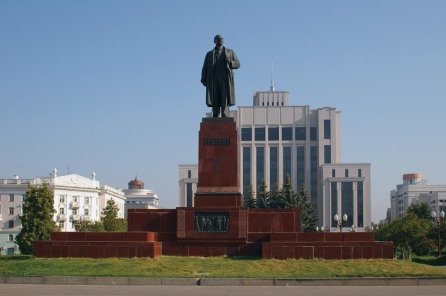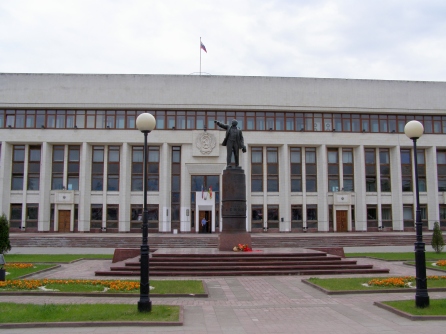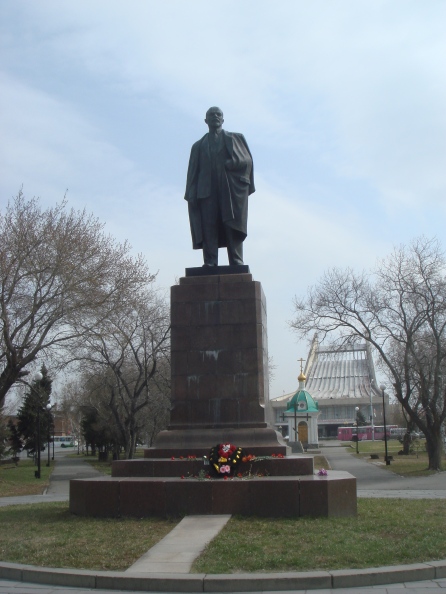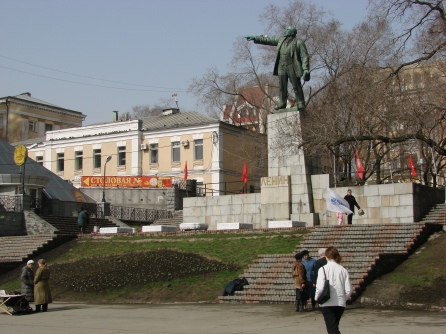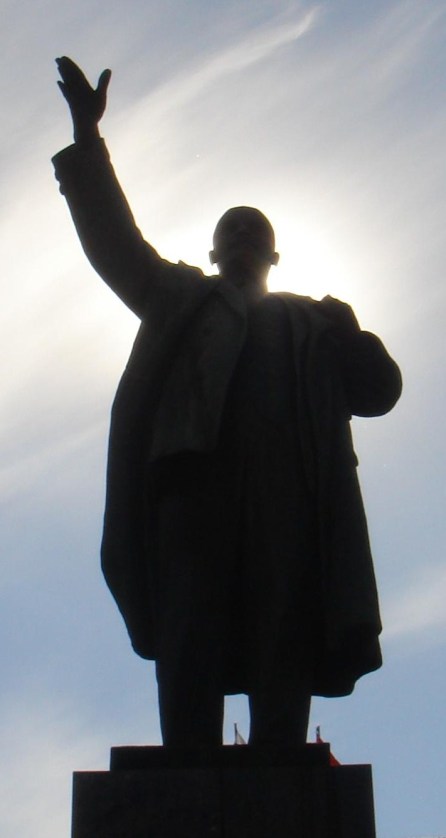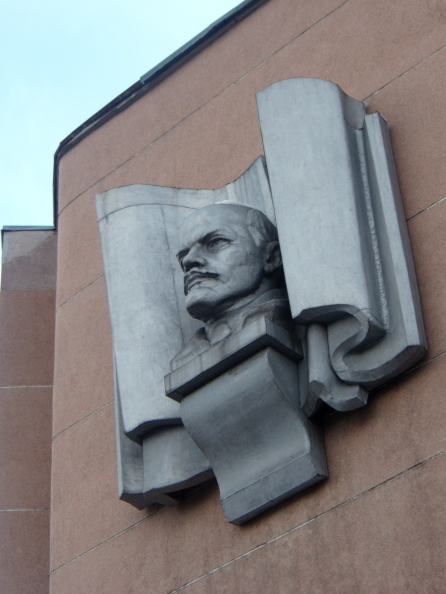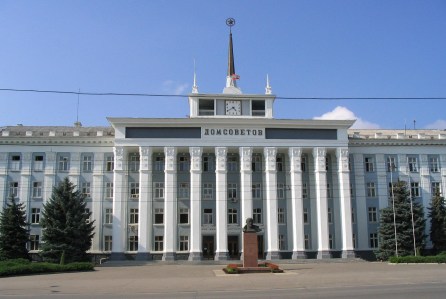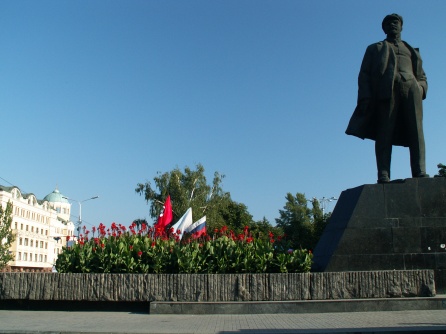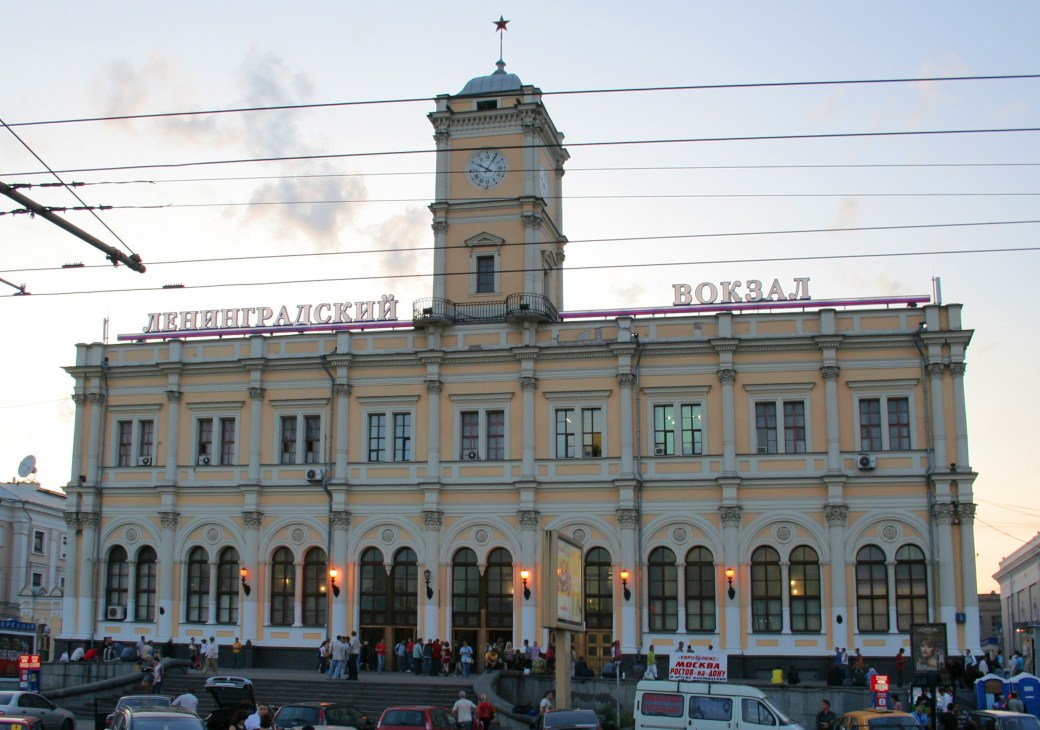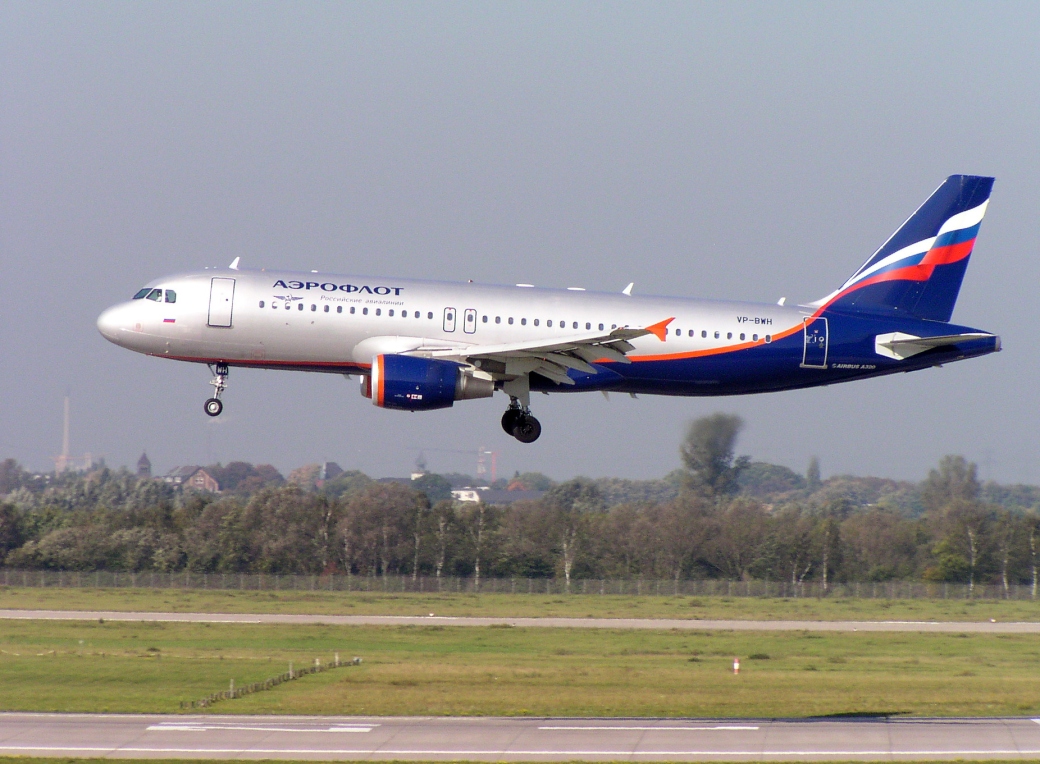CONTENTS: Author’s Note – 1. Unmasking Communist Deception Strategy: The Unmatched Value of Anatoliy Golitsyn’s Insight & Analysis – 2. Excerpts from Anatoliy Golitsyn’s 1984 Book, “New Lies for Old: The Communist Strategy of Deception and Disinformation” – 3. Excerpts from Anatoliy Golitsyn’s Second Book of 1995, “The Perestroika Deception: The World’s Slide Towards the Second October Revolution” – 4. Overwhelming Evidence of a Seamless Continuity of the Old USSR – 5. Communist Military Build-Up and Increasing Political Blackmail – 6. Case Study I: November 9, 2009, 20th Anniversary of the Fall of the Berlin Wall: A SPECIAL Celebration for the Communists – 7. Case Study II: The 2006 and 2012 New Year’s Concerts of the Vienna Philharmonic Orchestra: (Soviet-)Latvian Conductor Mariss Jansons’ Peculiar Symbolic Hints – 8. Reference Literature – 9. Audio & Video Sources – 10. Finally …
l
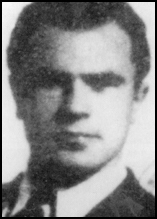
Anatoliy Golitsyn (1926 – 2008?)
l
l
AUTHOR’S NOTE
This 49,000-word treatise does not intend in any way to substitute the two very extensive treatises on this blog, “‘Forward, Comrades! Not Back!’ – America and the World on the Brink of Global Communism”, and “Red Surprise: Russian-Chinese Military Blackmail: Accept Communism or Face World War III”, although there is some overlapping between them. Rather, it will focus mainly on the core question that makes the decisive difference in looking at today’s world events, namely: Has the Soviet Union really gone out of business after 1991, as claimed by the purported “post-communist” regimes under Yeltsin and Putin and accepted at face value by the West ever since 1992, or was the “collapse of communism” of 1989/91 in Eastern Europe and the Soviet Union the boldest (and most consequential) deception operation in all of human history?
Raising a question of such monumental proportions – let alone, trying to answer it – would require an experienced, skilled, life-long political analyst fully familiar with the subject. This author – though he considers himself a private scholar of sorts, now in his late fourties – cannot and will not make such a claim.
Yet, in his studies of communist affairs, that he intensified around 2007, this author in that year of 2007 came across the two books by 1961 Soviet defector Anatoliy Golitsyn (1926 – 2008?), New Lies for Old: The Communist Strategy of Deception and Disinformation, Dodd, Mead & Co., New York 1984; and The Perestroika Deception: The World’s Slide towards the Second October Revolution, Edward Harle Ltd., London – New York 1995. The deeper he worked himself into the matter – re-reading the two books several times and applying Golitsyn’s analysis to current world developments – the more clearly things unveiled in front of him. As the late British political analyst Christopher Story (1938 – 2010), editor and publisher of Golitsyn’s second book, The Perestroika Deception, put it in 1995 in a recorded one-hour conversation hosted by William McIlhaney (that is given here further down in a full, word-by-word transcript) , “The brain goes ‘click’, and you suddenly understand. And, having gone ‘click’, you never go backwards”.
l
1. UNMASKING COMMUNIST DECEPTION STRATEGY: THE UNMATCHED VALUE OF ANATOLIY GOLITSYN’S INSIGHT & ANALYSIS
Who is (or was) Anatoliy Golitsyn, and what is his phenomenal contribution to overall geopolitical analysis, particularly of the “once”-communist bloc’s strategic long-range plannings with regard to conquering the whole world for communism?
Instead of setting up here a new, improvised chapter, a much more proper way of introducing Golitsyn’s groundbreaking value to the analysis of world communism and communist long-term strategy is to simply present here as a full, word-by-word transcript (done by this author) an absolutely first-class one-hour conversation of 1995 with Golitsyn’s colleague analyst, so to speak, the late Christopher Story (1938 – 2010), that was hosted by American interviewer William McIlhaney. The reader is greatly encouraged to also listen to and view this conversation directly, as presented currently on Youtube here: part 1/2; part 2/2 (8 years later, in 2003, the two gentlemen engaged in a sort of follow-up conversation on the same topic of the Perestroika Deception, that can be viewed here).
A CONVERSATION WITH CHRISTOPHER STORY ON ANATOLIY GOLITSYN AND THE PERESTROIKA DECEPTION. HOST: WILLIAM McILHANEY. RECORDED IN 1995. EXACT TRANSCRIPT & ILLUSTRATIONS BY THE AUTHOR OF THIS BLOG:
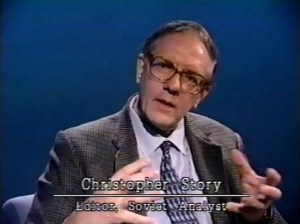 WILLIAM McILHANEY’S INTRODUCTORY WORDS: Welcome to the McIlhaney Report! I’m Bill McIlhaney. Each show we cover a crucial issue of the day, but always from a viewpoint of perspective rarely if ever aired by the mass media. We hope you find it interesting.
WILLIAM McILHANEY’S INTRODUCTORY WORDS: Welcome to the McIlhaney Report! I’m Bill McIlhaney. Each show we cover a crucial issue of the day, but always from a viewpoint of perspective rarely if ever aired by the mass media. We hope you find it interesting.
This is perhaps the most important interview we’ve ever conducted. Since 1989 we’ve been told constantly by the mass media and the government about the so-called “death of communism” and the “collapse” of the Soviet Union and its Eastern European satellite nations. We are told that the new Russian rulers are democratic and opening up to political and economic freedom. The Bush and Clinton Administrations have proposed even greater aid from U.S. taxpayers to the rulers of what is called the “New Russia” and the “new” Eastern European states. They tell us that we must aid and be partners with these rulers and join with them in a “New World Order”.
Our guest today can refute this conventional wisdom. He is one of two outstanding experts in the Free World on this subject [well, there has been also, since the late 1990s, profound U.S. analyst J.R. Nyquist]. The other expert, Anatoliy Golitsyn, the source of this information, has been living in the United States in hiding under an assumed identity since 1960 [in fact, since 1961] to protect himself from murder by the Soviet KGB. Our guest today is editor of the London-based periodical, Soviet Analyst, and editor of Golitsyn’s second book just published in the spring of 1995, The Perestroika Deception. I want to welcome Christopher Story to the McIlhaney Report!
CHRISTOPHER STORY: Delighted to be here.
McILHANEY: Very happy to have you, Sir! – For our listeners who are unfamiliar with this subject, we must start at the beginning. Anatoliy Golitsyn – this is one of, maybe one of two existing public photographs of him, probably taken thirty years ago.
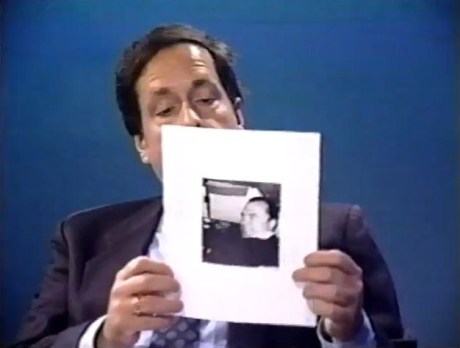
Who is Anatoliy Golitsyn? And what did he reveal when he defected from the Soviet KGB in 1960 [actually, in 1961]?
STORY: Golitsyn is the most important defector ever to have reached the West. He came out, actually, in 1961 – he fled to Finland in 1961, with his family. And he revealed the existence of a long-range strategy of deception based on Lenin’s principles. And his importance is that all defectors who’ve come since him appear to have been engaged in an attempt to refute what he says. So, we look to Golitsyn as the source of proper insights into what the communists are really up to.
McILHANEY: And he predicted, did he not, that the KGB would send false defectors deliberately to discredit him.
STORY: That’s correct. And this happened almost immediately afterwards. Within six months, several defectors, both from the KGB and from the military intelligence, arrived in the United States.
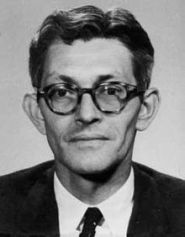
McILHANEY: Now, in addition to identifying Soviet moles in European and American, in the European intelligence system, British intelligence system, French, he provided this whole new understanding of Soviet disinformation strategy. There was one man in the CIA who listened to him seriously, that was James Angleton. Tell us about Angleton!
STORY: James Jesus Angleton [1917 – 1987; right] was a very remarkable counterintelligence expert. And he debriefed Golitsyn. And he became absolutely convinced that Golitsyn was telling the truth. This is clear from internal evidence. But, Angleton became aware, through Golitsyn, of the significance of what the Soviets were really up to.
McILHANEY: Hmhmm.
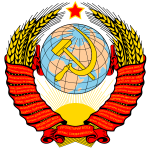
STORY: Basically, what Golitsyn taught and revealed was that these, all, Soviet governments are Leninist governments. They’re driven by the deception strategy perfected by Lenin, which is aimed at achieving a long-range strategy, namely: Control the whole world! [Right: Coat of arms of the overt USSR, 1922 – 1991]
McILHANEY: And part of this strategy, as really put into a codified plan by 1959, dealt with creating the impression that liberalisation, or destabilisation, decentralisation was occurring in the communist states, as a way of lulling the West into putting down its defences.
STORY: Yeah. What happened was – according to Golitsyn – is that after the death of Stalin the communists realised, in general, that the method of control they’d been adopting, namely brutal repression, was an inefficient method of achieving control over populations and that it was more efficient to seek to achieve control through infiltration and deception and through the control of the minds of the target.
McILHANEY: Hmhmm.
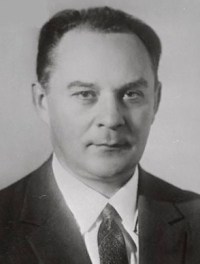 STORY: And, so, the Party instructed Alexander Shelepin [1918 – 1994; left], who was the head of the KGB, in 1958, to develop a plan for the use of the total resources of the revolution. And the KGB and the GRU, military intelligence, were instructed to become the instruments of the mobilisation of the resources of the revolution. So, between 1959 and 1961, Shelepin developed, perfected and agreed with the Party the full outline of this deception plan. And, the deception plan is basically a means of projecting communism into the whole of the rest of the world. And they do it through deception, and we can examine how this is done as we go on.
STORY: And, so, the Party instructed Alexander Shelepin [1918 – 1994; left], who was the head of the KGB, in 1958, to develop a plan for the use of the total resources of the revolution. And the KGB and the GRU, military intelligence, were instructed to become the instruments of the mobilisation of the resources of the revolution. So, between 1959 and 1961, Shelepin developed, perfected and agreed with the Party the full outline of this deception plan. And, the deception plan is basically a means of projecting communism into the whole of the rest of the world. And they do it through deception, and we can examine how this is done as we go on.
McILHANEY: Well, one of the features of the plan, obviously, was to give the impression that the international communist movement was breaking up, that there were splits, divisions, dissent, that there was a rift between Yugoslavia and the Soviet Union, there was a rift between Red China and the Soviet Union, all of these things were examples of this disinformation strategy, and one of the principal goals of it would be that the West would feel more secure and put down its guard.
STORY: Yes. Lenin, Lenin’s methodology involves the use of the dialectic. Now, the Western mind – which is a civilised, developed mind – does not understand dialectical deception, which is basically a Mongol concept. And the fake Russia-China split is a good example, by creating the false impression that there was a split – which incidently they’ve continued ever since, because now we have communist China and supposedly non-communist Russia, so the illusion of the split continues. The West was lulled into believing that if it supported China, it would be taking precautionary action against Russia. In fact, what’s happening, and is continuing: they are both working together, and their intentions, ultimately, are hostile, they are aggressively oriented, towards the West.
McILHANEY: Yes, and another consequence of staging, deliberately staging of phoney encouragement of, or setting, let’s say, setting up, the KGB setting up phoney dissident movements within communist countries and supposedly, or, in a theatrical way presenting what appears to be liberalisation or some lessening of tight control, that also has the effect of lulling the underground, the genuine underground opposition to communism in these countries, out in the open, giving them the false hope that they can speak out, and then further identifying them and destroying them.
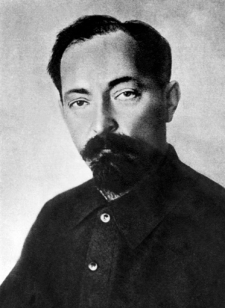
STORY: Well, this goes back actually to Tsarist days. In fact, the Tsarist secret police were adepts of this. But, Stalin’s henchman, the founder of the Cheka, Dzerzhinsky [1877 – 1926; right], was particularly skilled at using what we call false opposition. And in fact this was the main thrust of Lenin’s strategy in the 1920s. When Lenin launched into the West what is known as the “Trust”, he exported, he allowed the emigration of a large number of emigrés, and in their number were many controlled communist members of the Cheka. And, he introduced this false, controlled opposition to Western intelligence, and as a result the perception by Western intelligence of what was really happening was distorted. Now, this principle has been applied since 1961, and it came to its fruition under Gorbachev. Gorbachev’s “Perestroika”, which means restructuring, is in fact the restructuring not of Soviet society – although that was done for, there was a certain amount of reform and restructuring to give it credibility –,
McILHANEY: Superficial –
STORY: Superficial. It is, essentially, the restructuring of the Western mind, the control of the Western mind. That is what it means. Stalin used the word ‘perestroika’, and it meant, in Stalin’s vocabulary, it meant the re-shoeing of a horse. So, the West misunderstood the meaning of “Perestroika”, thinking that it meant reform of the communist movement. In fact, it’s a deception.
McILHANEY: Yes, and this is because everything that we’ve witnessed since 1989 has been part of this grand disinformation strategy, which Golitsyn revealed in his 1984 book, New Lies for Old, had been prepared by 1959.
STORY: Yes. The long-range strategy is what it says: It’s a long-range strategy. It took years to come to fruition. There are a number of reasons for this. They had to allow, for example, those with memories of the Stalin repressions to die off. They had to ensure that the true opposition no longer existed. And they have liquidated all true opposition in all East European countries.
McILHANEY: In all communist countries –
STORY: – all countries; with a few exceptions.
McILHANEY: Which means, as Golitsyn has pointed out, that we – and those exceptions are subject to question –, but when we see a supposed dissident movement within a communist or so-called “former-communist” state, having access to the media, operating openly –
STORY: – sure –
McILHANEY: – having resources, and being able to express itself and be heard around the world, it would immediately be suspect of being a KGB front operation, at least in terms of its leadership.
STORY: Absolutely correct. And as a result of the – Gorbachev first of all launches “Perestroika” internally, and when the softening-up process has been completed, i.e. the West is attuned to the fact that there’s been this apparent reform and that it’s all “falling apart”, they then export “Perestroika” to the whole world, so that in fact what has happened is that you have, instead of having walk-ins – you know, defectors arriving and knocking on the West’s door – you’ve got a mass walk-in, so no one knows who is genuine and who isn’t!
McILHANEY: Hmhmm. To go back just a bit regarding Golitsyn defecting to the American CIA in the early 1960s, he had an advocate in James Angleton.
STORY: Yeah.
McILHANEY: And the influence of what Golitsyn revealed was felt through Angleton’s policies.
STORY: Yeah.
McILHANEY: But that came to an end in 1974 when Angleton was fired by CIA Director William Colby –
STORY: Hmhmm.
McILHANEY: – after Golitsyn had warned that there were Soviet moles, Soviet agents, within the CIA at high levels. To what extent was Golitsyn vindicated by the Aldrich Ames exposure?
STORY: Totally! I mean, Golitsyn had been telling everybody, since he finished the first book, New Lies for Old, which actually he finished in 1980, although it was only published in 1984, that the CIA was penetrated. This was obvious from internal evidence. Now, of course, with the Ames case, that is proved. I mean, everybody knows that there are many more moles –
McILHANEY: Many more moles!
STORY: – inside Western intelligence than just Ames. But Ames is a symptom of the penetration of the Central Intelligence Agency.
McILHANEY: In the book – as you said, written in 1980, published in 1984 – Golitsyn’s New Lies for Old, he revealed not only this massive disinformation strategy, which goes back to 1959, and the ramifications of it, the applications of it during the 1960s, 1970s, but he made a series – the book was published in ’84 –, he made a series of incredible predictions regarding what was going to come as the result of this strategy, and the predictions are just amazing to read! Would you go over some of them?
STORY: Well, I mean, there are three or four pages which are just chock-a-block full of predictions. He talks about the removal of the Berlin Wall, liberalisation starting in East Germany and spreading to the rest of Eastern Europe. He says, for instance, that Dubček will be restored in Czechoslovakia, which duly happened for a brief period. And he talks about a reconciliation with the West and the reunification of Germany, and so on and so forth. And in a recent book written by Mark Riebling, called, Wedge: The Secret War between the FBI and CIA, published in 1994, Riebling carries out a careful analysis of Golitsyn’s predictions in New Lies for Old, and he established that out of 148 falsifiable predictions, 139 had been verified by 1993! And he gave him an accuracy rating of over 94%. That is without parallel in the West. I mean, this puts Golitsyn in a separate category from everybody. Now, I think –
McILHANEY: In other words, if Golitsyn is not telling the truth about –
STORY: – everybody has to explain why these predictions were correct.
McILHANEY: Well, if he is not telling the truth about the fact that all that we have witnessed since 1989 was planned as Soviet disinformation strategy going back this far, then he has to be a prophet, he just has to be a clairvoyant.
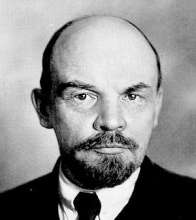
STORY: Either he has to have supernatural powers, or he has to understand Soviet strategy. And of course the answer is the latter. He understands Soviet strategy because he knows that it’s based on the thinking of Lenin [1870 – 1924; left]. He studied Lenin. Now, one of the things that I’ve done in the last few years is to go back to Lenin and try to read and understand what this evil man is saying. He’s actually preaching hatred. He is preaching how to deceive, and he is teaching us how to deceive. And Lenin’s disciples remain in control of the world communist movement. All they’ve done is relabel themselves in order to appear acceptable to the West. There’s a passage in Lenin where he says, ‘There may come a time in the revolution when true revolutionaries must put on the appearance and the clothing and the manner and the language of the enemy.’ And this is what they’ve done! And it’s very easy to see that this is the case once one understands that this is what’s going on. If you take someone like Andrey Kozyrev, the Russian Foreign Minister [at the time], you can see that everything he says is a deception. He is an absolute, he is the most brilliant representative of the Leninist case, currently operating. He is the son, incidently, of one of the Soviet diplomats who were kicked out of London by the Douglas-Home government in 1972. [Alec Douglas-Home, however, was Prime Minister only from October 1963 till October 1964, whereas from 1970 till 1974 he served as Secretary of State at the Foreign and Commonwealth Office under Prime Minister Edward Heath. So, it is unclear what period Christopher Story really had in mind. Unfortunately there is no information on said father of Andrey Kozyrev online, whether on Wikipedia or elsewhere.]
McILHANEY: There is a description in New Lies for Old of a new, liberal and more democratic figure who would emerge as the leader of the Soviet Union, that is a mirror image of Mikhail Gorbachev.
STORY: Yes.
McILHANEY: Now, tell us about Mikhail Gorbachev and perhaps his apparently more credible – at least, in the eyes of the world and the media – successor, Boris Yeltsin. Did they ever show any traits of interest in democratic reforms?
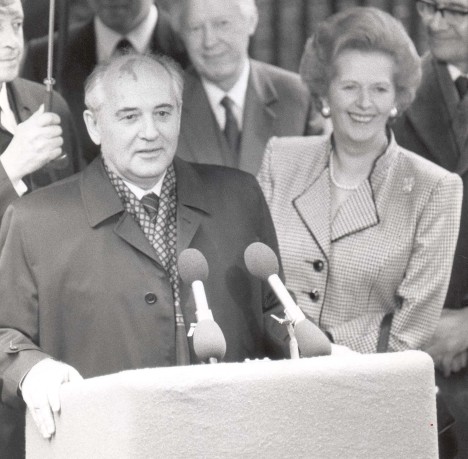
STORY: Well, what they did show an interest in was in the continuation of their Leninist strategy. I mean, the important point about Gorbachev is that – as in the case of Hitler in Mein Kampf – he clearly and repeatedly laid down in black and white, in speeches, and in his book, Perestroika, what he was doing. He made it quite clear what he is doing. In Perestroika, he said, ‘We went back to Lenin. We reviewed Lenin. We took inspiration from Lenin. And we based our strategy on Lenin.’ So, when I was asked by Mrs. Thatcher [1925 – 2013], as she then was, to see her in the House of Commons in July 1991, to explain these matters to her, I was completely flabbergasted when she said to me, “I don’t think Gorbachev is a Leninist any more.” And then she also said, “I don’t think we’ve been deceived. At least I hope we haven’t.” So, I’ve, I was – in fact, that was the real turning point in the later part of my life. That was when I realised I should spend basically most of my time trying to explain how she was conned and how wrong she was. [Left: Gorbachev visit, London, April 6, 1989]
Of course, it’s very simple to do: You can show from Gorbachev’s speeches, from his writings, that in fact he was constantly quoting Lenin. He is, was a key advocate of the Leninist world revolution. And of course, he remains so to this day. Gorbachev, as you probably know, is in charge of the so-called Gorbachev Foundation, which various experts led by Hans Graf Huyn, a well-known German expert, have identified as in fact the International Department of the CPSU! And it’s based here in San Francisco!
McILHANEY: Communist Party Soviet Union, yes.
STORY: Yes. The International Department of the CPSU was in fact the Comintern! So, the Gorbachev Foundation based in the Presidio in San Francisco is, in fact, the Comintern! And, what Gorbachev is in charge of is influencing the Western elite. And, in fact, the key elite of course is based here. This is the elite that he has to influence, which is what he has been doing ever since he arrived with a large delegation in Washington in 1987.
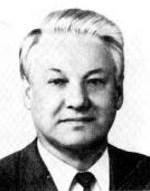
McILHANEY: That’s right. And his opponent, or his political rival, or the quote-unquote-opposition he faced, Boris Yeltsin [1931 – 2007], comes from the same Leninist background!
STORY: Oh, no question! I mean, Boris Yeltsin was awarded the Order of Lenin, he is a Communist Party chief. He could not possibly have risen to the level he did in the structures without being approved at the highest level! No one can move without approval. [Right: a rare photograph from approximately the early 1980s, i.e. well before the “democratic changes”, showing Boris Yeltsin as a clear-cut, resolute Bolshevist]
McILHANEY: Well, now looking at the reality of what exists today in light of the predictions Golitsyn made in New Lies for Old, we see that, as he predicted, the Soviet Union and its power and control over its republics, separate republics, and satellite nations still continues through the same KGB- and leaden bureaucracies that have simply been given new names, but that are still in place, fully in place.
STORY: Yeah. The so-called independence of the Soviet republics is false and provisional. It’s based on Lenin’s fake “Far-Eastern Republic”, which he set up in the late 1920s [well, in the early 1920s, as Lenin went basically insane in 1923 and died in January of 1924]. And the existence of these republics has been brought about for a number of strategic reasons. I mean, at a fairly low level, one of the most important reasons is that the World Bank and the International Monetary Fund and all the international institutions have been penetrated by all these countries. So, instead of just having the USSR, and the Ukraine, and Belorussia, as up to 1990, we now have, you know, 16 of these republics [well, in fact: 15 republics, rather than 16; today, out of these 15, 9 are regular CIS member states plus 1 ‘annexed’ member state (Turkmenistan) plus 1 ‘informal’ member state (Ukraine), plus 4 “ex“-member states, i.e. the 3 Baltic republics that have joined the EU, and Georgia]. There, suddenly, we’ve got 16 [15] KGBs, and we’ve got 16 [15] delegations in the World Bank and the IMF, so that these institutions have now metamorphosed into instruments of the revolution, more clearly than was the case before. That is one reason why they were given this curious independence, but another very important reason is that with the apparent independence to these countries, they opened up scope for independent military action, so that the repression, which subsequently took place in Georgia, Tajikistan, Moldova, and in Abkhasia, could take place, the minorities could be suppressed, and “Russia” could be whiter than white! You can see what I mean?
McILHANEY: Yeah.
STORY: In other words, the communists, the repression was carried out by apparent non-communists.
McILHANEY: Was delegated.
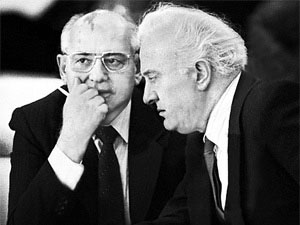
STORY: Was delegated. And it was actually in the case of Georgia where the most severe repression has been taking place, supervised by Shevardnadze, who the West thought was the –
McILHANEY: a Christian –
STORY: not only a Christian – you know, baptised as a Christian – but the “architect of the end of the Cold War”. – He is known as “Stalin II” in Georgia! [Above: Comrades Gorbachev and Shevardnadze around 1989/90]
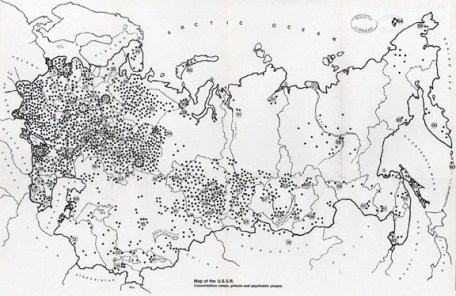
McILHANEY: Alright. In the early 1980s, Avraham Shifrin of Israel, an expert on Soviet concentration camps, published a guide-book to these camps listing over 1,700 concentration camps in the Soviet Union with millions of prisoners [Avraham Shifrin: The First Guidebook to Prisons and Concentration Camps of the Soviet Union; Stephanus Edition, Uhldingen, Switzerland 1980]. Are we to believe that all of these suddenly vanished about 1989? [Left: Map of the USSR: Concentration camps, prisons, and psychiatric prisons; from “The First Guidebook to Prisons and Concentration Camps of the Soviet Union”. – Click to enlarge.]
STORY: Are we to believe that these people suddenly, all of a sudden, set aside their ideology and suddenly started talking normally?
McILHANEY: Or that some 60 million members of the Communist Party of the Soviet Union, did they all stop being members of it instantly at the same time?
STORY: No. Golitsyn makes it quite clear in his new book, The Perestroika Deception, that the power structures depend on the continued adherence to revolutionary objectives of the Komsomol. There are 50, over 50 million members of Komsomol. They work closely with the structures. And, so, he says somewhere in the book, he says: scratch any of these so-called sudden, instant democrats, and you will find underneath them a Komsomol or a secret Party member. Well, all these people you see on the television screen in Moscow, they are all, without exception, secret Party or Komsomol members.
McILHANEY: We’re going to have to do our second show on the content of The Perestroika Deception because it covers the period of 1989 through 1993.
STORY: Hmhmm.
McILHANEY: And written by Golitsyn and actually derived from memoranda he prepared for the CIA, which they of course ignored. But, we hear about free enterprise, a burgeoning of free enterprise in the Soviet Union and in the Eastern European countries. What is the reality of this? I mean, isn’t it overwhelmingly controlled and limited in a way that makes a mockery of the term “free enterprise”?
STORY: They themselves call it state-controlled capitalism, which is of course a contradiction in terms.
McILHANEY: Right.
STORY: What has happened is that Lenin’s original state was a criminal state. The Cheka, the Soviet intelligence, controlled the Mafia, invented the Mafia, became the Mafia, so that what – this apparent outbreak of free enterprise we see is in fact controlled by the KGB; this outbreak of Soviet criminality: it’s controlled! And it’s being exported on a global scale. Why is it being exported? It’s one of the themes that they are developing to create problems which need global solutions, so that there’s a world crime epidemic, terrorist epidemic: ‘we’ve got to have global structures in order to contain this epidemic’, which they themselves have created. [Above: 2012 European Football Championship in Poland & Ukraine, June 12, 2012, Warsaw: Poland vs. Russia: Merely two years after the cynical liquidation of Poland’s whole more-or-less-conservative elite around then-President Lech Kaczinsky outside Smolensk, Russia, the unchanged Soviet Union shows – in no uncertain terms and despite the maxims of political correctness displayed around the playing field – its true old criminal colours of intimidation and terror! This was also the first European Football Championship ever, since their beginnings in 1960, that took place within the “former” communist bloc, apart from the 1976 championship hosted by Tito’s “non-bloc member” Yugoslavia. – Click to enlarge.]
McILHANEY: Also, the KGB generated criminal activity providing excuse for ever tighter control over whatever window-dressing business or entrepreneur-like activity may exist over there.
STORY: Sure. And not only that. But of course, you’ve got the drug element as well. Since the 1950s, Soviet military intelligence, GRU, has been in control of drug networks all over the world. And the reason the GRU controls, is involved in this, is because it’s sabotage. You know, the narcotics operation, it’s sabotage. Other elements are controlled by the KGB.
McILHANEY: Christopher, we are going to continue in our second part of this interview. I wanna thank you for being with us today. – If you found any of this information, as you should, interesting and disturbing, please contact us at the address or phone number given at the end of the programme! We’ll be happy to send you full documentation on any subject that we’ve discussed that may interest you. This is Bill McIlhaney, for the McIlhaney Report, thanking you so much for joining us!
WILLIAM McILHANEY: [Identical introduction as for part 1] … I want to welcome Christopher Story back to the McIlhaney Report! Thank you so much for being here!
CHRISTOPHER STORY: Delighted to be here!
McILHANEY: In our prior show, and I might say to our listeners who did not see it: if you would like to contact the background of the prior part of this interview, please contact us at the address and phone number given at the end of the show. We’ll make sure you have that. In our prior show we talked about the revelations by the most important defector ever to come to the West from the Soviet KGB, Anatoliy Golitsyn, that were first introduced in his 1984 book written four years earlier, called New Lies for Old. In that book, he revealed that by the late 1950s the Soviet KGB had formulated a massive disinformation strategy to deceive the West and further the goal of eventual world control by the communist movement. And that strategy involved creating the appearance of destabilisation or breaking up of the unified communist movement worldwide, the creation of rifts and divisions between communist countries and eventually the idea of the pretense, the stage-managed, false theatrical presentation of alleged liberalisation in communist nations, the purpose being to deceive the West into putting its guard down and make it easier for communism to advance. All that has happened, that we’ve witnessed since 1989 was predicted in incredible detail in this book written in 1980.
Now, we come to the present reality – that’s just background – in the Soviet Union, in what is called “Russia” today, Commonwealth of [Independent] States, or whatever new name they’re using. We have the same power of the Soviet KGB and the leaden bureaucracy still firmly in position; the concentration camps obviously – all 1,700 of them – have not disappeared; so everything that we’ve been told about is largely pretence and deception and show business.
STORY: That’s correct. One thing, I think, needs to be said here: And that is that the KGB and the GRU, Soviet intelligence, cannot exist without the Communist Party. The Communist Party and the KGB share the same bloodstream. They are the same entity. This was made clear by the head of the KGB, Alexander Shelepin, in 1961, when he made a very important speech, pointing out that the Party lives inside the structures of the KGB, and the KGB lives inside the Party. Now, I want to emphasise that at the outset because a number of books have appeared recently, suggesting the thesis that, you know, the Party disappeared, Communism died, the Soviet Union collapsed, but for some reason the KGB and the “Organs”, as they call it, continued.
McILHANEY: Like some residual, broken-down automobiles on the High Way, or something.
STORY: Well, the simile that I like to use, you know, is: the dog, the front of the dog, the head and the front legs fell off, and the back legs of the dog carry on walking. This is of course absolutely absurd! Now, of course we know that the Party exists. The Party had very great experience of working underground before the 1917 Revolution, and also in the German-occupied areas of the Soviet Union during the Second World War. So they know all about working underground. Recently, at a meeting at Washington, I was interrupted by a well-known veteran-analyst in the middle of my presentation, and he said, “I suppose you’re gonna tell us that the Communist Party still exists, are you?” So I said, “Well, funny enough, I was just coming to that!” And I was able to point to a document published by the Communist Party USA, CPUSA, in October last year [i.e. October of 1994], where they listed the fourty or fifty congratulatory messages that Gus Hall, the Chairman of the Party, had received on the occasion of the 70th anniversary of the Communist Party USA. And one of these messages came from the “Moscow Committee, CPSU”!
McILHANEY: Which according to CNN no longer exists!
STORY: It “doesn’t exist”. According to the received version, it doesn’t exist. In the April issue of the Communist Party USA’s political journal, Political Affairs, there’s a report by one of their senior officials, who visits Moscow and attends a conference of the visible Communist Party [i.e. the Communist Party of the Russian Federation, CPRF], run by Gennady Zyuganov, or led by Gennady Zyuganov, and this American communist attends this Party in January 1995, and in his report, in the April issue, he says that the most important delegation to the Congress was that of the “Communist Party of the Soviet Union, which controls all the other parties,” and I quote!
McILHANEY: Rather frank admission. Obviously, that we won’t be reading about there on the front page of the Los Angeles Times.
STORY: Or the New York Times, for that matter.
McILHANEY: Now, let’s talk about some of the alleged examples of political freedom in the Soviet Union, notably the rise of rival political figures opposing Yeltsin, such as Zhirinovskiy. What is the purpose of this? There seem to be – in the first place, any dissident, movement or individual, in a communist country, who ever had access to media or to communicating with the outside world, is immediately suspect, as Golitsyn has shown, because the real opposition would never be heard from and would not continue to exist.
STORY: That’s correct. What we see on our television screen, in Moscow, is democratism, which I define as the creation and maintenance of the illusion of democracy.
McILHANEY: It’s like a play!
STORY: They’re playing games.
McILHANEY: Yes. It’s a performance!
STORY: So – and this is documented in the record of the 29th Communist Party Congress, which was held in Moscow in July 1990. There’s a speech by Shevardnadze, and another speech by Gorbachev, and also one by Yeltsin, and all three of these characters say that now is the time for, the revolution is among us, to choose which faction they wish to belong to. In other words, they can, you know, they can decide which label they would feel happiest under: would they like to be a false conservative, or would they like to be hardline Stalinist? In other words, in coded language, in the report, which is in the public domain:
McILHANEY: Play your role!
STORY: Play your role! Which group would you like to masquerade in, to pretend to be a democrat in, would you like to play democratism? So, that’s what’s going on. Now, someone like Zhirinovskiy is of course, can best be described as a caricature of a Soviet, of a Russian nationalist. He is of course KGB, he’s been created by the KGB. His purpose, among his purposes, well, I can identify two of them, really, his most important purpose is to be even ghastlier, and more ghoulish, and more threatening to the West than the existing regime in Russia, so that the West sort of falls down and prays to Yeltsin, you know, for goodness sake, –
McILHANEY: And we must support Yeltsin because –
STORY: Previously it was, “We must support Gorbachev!” Now we must support Yeltsin. That’s one of his purposes. Another very important purpose of Zhirinovskiy is as a mouthpiece or a trumpet of true Soviet strategy! Zhirinovskiy goes to Cyprus, and he says of course it’s Soviet policy to incorporate Turkey within a Greater Soviet Union! He says that openly. And he writes a book called The Thrust to the South, or I believe that’s the title, roughly [in fact, the title is: The Final Thrust South], in which he describes Soviet GRU strategy! But – and he tells us this! But of course, it’s dismissed by the liberal press in the West, and by everybody, as “the rantings of a madman”,
McILHANEY: – of a nationalist, right.
STORY: – but actually it’s an accurate statement of Soviet, of one group of options which the strategists have in mind. I’m glad I mention the word ‘strategist’, because that brings me to the point that “Who are the people running this deception?” Golitsyn, in this book The Perestroika Deception, which I’ve edited, refers to them as “the strategists”. And I think that’s a sensible thing to do. And he says that the main locus of the strategists is the so-called Security Council. Now, this is a group which under Gorbachev used to be called the Presidential Council. And it’s always existed, even, ever since the time of Lenin. There’s always been a Security Council or, you know, a top secretariat, which is over and above all other structures. It’s completely unconstitutional. Yeltsin has a nice, new Constitution: it’s not mentioned. They sit in this Security Council, and they modify, or develop, elements of the strategy. He implies in this book that this is not the main, or the only locus of the strategists, but that is where they are formally visible.
McILHANEY: Hmhmm. Well, a couple of other examples of the charade, the stage-managed performance of democratism, are the 1991 phoney Coup unseating Gorbachev in the most friendly, protected, and safe manner, which he probably helped plan, and the 1993 attack on the Chamber of People’s Deputies. Can you talk about those?
STORY: Yes, I can talk about – it’s easier to talk about the August Coup because we’ve had more time to think deeply about the Coup. The first thing to note is that Gorbachev made a number of statements in advance of the Coup, forecasting the Coup. There’s one instance, I think I try and read it out if I can, where he says, this is a very important statement, in May 1991, speaking with President Mitterand at a press conference, President Mitterand of France, he says, “The dangers lie in the fact that someone, analysing at some private moment or other this or that instance or episode or even event, including a dramatic event,” – that’s a reference to the Coup – “should not make hasty conclusions and cast out all that has been acquired and what we have created in putting international relations onto new channels, onto new rails.” Now, I’ll come back to that, but –
McILHANEY: Introducing what was going to happen!
STORY: He was introducing the Coup. The significance of the – the Coup achieved a number of objectives simultaneously. First of all, incidently, he ‘dies’ and ‘rises again’ in three days. Now, this is a typical KGB ploy. They like to make comparisons with Russian traditional religion: you know, Christ died, and he rose again in three days. So, and another point, very interesting point about the Coup, is that communism is dismantled in Russia in a space of three weeks. Now, three weeks is the period in which Stalin rolled up the opening to the West, known as the New Economic Policy in the 1920s. Remember, the New Economic Policy, on which the present deception is modelled.
McILHANEY: The first experiment called Glasnost; the first example of Glasnost.
STORY: Yeah. That’s correct. The New Economic Policy, where they export into the West all these false, controlled members of the apparent opposition. So that the Coup achieves the objective, first of all, of providing a pretext for the rolling up of communism. You remember, Gorbachev comes back from Foros in the Crimea, and he says: I’ve been struggling with these die-hard communists all these years to try and get them to see sense and to modernise themselves and to become less corrupt, and I have failed, so I resign as the General Secretary. And then a few weeks later, we have the “banning of the Communist Party”. So that then you have a situation where they’re ready for that scene change: You have Yeltsin, who is President of Russia coincidently at the same time as Gorbachev is President of the Soviet Union. And the scene changes, and the scenery moves around on its swivel, and suddenly, you know, on Christmas Day, when we should be, in England, we should be watching the broadcast of the Queen, we suddenly find ourselves watching Gorbachev saying that, you know, that he’s resigning as General Secretary. He chooses Christmas Day for a deliberate reason in order to get maximum coverage, and also to replace God! So, by Christmas Day, they have wound up the Soviet Union, which is all false, and they have replaced it with apparent “non-communism” so the West rejoices.
McILHANEY: – and vanished a Party, political Party, a controlling structure, with 65 million members. That’s pretty hard [remaining sentence incomprehensible].
STORY: They all “vanished” over night! In the course of 1991, they suddenly stopped talking their ideological gibberish, they suddenly appeared in Western suits, with nice smiles, –
McILHANEY: – eager to do business –
STORY: – eager to do business, and only too pleased to enter the modern world. And the West thinks it’s all wonderful and the West has won the Cold War! And, I hate to say it, but the Americans have been more insistent on “having won the Cold War” than anybody else; and we still, even to this day, hear people bragging about winning the Cold War; actually the Russians won it.
McILHANEY: Right, and all of this Soviet disinformation planned decades ago, carefully, to deceive and destroy the West! Let’s talk about the connection of this strategy to continental Europe in the context of the European Union, which has placed a stranglehold, a regional world government, a new level of socialist-totalitarian control – unified, centralised control – over all of Europe, and also Great Britain, –
STORY: – that’s correct –
McILHANEY: – and destroyed whatever remaining national sovereignty existed for Europe or Britain.
STORY: Right. The easiest way to understand this is to go back to Lenin and to recall his central theme, which is that the state withers away. Lenin is anti-state. The purpose of the European Union is to merge all these countries – including my own, the most ancient of the lot – into a regional bloc. Our sovereignty is in jeopardy. If we remain an independent state in ten years’ time, I will be very surprised! Now, this has been brought about, I hasten to add, by conservative governments.
McILHANEY: And the European Union not only has placed economic and property controls on people in Europe and Britain, right down to the most minute level of business transactions, and in effect says that none of the member states, none of the member nations, can act in terms of their national interests any longer.
STORY: Well, that’s right. There is no such thing as a national interest because the national interest is shared by all [then] 15 members; and the Commission: 16 members!
McILHANEY: And this whole thing was sold to us and to the West, and businessmen over here were enthusiastic because it was supposed to be something that eliminated trade barriers and would promote business.
STORY: Yeah. It is in fact a costums union, the very reverse of what it was marked as. But, more, what I like to do is to draw attention to the significance of the European Union in terms of Soviet geopolitical strategy: What is the Soviet interest in the European Union? The European Union is intended to be the bloc which will expand to cover the whole of the landmass from the Atlantic to Vladivostok. We have, and I have friends among them, we have MPs in the Conservative Party calling for – vociferously – the expansion of the European Union, to include all the so-called non-communist East European countries, all of which, by the way, are run by communists. What happened was that immediately after the so-called changes, groups of apparent dissidents were put in power, and the West thought, “That’s it. We’ve got non-communists in power.” They didn’t stay there for more than a year, most of them, nine months in some cases. In the case of Vaclav Havel, the President of the Czech Republic, he had other tasks to perform, he was in charge of dividing Czechoslovakia in two. Incidently, there is a secret agreement between Kohl, the Chancellor Kohl of Germany, and Gorbachev, which was reached in Geneva in September 1990, for the subdivision, for the division of Central Europe. And under this agreement, a copy of which I have, I obtained in Prague, Czechoslovakia was to be divided. The reason I know this document is genuine is that it’s dated November 1991, and these events took place at the end of 1992. Czechoslovakia was to be divided in halves. The Slovak area was to be in the immediate Russian sphere of influence, and the Czech Republic was to be in the German sphere of influence and was to be merged with Germany within 15 years [the first big EU eastward enlargement took indeed place on May 1, 2004, taking in, among six other socialist states and Malta and Cyprus, both Czechia and Slovakia; yet, with Germany having meanwhile turned completely Marxist, it is safe to say that the German strategy has effectively been nullified by that of the Soviets: no matter how hard parts of the German political elite may still be trying to proceed with their Pan-German hegemonial project over the whole of Europe, international communism, with the great help of the German “Social Democrats” and Greens, as well as since 2005 with the help of the East German Trojan Horse in the Kanzleramt, Angela Merkel, appears to have won that race]. So, Havel has other tasks to perform, that’s why he is still visible there. Wałęsa, Lech Wałęsa of Poland, similarly. By the way, he can’t move, he can’t brush his teeth, without the local KGB’s permission. The same applies to Yeltsin, by the way.
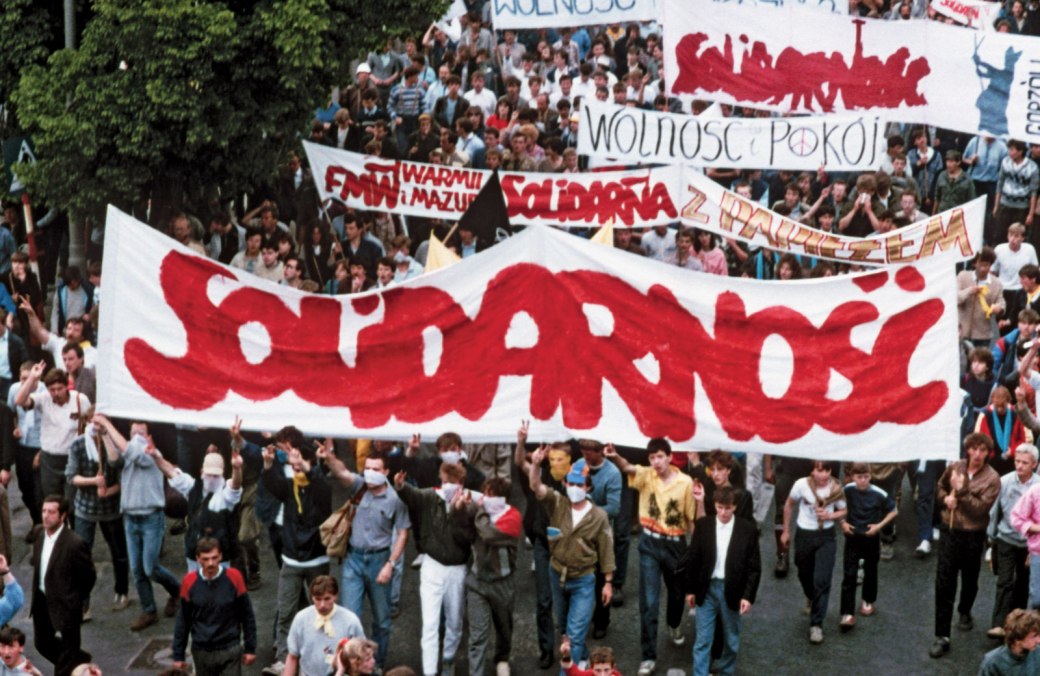
McILHANEY: And his movement, Solidarity, in Poland, was always run and set up by the KGB as a phoney opposition movement.
STORY: Solidarity was a phoney opposition movement. That was, I mean, a classic case of this.
Incidently, the image of brushing teeth is amusing. You know, there’s this man, General Korzhakov, in the Kremlin, who is said to be the most powerful wield, secret power in the whole of the Leninist state. I call him Yeltsin’s toothbrush man. Yeltsin can’t brush his teeth without permission from Korzhakov.
McILHANEY: So it was necessary to, as Golitsyn has shown in New Lies for Old and the new book, The Perestroika Deception, to carry on this grand disinformation strategy and performance about a ‘collapse of communism’, a ‘collapse of the Soviet Union’, and the ‘end of communism’ in Russia and the satellite nations, as a preliminary step towards merging this still-KGB-controlled area with Western Europe, now effectively merged under this new socialist stranglehold, the European Union.
STORY: Yes. The European Union is pushing for expansion eastwards to embrace all these so-called non-communist countries; they are of course controlled by communists. John Major, the British Prime Minister, said on BBC Radio 4, in his New Year message on the 1st of January, 1992, and I quote, because I heard him with my own ears, “I look forward to the day when Russia is a fully-fledged member of the European Community,” as it then was. So, by expanding NATO to include these countries, and expanding the European Union to include these countries, we are actually accommodating and facilitating Russian strategy, which is to achieve hegemony over the whole landmass. Now, in general terms, what is the object of Soviet strategy? The object of Soviet strategy, at the present phase, is: convergence. That’s the word that Golitsyn uses in his books. That is the purpose of, that is the general purpose of the deception: to create the environment which will encourage the West to believe that there has been a political discontinuity, so that the West ‘can relax’, the West is caught off guard, and the West now indulges in collaboration, but in fact the Soviet equation consists of what I call: “collaboration”-hyphen-“blackmail”. The second part of the equation is “blackmail”. And we are collaborating and forgetting about the blackmail element, and this is very, very dangerous! Very dangerous!!!
McILHANEY: In addition to exposing this massive disinformation strategy, which Anatoliy Golitsyn uniquely has exposed and made available as information in these two books: What can be done and what should be done by the West in response to this, assuming enough people became aware of it in time?
STORY: Well, as you correctly say, I take the second point first, the important point is that there should be people who, in the structures, the power structures in the West, who do finally come to realise this deception, and indeed Golitsyn clearly says that he believes that this will eventually happen, but he says it will be too late when it does happen! Incidently, coming to understand how the Soviet deception works may come to some people through revelation, rather than through intellectual application. A mixture of both is helpful.
McILHANEY: You mean, by just observing events.
STORY: Yeah, I mean, revelation is helpful. You know, I’m not talking about Paul on the road to Damascus, but in fact the brain goes ‘click’, and you suddenly understand, and having gone ‘click’, you never go backwards!
McILHANEY: Right.
STORY: But the answer to the first part of your question is that we should leave them to stew in their own juice. We should withdraw. Now that we’re so deeply involved, we gotta do it subtly, but we should withdraw from cooperation. We needn’t announce it, we should just do it!
McILHANEY: And stop aiding them!
STORY: Stop aiding them! Stop cooperating! Withdraw whenever we see an opportunity! Retrench! AND: We should re-arm like crazy!!! Because the only thing these people understand is that we are determined not to let them prevail!
McILHANEY: And we might say that since 1917 the Soviet Union and its slave empire have existed entirely as a result of transfusions of aid, technology, money, from the West, and primarily from the United States, paid for by U.S. taxpayers.
STORY: That’s correct. They’ve also supplemented this income from controlling the drug trade.
McILHANEY: Yes. Obviously, Christopher, this is some of the most crucial information that Americans need to be aware of, and those of you who’re listening to this programme, if you found this information new and did not see the first half of the interview, I will urge you to contact us at the address or phone number given at the end of the programme, because we would be happy to furnish you with a summary as well as extensive documentation so that you would be able to research this subject yourself.
Are you concerned, Anatoliy Golitsyn has been protecting himself for thirty years because he was on the top of the KGB hit-list, are you concerned about your own personal safety?
STORY: Golitsyn was condemned to death by Semichastniy, who was in fact the head of the KGB at the time. He asked the Party’s permission to condemn him to death, and this is the case. He is on the death-list, and he remains so. He’s under deep cover. – Golitsyn wrote to me in May 1992, having read some issues of Soviet Analyst, and he did say in the letter, the first letter he wrote to me, that he thought that I was in some danger. I have discussed this with him since, and –
McILHANEY: Needless to say what we’re fighting for is more important.
STORY: Yes.
McILHANEY: I want to thank you for being here. And this is Bill McIlhaney for the McIlhaney Report, thanking you so much for joining us.
Insert: For more information: The McIlhaney Report. P.O. Box 7486. Beverly Hills, CA 90212. (310) 275-3194.
Director: Andrea Stapley. Assistant Director: Ed Nugent. Lighting/Camera/Audio: Nigel Lizeranzu; Louise Gutierrez.
Produced at Century Communications. Public Access Studio. Santa Monica, California.
l
SOME CONSIDERATIONS
This indeed historic interview should make us think, particularly as the late Christopher Story (1938 – 2010) was as a Sovietologist only second to Anatoliy Golitsyn himself. To some readers these revelations may come as a surprise, if not as a shock. Still, we MUST face these uncomfortable truths, even though by now, as a Soviet communist rules in the White House in Washington D.C., things seem to have long passed the point of no return. The world revolution has advanced that far that one might see little more options left, so to speak, but to pray. And that may well be the whole point about it: that we have to leave behind our scandalous and decadent ways, come out of our shameful apostasy – that has facilitated this present state of affairs, in the first place -, and return to the firm and undistorted faith of earlier generations! Without such a spiritual perspective, every attempt to fight this evil solely on a political, or even military level, will be in vain. And who knows what degree and length of punishment God in Heaven sees fit to send down upon us! After all, we must not overlook how deep we have allowed ourselves down! Just try to compare the spiritual exquisiteness of the High Middle Ages with our current mess: Strong faith no longer exists. All sense of authority: gone. Purity, chastity, piety, or courtship are now an object of ridicule. Self-cultivation and love of fine music and the fine arts has been replaced by addiction to garbage that does not even deserve the title ‘music’ or ‘art’. Knowledge of classical literature, let alone producing fine literature oneself, is about to die out. The value of self-restraint, in whatever regard, has become a widely foreign category in our hedonistic anti-culture, and drugs have severely harmed several generations in a row. Not to mention the core of any functioning society, the family unit, massively undermined and to a great extent already destroyed. As a consequence, the Marxist-totalitarian state is now about to fill this overall vacuum, using envy and class-hatred as the new order of the day, with distinction and exclusiveness now being defamed as the new capital sins, family sentiment as outmoded, and Christian morals as bigotry. The old order, the old way of life is a thing of the past, which had been the objective of Highgrade Freemasonry and Communism all along: “Ordo ab Chao”, order out of chaos, says it all: in effect, not before all memory of the old days is gone, and all resistance against the fake ‘new’ is crushed, can be fully installed this long-worked-for communist society, whose predominant feature is that it denies God, more precisely: that it does not know God any longer. Yet, such a world in which the whole of humankind would have been thrown into such an abyss of complete godlessness can hardly be imagined, by human reckoning, as a durable state of things. God the Lord has His own ways and time measure, but according to Scripture – whatever is going to happen, and however long it may take – the forces of darkness will not prevail!
l
2. EXCERPTS FROM ANATOLIY GOLITSYN’S 1984 BOOK, “NEW LIES FOR OLD: THE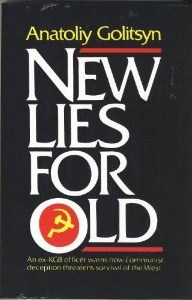 COMMUNIST STRATEGY OF DECEPTION AND DISINFORMATION”; Dodd, Mead & Co., New York 1984
COMMUNIST STRATEGY OF DECEPTION AND DISINFORMATION”; Dodd, Mead & Co., New York 1984
Now, let’s have a look directly into Anatoliy Golitsyn’s book, New Lies for Old (there is a complete, authentic scanned-in PDF-copy of the book for free, which you can access here; or you can go to amazon.com and try and order it there.) Here is, first, the very informative Editors’ Foreword by Stephen de Mowbray, Arthur Martin, Vasia C. Gmirkin, and Scott Miler; followed by Anatoliy Golitsyn’s own personal Author’s Note (emphases by this author):
l
EDITORS’ FOREWORD
Very rarely disclosures of information from behind the Iron Curtain throw new light on the roots of communist thought and action and challenge accepted notions on the operation of the communist system. We believe that this book does both these things. It is nothing if not controversial. It rejects conventional views on subjects ranging from Krushchev’s overthrow to Tito’s revisionism, from Dubcek’s liberalism to Ceausescu’s independence, and from the dissident movement to the Sino-Soviet split. The author’s analysis has many obvious implications for Western policy. It will not be readily accepted by those who have for long been committed to opposing points of view. But we believe that the debates it is likely to provoke will lead to a deeper understanding of the nature of the threat from international communism and, perhaps, to a firmer determination to resist it.
The author’s services to the party and the KGB and the unusually long periods he spent in study, mainly in the KGB but also with the University of Marxism-Leninism and the Diplomatic School, make the author uniquely well qualified as a citizen of the West to write about the subjects covered in this book.
He was born near Poltava, in the Ukraine, in 1926. He was thus brought up as a member of the postrevolutionary generation. From 1933 onward he lived in Moscow. He joined the communist youth movement (Komsomol) at the age of fifteen while he was a cadet in military school. He became a member of the Communist Party of the Soviet Union (CPSU) in 1945 while studying at the artillery school for officers at Odessa.
In the same year he entered military counterintelligence. On graduation from the Moscow school of military counterespionage in 1946, he joined the Soviet intelligence service. While working in its headquarters he attended evening classes at the University of Marxism-Leninism, from which he graduated in 1948. From 1948 to 1950 he studied in the counterintelligence faculty of the High Intelligence School; also, between 1949 and 1952 he completed a correspondence course with the High Diplomatic School.
In 1952 and early 1953 he was involved, with a friend, in drawing up a proposal to the Central Committee on the reorganization of Soviet intelligence. The proposal included suggestions on the strengthening of counterintelligence, on the wider use of the satellite intelligence services, and on the reintroduction of the “activist style” into intelligence work. In connection with this proposal, he attended a meeting of the Secretariat chaired by Stalin and a meeting of the Presidium chaired by Malenkov and attended by Khrushchev, Brezhnev, and Bulganin.
For three months in 1952-53 the author worked as a head of section in the department of the Soviet intelligence service responsible for counterespionage against the United States. In 1953 he was posted to Vienna, where he served for two years under cover as a member of the apparat of the Soviet High Commission. For the first year he worked against Russian émigrés, and for the second against British intelligence. In 1954 he was elected to be deputy secretary of the party organization in the KGB residency in Vienna, numbering seventy officers. On return to Moscow he attended the KGB Institute, now the KGB Academy, as a full-time student for four years, graduating from there with a law degree in 1959. As a student of the institute and as a party member, he was well placed to follow the power struggle in the Soviet leadership that was reflected in secret party letters, briefings, and conferences.
From 1959 to 1960, at a time when a new long-range policy for the bloc was being formulated and the KGB was being reorganized to play its part in it, he served as a senior analyst in the NATO section of the Information Department of the Soviet intelligence service. He was then transferred to Finland, where, under cover as vice-consul in the Soviet embassy in Helsinki, he worked on counterintelligence matters until his break with the regime in December 1961.
By 1956 he was already beginning to be disillusioned with the Soviet system. The Hungarian events of that year intensified his disaffection. He concluded that the only practical way to fight the regime was from abroad and that, armed with his inside knowledge of the KGB, he would be able to do so effectively. Having reached his decision, he began systematically to elicit and commit to memory information that he thought would be relevant and valuable to the West. The adoption of the new, aggressive long-range communist policy precipitated his decision to break with the regime. He felt that the necessity of warning the West of the new dimensions of the threat that it was facing justified him in abandoning his country and facing the personal sacrifices involved. His break with the regime was a deliberate and long-premeditated political act. Immediately on his arrival in the United States, he sought to convey a warning to the highest authorities in the U.S. government on the new political dangers to the Western world stemming from the harnessing of all the political resources of the communist bloc, including its intelligence and security services, to the new long-range policy.
From 1962 onward the author devoted a large proportion of his time to the study of communist affairs as an outside observer reading both the communist and Western press. He began work on this book. While working on the book he continued to bring to the attention of American and other Western authorities his views on the issues considered in it, and in 1968 allowed American and British officials to read the manuscript as it then stood. Although the manuscript has since been enlarged to cover the events of the last decade and revised as the underlying communist strategy became clearer to the author, the substance of the argument has changed little since 1968. Owing to the length of the manuscript, a substantial part of it has been held over for publication at a later date.
With few exceptions, those Western officials who were aware of the views expressed in the manuscript, especially on the Sino-Soviet split, rejected them. In fact, over the years it became increasingly clear to the author that there was no reasonable hope of his analysis of communist affairs being seriously considered in Western official circles. At the same time, he became further convinced that events continued to confirm the validity of his analysis, that the threat from international communism was not properly understood, and that this threat would shortly enter a new and more dangerous phase. The author therefore decided to publish his work with the intention of alerting a wider sector of world public opinion to the dangers as he sees them, in the hope of stimulating a new approach to the study of communism and of provoking a more coherent, determined, and effective response to it by those who remain interested in the preservation of free societies in the noncommunist world.
In order to give effect to his decision to publish, the author asked the four of us, all former U.S. or British government officials, for editorial advice and help. Three of us have known the author and his views for twelve years or more. We can testify to his Sisyphean efforts to convince others of the validity of what he has to say. We have the highest regard for his personal and professional integrity. The value of his services to national security has been officially recognized by more than one government in the West. Despite the rejection of his views by many of our former colleagues, we continue to believe that the contents of this book are of the greatest importance and relevance to a proper understanding of contemporary events. We were, therefore, more than willing to respond to the author’s requests for help in editing his manuscript for publication, and we commend the book for the most serious study by all who are interested in relations between the communist and noncommunist worlds.
The preparation of the manuscript has been undertaken by the author with the help of each of us, acting in an individual and private capacity.
The author is a citizen of the United States of America and an Honorary Commander of the Order of the British Empire (CBE).
Stephen de Mowbray; Arthur Martin; Vasia C. Gmirkin; Scott Miler
L
AUTHOR’S NOTE
This book is the product of nearly twenty years of my life. It presents my convictions that, throughout that period, the West has misunderstood the nature of changes in the communist world and has been misled and outmaneuvered by communist guile. My researches have not only strengthened my belief, but have led me to a new methodology by which to analyze communist actions. This methodology takes into account the dialectical character of communist strategic thinking. It is my hope that the methodology will come to be used by students of communist affairs throughout the Western world.
I accept sole responsibility for the contents of the book. In writing it, I have received no assistance of any kind from any government or other organization. I submitted the text to the appropriate US authorities, who raised no objection to its publication on grounds of national security.
For the translation of Russian names I have used the system adopted by US government agencies. The transliteration of Chinese names follows the old system.
I wish to thank my friends, Stephen de Mowbray and Arthur Martin, who did the lion’s share of the editing and helped me throughout with their editorial advice. I thank, too, Vasia C. Gmirkin and Scott Miler for their contributions to editing and for their editorial advice.
I am grateful to PC, PW, RH, and AK for their dedication in typing the manuscript, to the wives of my friends who suffered in silence during its preparation, and especially to my wife, Svetlana, for her encouragement and her forbearance.
I wish to express my deep gratitude to two of my American friends, who will remain unnamed, for their help and their efforts in bringing my manuscript to the attention of the publishers, Dodd, Mead & Company. The publishers deserve my admiration for their grasp of the significance of the manuscript and for having the courage to publish such a controversial book. I am especially grateful to Allen Klots, of Dodd, Mead & Company, who revealed a great personal interest in the publication and also made the final editing of the manuscript.
Finally, I thank the Soviet government and party for the excellent educational facilities that made this book possible; and I thank Russian history and literature for the inspiration they gave when guiding me toward my decision of conscience to serve the people rather than the party.
Anatoliy Golitsyn
l
KEY PASSAGES FROM ‘NEW LIES FOR OLD’
(From Chapter 25: “The Final Phase”, pages 327, 328:) In consequence, the communist strategists are now poised to enter into the final, offensive phase of the long-range policy, entailing a joint struggle for the complete triumph of communism. Given the multiplicity of parties in power, the close links between them, and the opportunities they have had to broaden their bases and build up experienced cadres, the communist strategists are equipped, in pursuing their policy, to engage in maneuvers and strategems beyond the imagination of Marx or the practical reach of Lenin and unthinkable to Stalin. Among such previously unthinkable strategems are the introduction of false liberalization in Eastern Europe and, probably, in the Soviet Union and the exhibition of spurious independence on the part of the regimes in Romania, Czechoslovakia, and Poland.
(From Chapter 25: “The Final Phase”, pages 337 to 347:) Certainly, the next five years will be a period of intensive struggle. It will be marked by a major coordinated communist offensive intended to exploit the success of the strategic disinformation program over the past twenty years and to take advantage of the crisis and mistakes it has engendered in Western policies toward the communist bloc. The overall aim will be to bring about a major and irreversible shift in the balance of world power in favor of the bloc as a preliminary to the final objective of establishing a worldwide federation of communist states.
There are a number of strategic options at the disposal of the communist strategists that can be used in various combinations to achieve their ultimate objectives. It would be impossible to list them all, but five likely interconnected options are as follows.
• A closer alignment of an independent socialist Europe with the Soviet bloc and a parallel alignment of the United States with China. Japan, depending on whether it remains conservative or moves towards socialism, might join either combination.
• A joint drive by the Soviet bloc and a socialist Europe to seek allies in the Third World against the United States and China.
• In the military field, an intensive effort to achieve US nuclear disarmament.
• In the ideological and political field, East-West convergence on communist terms.
• The creation of a world federation of communist states.
In each of these the scissors strategy [i.e. the fake Sino-Soviet split] will play its part; probably, as the final stroke, the scissors blades will close. The element of apparent duality in Soviet and Chinese policies will disappear. The hitherto concealed coordination between them will become visible and predominant. The Soviets and the Chinese will be officially reconciled. Thus the scissors strategy will develop logically into the “strategy of one clenched fist” to provide the foundation and driving force of a world communist federation.
The suggested European option would be promoted by a revival of controlled “democratization” on the Czechoslovak pattern in Eastern Europe, including probably Czechoslovakia and the Soviet Union. The intensification of hard-line policies and methods in the Soviet Union, exemplified by Sakharov’s arrest and the occupation of Afghanistan, presages a switch to “democratization” following, perhaps, Brezhnev’s departure from the political scene. [The following observations were made prior to Brezhnev’s death. They are followed by comments on developments subsequent to that event, beginning on page 347. – Editors of ‘New Lies for Old’] Brezhnev’s successor may well appear to be a kind of Soviet Dubcek. The succession will be important only in a presentational sense. The reality of collective leadership and the leaders’ common commitment to the long-range policy will continue unaffected. Conceivably an announcement will be made to the effect that the economic and political foundations of communism in the Soviet Union have been laid and that democratization is therefore possible. This would provide the framework for the introduction of a new set of “reforms.”
The Brezhnev regime and its neo-Stalinistic actions against “dissidents” and in Afghanistan would be condemned as Novotny’s regime was condemned in 1968. In the economic field reforms might be expected to bring Soviet practice more into line with Yugoslav, or even, seemingly, with Western socialist models. Some economic ministries might be dissolved; control would be more decentralized; individual self-managing firms might be created from existing plants and factories; material incentives would be increased; the independent role of technocrats, workers’ councils, and trade unions would be enhanced; the party’s control over the economy would be apparently diminished. Such reforms would be based on Soviet experience in the 1920s and 1960s, as well as on Yugoslav experience. The party would be less conspicuous, but would continue to control the economy from behind the scenes as before. The picture being deliberately painted now of stagnation and deficiencies in the Soviet economy should be seen as part of the preparation for deceptive innovations; it is intended to give the innovations greater impact on the West when they are introduced.
Political “liberalization” and “democratization” would follow the general lines of the Czechoslovak rehearsal in 1968. This rehearsal might well have been the kind of political experiment Mironov had in mind as early as 1960. The “liberalization” would be spectacular and impressive. Formal pronouncements might be made about a reduction in the communist party’s role; its monopoly would be apparently curtailed. An ostensible separation of powers between the legislative, the executive, and the judiciary might be introduced. The Supreme Soviet would be given greater apparent power and the president and deputies greater apparent independence. The posts of president of the Soviet Union and first secretary of the party might well be separated. The KGB would be “reformed.” Dissidents at home would be amnestied; those in exile abroad would be allowed to return, and some would take up positions of leadership in government. Sakharov might be included in some capacity in the government or allowed to teach abroad. The creative arts and cultural and scientific organizations, such as the writers’ unions and Academy of Sciences, would become apparently more independent, as would the trade unions. Political clubs would be opened to nonmembers of the communist party. Leading dissidents might form one or more alternative political parties. Censorship would be relaxed; controversial books, plays, films, and art would be published, performed, and exhibited. Many prominent Soviet performing artists now abroad would return to the Soviet Union and resume their professional careers. Constitutional amendments would be adopted to guarantee fulfillment of the provisions of the Helsinki agreements and a semblance of compliance would be maintained. There would be greater freedom for Soviet citizens to travel. Western and United Nations observers would be invited to the Soviet Union to witness the reforms in action.
But, as in the Czechoslovak case, the “liberalization” would be calculated and deceptive in that it would be introduced from above. It would be carried out by the party through its cells and individual members in government, the Supreme Soviet, the courts, and the electoral machinery and by the KGB through its agents among the intellectuals and scientists. It would be the culmination of Shelepin’s plans. It would contribute to the stabilization of the regime at home and to the achievement of its goals abroad.
The arrest of Sakharov in January 1980 raises the question of why the KGB, which was so successful in the past in protecting state secrets and suppressing opposition while concealing the misdemeanors of the regime, is so ineffective now. Why in particular did it allow Western access to Sakharov and why were his arrest and internal exile so gratuitously publicized? The most likely answer is that his arrest and the harassment of other dissidents is intended to make a future amnesty more credible and convincing. In that case the dissident movement is now being prepared for the most important aspect of its strategic role, which will be to persuade the West of the authenticity of Soviet “liberalization” when it comes. Further high-level defectors, or “official émigrés,” may well make their appearance in the West before the switch in policy occurs.
The prediction on Soviet compliance with the Helsinki agreements is based on the fact that it was the Warsaw Pact countries and the Soviet agent Timo who initiated and pressed for CSCE process. Since the Soviets signed the CSCE agreements, they may be expected at some stage, at least, to go through the motions of complying with them. Their present ostentatious noncompliance, noted at the follow-up conferences in Belgrade and Madrid, is intended to heighten the effect of their switch to apparent compliance in the final phase of policy.
“Liberalization” in Eastern Europe would probably involve the return to power in Czechoslovakia of Dubcek and his associates. If it should be extended to East Germany, demolition of the Berlin Wall might even be contemplated.
Western acceptance of the new “liberalization” as genuine would create favorable conditions for the fulfillment of communist strategy for the United States, Western Europe, and even, perhaps, Japan. The “Prague Spring” was accepted by the West, and not only by the left, as the spontaneous and genuine evolution of a communist regime into a form of democratic, humanistic socialism despite the fact that basically the regime, the structure of the party, and its objectives remained the same. Its impact has already been described. A broader-scale “liberalization” in the Soviet Union and elsewhere would have an even more profound effect. Eurocommunism could be revived. The pressure for united fronts between communist and socialist parties and trade unions at national and international level would be intensified. This time, the socialists might finally fall into the trap. United front governments under strong communist influence might well come to power in France, Italy, and possibly other countries. Elsewhere the fortunes and influence of communist parties would be much revived. The bulk of Europe might well turn to left-wing socialism, leaving only a few pockets of conservative resistance.
Pressure could well grow for a solution of the German problem in which some form of confederation between East and West Germany would be combined with neutralization of the whole and a treaty of friendship with the Soviet Union. Britain would be confronted with a choice between a neutral Europe and the United States.
NATO could hardly survive this process. The Czechoslovaks, in contrast with their performance in 1968, might well take the initiative, along with the Romanians and Yugoslavs, in proposing (in the CSCE context) the dissolution of the Warsaw Pact in return for the dissolution of NATO. The disappearance of the Warsaw Pact would have little effect on the coordination of the communist bloc, but the dissolution of NATO could well mean the departure of American forces from the European continent and a closer European alignment with a “liberalized” Soviet bloc. Perhaps in the longer run, a similar process might affect the relationship between the United States and Japan leading to abrogation of the security pact between them.
The EEC on present lines, even if enlarged, would not be a barrier to the neutralization of Europe and the withdrawal of American troops. It might even accelerate the process. The acceptance of the EEC by Eurocommunist parties in the 1970s, following a period of opposition in the 1960s, suggests that this view is shared by the communist strategists. The efforts by the Yugoslavs and Romanians to create stronger links with the EEC should be seen not as inimical to Soviet interests, but as the first steps in laying the foundation for a merger between the EEC and Comecon. The European Parliament might become an all-European socialist parliament with representation from the Soviet Union and Eastern Europe. “Europe from the Atlantic to the Urals” would turn out to be a neutral, socialist Europe.
The United States, betrayed by her former European allies, would tend to withdraw into fortress America or, with the few remaining conservative countries, including perhaps Japan, would seek an alliance with China as the only counterweight to Soviet power. The greater the fear of a Soviet-socialist European coalition, the stronger the argument for “playing the China card” – on the false assumption that China is a true enemy of the Soviet Union.
“Liberalization” in Eastern Europe on the scale suggested could have a social and political impact on the United States itself, especially if it coincided with a severe economic depression. The communist strategists are on the lookout for such an opportunity. Soviet and other communist economists keep a careful watch on the American economic situation. Since the adoption of the long-range policy, an Institute of World Economy and International Relations, originally under Arzumanyan and now under Inozemtsev, has been analyzing and forecasting for the Central Committee the performance of the noncommunist, and especially the American, economic system. Inozemtsev is a frequent visitor to the United States and was a member of a Soviet delegation received by the U.S. Congress in January 1978. The communist bloc will not repeat its error in failing to exploit a slump as it did in 1929-32. At that time the Soviet Union was weak politically and economically; next time the situation would be different. Politically the bloc would be better poised to exploit economic depression as proof of the failure of the capitalist system.
Information from communist sources that the bloc is short of oil and grain should be treated with particular reserve, since it could well be intended to conceal preparation for the final phase of the policy and to induce the West to underestimate the potency of the bloc’s economic weapons. The bloc would certainly have an interest in secretly building up reserves of oil and grain that could be used for political purposes in a time of crisis to support newly established procommunist governments in Europe or elsewhere. It is worth noting that the scale of Soviet oil exports to India is already producing political dividends for the Soviet Union.
Sino-Soviet Relations:
“Liberalization” in the Soviet Union could well be accompanied by a deepening of the Sino-Soviet split. This might include a rupture in trade and diplomatic relations, an increase in spectacular frontier incidents, and perhaps deeper incursions into one another’s territory on the lines of the Chinese “invasion” of Vietnam in 1979 – an invasion that could well have been intended as a rehearsal for a future Sino-Soviet operation.
A deepening of the split would sharpen the scissors strategy. It would encourage an even closer alignment with China of the United States and any other surviving conservative nations against a Soviet-socialist European coalition. Military cooperation would be included in this alignment and China might go so far as to offer bases in return for help in building up her military potential. In this connection, the agreements on bases between the United States and Somalia and Egypt may be a portent.
A breach in diplomatic relations between the Soviet Union and China might complicate but would not interrupt the process of policy coordination between them. They have now had twenty years in which to build up experience and mutual confidence in handling a bogus split. The existing Sino-Soviet bilateral links – political, diplomatic, and economic – could have been used for the purpose of coordinating Sino-Soviet disinformation activity connected with the split. Interruption of those channels might be a handicap, but there has been time in which to prepare alternative solutions to the problem of coordination. The breach in Soviet-Albanian diplomatic relations in 1960 was not followed by a breach in relations between Albania and all the other East European communist states. Following this precedent, Romania and Yugoslavia at least might be expected to maintain their representation in Peking if the Soviets were to withdraw or be “thrown out.” To some extent, Sino-Soviet coordination could be carried on through Romanian and Yugoslav intermediaries. Another possibility is that direct, secret communications links exist between the Soviet Union and China that are not accessible to the West. In addition there is the possible existence of a secret bloc headquarters staffed by senior representatives of the major communist states, to which allusion has been made above.
The Third World:
An alignment of the Soviet Union and Eastern Europe with a socialist Western Europe would exert a powerful influence over Third World socialist parties and trade unions. Some of the remaining conservative Third World countries would be strongly drawn toward a socialist orientation. Resistance to communism from the Socialist International would be replaced by a combined communist-socialist drive for Third World influence, backed by economic aid. It would have far-reaching consequences, especially if US aid should be curtailed in response to a severe depression. Soviet oil and grain could be used to good effect.
In his article on Nicaragua, Arismendi, the leading Latin American communist strategist, envisaged international solidarity between socialists and communists in support of the “national liberation” struggle in Latin America. Cuba, which might follow the Soviet example of “liberalization” (the 1980 Cuban emigration might be part of the preparation for such a move), would play an active part in the liberation struggle. Those leaders of the nonaligned movement who had close relations with communist countries would try to involve the rest of the nonaligned movement in concerted actions with communists and social democrats to promote the joint aims of procuring the disarmament of the United States and the reduction of its role as a world power; of isolating Israel, South Africa, and Chile; and of helping liberation movements in Latin America, Southern Africa, and the Middle East, especially the PLO. A variety of forums – the UN, the OAU, and the Brandt commission on the North-South problem – would be used for exerting political and economic pressure, including, if possible, the denial of oil.
In apparent competition with the Soviet Union, China would step up its Third World activity. The United States could be tempted to encourage the growth in influence of China and her associates, such as Egypt, Somalia, and the Sudan, as a barrier to Soviet expansion. American support for China would greatly improve her openings for maneuver and for making false alliances with Thailand and Islamic countries, such as Pakistan, Iran, Egypt, Saudi Arabia, and other conservative Arab states. It would also open doors for Chinese penetration of Latin America.
The Soviet occupation of Afghanistan was used by the Chinese to improve their position in Pakistan. Following this pattern, more Soviet and Chinese interference could be expected in the affairs of neighbor states. Sino-Soviet “rivalry” did not impede their Third World penetration. If the Third World were to be divided into pro-Soviet and pro-Chinese camps, it would be at the expense of the interests of the United States and any other surviving conservative Western nations. The final outcome of support for Chinese influence in the Third World would be the emergence of additional regimes there that would be hostile to the West.
Disarmament:
A Soviet-socialist European coalition, acting in concert with the nonaligned movement in the United Nations, would create favorable conditions for communist strategy on disarmament. The American military-industrial complex would come under heavy fire. “Liberalization” in the Soviet Union and Eastern Europe would provide additional stimulus to disarmament. A massive U.S. defense budget might be found no longer justified. Even China might throw in its weight in favor of a Soviet-socialist line on arms control and disarmament.
Convergence:
After successful use of the scissors strategy in the early stages of the final phase of policy to assist communist strategy in Europe and the Third World and over disarmament, a Sino-Soviet reconciliation could be expected. It is contemplated and implied by the long-range policy and by strategic disinformation on the split.
The communist bloc, with its recent accretions in Africa and South-East Asia, is already strong. European-backed Soviet influence and American-backed Chinese influence could lead to new Third World acquisitions at an accelerating pace. Before long, the communist strategists might be persuaded that the balance had swung irreversibly in their favor. In that event they might well decide on a Sino-Soviet “reconciliation.” The scissors strategy would give way to the strategy of “one clenched fist.”
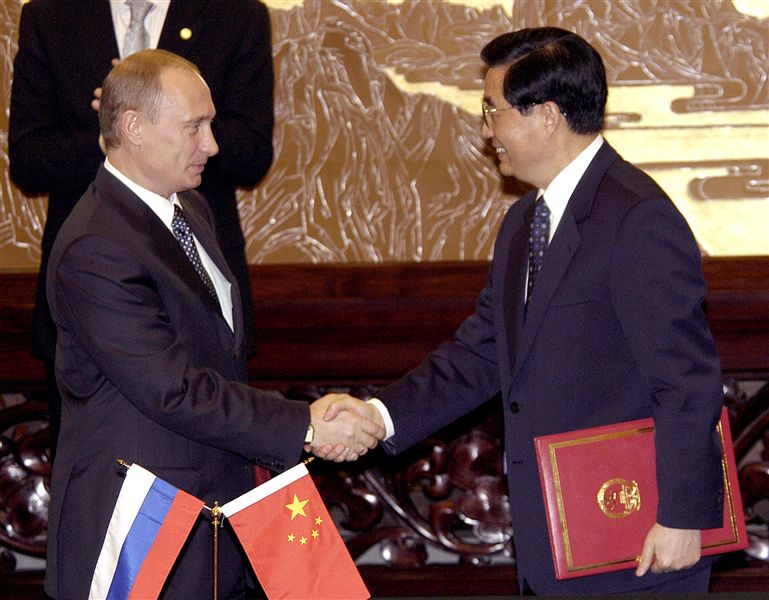
Except-for-2008-to-2012 Russian President Vladimir Putin, and then Chinese President, Hu Jintao, having “elevated” Sino-Russian relations in recent years to the level of “strategic partnership”, in other words to an OVERT military and strategic alliance, sorting out once and for all their “border hostilities” of the past – exactly as Anatoliy Golitsyn had warned that the scissors strategy would give way, at the end of the final phase of the communist long-range strategy, to a highly uncomfortable “one-clenched-fist”-blackmail-policy against the West. Indeed, the world has now reached exactly there! – Quite symbolically, the People’s Republic of China declared 2006 the “Year of Russia”, and in return the Russian Federation 2007 the “Year of China”.
At that point the shift in the political and military balance would be plain for all to see. Convergence would not be between two equal parties, but would be on terms dictated by the communist bloc. The argument for accommodation with the overwhelming strength of communism would be virtually unanswerable. Pressures would build up for changes in the American political and economic system on the lines indicated in Sakharov’s treatise. Traditional conservatives would be isolated and driven toward extremism. They might become the victims of a new McCarthyism of the left. The Soviet dissidents who are now extolled as heroes of the resistance to Soviet communism would play an active part in arguing for convergence. Their present supporters would be confronted with a choice of forsaking their idols or acknowledging the legitimacy of the new Soviet regime.
The Worldwide Communist Federation:
Integration of the communist bloc would follow the lines envisaged by Lenin when the Third Communist International was founded. That is to say, the Soviet Union and China would not absorb one another or other communist states. All the countries of the European and Asiatic communist zones, together with new communist states in Europe and the Third World, would join a supranational economic and political communist federation. Soviet-Albanian, Soviet-Yugoslav, and Soviet-Romanian disputes and differences would be resolved in the wake, or possibly in advance of, Sino-Soviet reconciliation. The political, economic, military, diplomatic, and ideological cooperation between all the communist states, at present partially concealed, would become clearly visible. There might even be public acknowledgement that the splits and disputes were long-term disinformation operations that had successfully deceived the “imperialist” powers. The effect on Western morale can be imagined.
In the new worldwide communist federation the present different brands of communism would disappear, to be replaced by a uniform, rigorous brand of Leninism. The process would be painful. Concession made in the name of economic and political reform would be withdrawn. Religious and intellectual dissent would be suppressed. Nationalism and all other forms of genuine opposition would be crushed. Those who had taken advantage of détente to establish friendly Western contacts would be rebuked or persecuted like those Soviet officers who worked with the allies during the Second World War. In new communist states – for example, in France, Italy, and the Third World – the “alienated classes” would be reeducated. Show trials of “imperialist agents” would be staged. Action would be taken against nationalist and social democratic leaders, party activists, former civil servants, officers, and priests. The last vestiges of private enterprise and ownership would be obliterated. Nationalization of industry, finance, and agriculture would be completed. In fact, all the totalitarian features familiar from the early stages of the Soviet revolution and the postwar Stalinist years in Eastern Europe might be expected to reappear, especially in those countries newly won for communism. Unchallenged and unchallengeable, a true communist monolith would dominate the world.
3. EXCERPTS FROM ANATOLIY GOLITSYN’S SECOND BOOK OF 1995, “THE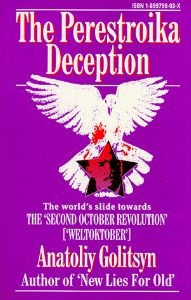 PERESTROIKA DECEPTION: THE WORLD’S SLIDE TOWARDS THE SECOND OCTOBER REVOLUTION”; Edward Harle Ltd., London – New York 1995
PERESTROIKA DECEPTION: THE WORLD’S SLIDE TOWARDS THE SECOND OCTOBER REVOLUTION”; Edward Harle Ltd., London – New York 1995
(A complete and authentic scanned-in PDF-copy of the book is available, for free, here; or go to amazon.com and try and order it there.)
FOREWORD BY THE AUTHOR
This collection of my Memoranda to the Central Intelligence Agency is about Soviet grand strategy and the new dimensions of the threat to the Western democracies.
There is a marked difference between the American and the Communist use of the term ‘strategy’. Americans tend to think of strategy in short-range terms in relation to presidential election campaigns, in football or baseball games or in such instances as the ‘strategy of stone-walling’ during the Watergate investigations. For Russian Communists on the other hand, strategy is a grand design or general Party line which governs the Party’s actions over a long period and contains one or more special manouevres designed to help the Party achieve its ultimate objectives – the seizure of power in Russia in 1917, the subsequent expansion of the Communist camp and the final world-wide victory of Communism.
This book shows that the essence of the special manoeuvre in the present grand strategy for Communism lies, internally, in the creation and use of controlled ‘political opposition’ to effect a transition to new ‘democratic’, ‘non-Communist’, ‘nationalist’ power structures which remain in reality Communist-controlled. Internationally, the essence of the manoeuvre lies in the use of the political potential of these new power structures to develop contacts and promote solidarity with the Western democracies as a means towards the achievement of world Communist victory through the convergence of the Communist and non-Communist systems.
The main purpose of my defection at the end of 1961 was (a) to warn the American Government about the adoption of the current grand strategy for Communism and the political role of the KGB and the use of disinformation and controlled political opposition which the strategy entailed, and (b) to help the West neutralise KGB penetration of their governments.
On arrival in Washington, I asked to be received by President Kennedy. I was assured by General Taylor, the President’s security adviser, that the President would see my appropriate contributions. Mr. Robert Kennedy, the Attorney General, told me that in due time a meeting with the President would be arranged.
General Taylor wrote to me in the following terms:
The White House Washington, 21 December 1961
Dear Mr. Golitsyn,
I have your letter of December 19, 1961, addressed to the President of the United States. The subject matter is one of considerable interest to this government and your request has received careful consideration.
I wish to assure you that the officials with whom you are now in contact have the full authority and responsibility for handling matters of this nature, and I therefore request that you give them your complete cooperation.
I have asked that I be kept informed of developments in this matter, and you may be confident that information concerning your contribution will be brought to the attention of the President if and when appropriate.
Maxwell D. Taylor
While waiting for the meeting, I limited my cooperation with the CIA, FBI and allied services to the problems of KGB penetration of the American, British and French governmental institutions. After President Kennedy’s assassination, I briefed the head of the CIA [till April 28, 1965: John McCone] and the head of that agency’s counterintelligence staff [till December 24, 1975: James Jesus Angleton] about Communist long-range strategy, the creation of the disinformation department and [then KGB chief] Shelepin’s reorganisation of the KGB into a political arm of the Party.
On many subsequent occasions, I had opportunities to brief other leading Western services on the subject of Soviet long-range strategy and the new role of the KGB, recommending a reassessment of the Communist problem. A few counterintelligence officials in the CIA and the British and French services began to understand and accept the validity of my views. For me, the most encouraging development was the understanding I received from Count de Marenches, the Chief of the French intelligence service under the late President Pompidou. Count de Marenches provided me with opportunities to work with his service on the reassessment of Communist developments in terms of Soviet strategy. In the presence of a dozen senior officials of his service, Count de Marenches stated that he was in agreement with my views on the existence of the strategy and of disinformation but I was unable to explain my ideas in detail because my project with his service was terminated.
This growing awareness about disinformation and the political role of the KGB in implementing the strategy was interrupted by the Watergate hearings (which weakened the American services) and by the unfortunate death of President Pompidou (which weakened the position of the French service).
Despite adverse circumstances, I have made a consistent attempt to analyse important developments in the USSR and other Communist countries through the prism of Communist long-range strategy, strategic disinformation and the political role of the KGB. I continued to submit my Memoranda to the CIA about significant Communist developments and made suggestions on how to improve the Agency’s understanding of Communist strategy.
In 1984, I published a book, ‘New Lies for Old’, about Communist strategic political disinformation. In the book and in my Memoranda, I made several significant predictions about future developments in the Communist world. I predicted that the Communist strategists would go beyond Marx and Lenin and would introduce economic and political reforms in the USSR and Eastern Europe. I predicted the legalisation of Solidarity in Poland, the return to ‘democratisation’ in Czechoslovakia and the removal of the Berlin Wall. I warned about a political offensive to promote a neutral socialist Europe which would work to Soviet advantage. I also warned that the West was acutely vulnerable to the coming major shift in Communist tactics.
It is axiomatic that political ideas should be tested out in practice. And it is a fact that many of my predictions, particularly about the coming economic and political reforms in the USSR and Eastern Europe, passed the test and were confirmed by subsequent events, particularly in Poland and Czechoslovakia.
It remains also a fact that leading Soviet experts like Mr Zbigniew Brzezinski failed to make accurate predictions about these developments. This failure on the part of Mr Brzezinski and other experts in Washington was noticed by an ‘independent observer’ in ‘The New York Times’ of 12 September 1989.
Since then, I have submitted new Memoranda to the CIA and American policymakers in which I explained Soviet grand strategy and its strategic designs against the West, the essence of ‘perestroika’ (the final phase of the strategy), the new use of the Bloc’s political and security potential for introducing new deceptive controlled ‘democratic’, ‘nationalist’ and ‘non-Communist’ structures in the Communist countries, and the deployment of the political and security potential of the renewed ‘democratic’ regimes for the execution of the strategic design against the West.
In the Memoranda, I provided seven keys for understanding ‘perestroika’, explained the danger of Western support for it and proposed a reassessment of the situation and a re-thinking of that support as priority items of business. I suggested also how the West should respond to the challenge of ‘perestroika’ and its destabilising effect on the Western democracies.
Since the Central Intelligence Agency did not react to my Memoranda, I decided to publish them and asked the CIA to declassify them for the purpose. The Agency agreed. Several considerations forced me to take my decision.
First, the democracies of the United States and Western Europe are facing a dangerous situation and are vulnerable because their governments, the Vatican, the elite, the media, the industrialists, the financiers, the trade unions and, most important, the general public are blind to the dangers of the strategy of ‘perestroika’ and have failed to perceive the deployment of the Communist political potential of the renewed ‘democratic’ regimes against the West. The democracies could perish unless they are informed about the aggressive design of ‘perestroika’ against them.
Secondly, I could not imagine that American policymakers, and particularly the conservatives in both the Republican and Democratic parties, despite their long experience with Communist treachery, would not be able to grasp the new manoeuvres of the Communist strategists and would rush to commit the West to helping ‘perestroika’ which is so contrary to their interests.
It has been sad to observe the jubilation of American and West European conservatives who have been cheering ‘perestroika’ without realising that it is intended to bring about their own political and physcial demise. Liberal support for ‘perestroika’ is understandable, but conservative support came as a surprise to me.
Thirdly, I was appalled that ‘perestroika’ was embraced and supported by the United States without any serious debate on the subject.
In the fourth place, I am appalled by the failure of American scholars to point out the relevance of Lenin’s New Economic Policy to understanding the aggressive, anti-Western design of ‘perestroika’ or to provide appropriate warning to policymakers, and their failure to distinguish between America’s true friends and its Leninist foes precisely because these foes are wearing the new ‘democratic’ uniform. Given the pressures they face, policymakers have no time to study the history of the period of Lenin’s New Economic Policy, or to remind themselves of Marxist-Leninist dialectics.
But how could such learned and distinguished scholars as S. Bilar and Z. Brzezinski have failed to warn them about the successes of the New Economic Policy, the mistakes made by the West in accepting it and Gorbachev’s repetition of Lenin’s strategy and its dangers for the West? What happened to their credentials as great scholars? Why was it left to Professor Norman Stone of Oxford University to detect and make the parallel in his article in the London ‘Daily Telegraph’ of 11th November 1989, and to express concern at the euphoria over Gorbachev? In his book, ‘The Grand Failure’, Brzezinski limited his description of Lenin’s New Economic Policy to three brief phases. He described the New Economic Policy as amounting to a reliance on the market mechanism and private initiative to stimulate economic recovery. In his words, it was probably ‘the most open and intellectually innovative phase’ in Soviet history.
For Brzezinski, the NEP is ‘a shorthand term for a period of experimentation, flexibility and moderation’ [see ‘The Grand Failure’, Charles Scribner and Sons, New York 1989, pages 18-19]. I am appalled by Brzezinski’s failure to explain the relevance of Lenin’s New Economic Policy to ‘perestroika’.
This failure is further illustrated by the following:
(a) S. Bialer, a former defector from the Central Committee apparatus of the Polish Communist Party, wrote a foreword to Gorbachev’s book, ‘Perestroika’, introducing it to the US public without inserting any warning about the parallel with the New Economic Policy and its dangers for the Western democracies.
(b) During his recent visit to Moscow, Z. Brzezinski, the former National Security Adviser in the Carter Administration, met leading Soviet strategists including Yakovlev, an expert on the manipulation of the Western media, and advised them on how to proceed with ‘perestroika’. Furthermore, Brzezinski delivered a lecture on the same subject to the Soviet diplomats at the High Diplomatic Academy!
In the fifth place, I am disappointed that Gordievsky, a recent KGB defector, did not help much to explain ‘perestroika’ as the final phase of Soviet long-range strategy, to describe its essence or to point out the deceptive nature of the changes and the strategic danger for the West. Gordievsky’s articles in ‘The Times’ of London of 27-28 February and 1 March 1990, contained a rather optimistic, if not laudatory, description of the ‘reforms’ initiated under Gorbachev and Yakovlev. I am puzzled that he should write so enthusiastically about them in the London ‘Times’. He might as well have published his comments in the Party newspaper ‘Pravda’ or in Korotich’s ‘Ogonek’. His assessment of ‘perestroika’ and its meaning for the West is in complete contradiction to that set out in my Memoranda to the Central Intelligence Agency. Further comment would be superfluous. I leave it to the reader to make his own judgment.
In the sixth place, misguided Western support for ‘perestroika’ at all levels, and especially among the Western media, is destabilising Western societies, their defence, their political processes and their alliances. It is immensely accelerating the successful execution of the Soviet strategic design against the West. In 1984 I thought that, in the event of Western resistance to Soviet strategy, the scenario of convergence between between the two systems might take the next half century [see New Lies for Old, pages 365-6].
Now, however, because the West has committed itself to the support of ‘perestroika’ and because of the impact of the misguided and euphoric support for it in the Western media, convergence might take less than a decade. The sword of Damocles is hanging over the Western democracies, yet they are oblivious to it. I believe in truth and the power of ideas to convey the truth.
Therefore, I present my Memoranda to the public – convinced that they will help them to see the ‘perestroika’ changes, and their sequels, in the Communist world and beyond, in a more realistic light, and to recover from their blindness.
Anatoliy Golitsyn, United States, 1995
FOREWORD BY THE EDITOR [i.e. Christopher Edward Harle Story (1938 – 2010), political analyst and head of the London publishing firm Edward Harle Ltd., who himself was to come forth in 2002 with the reference work The European Union Collective: Enemy of its Member States – A Study in Russian and German Strategy to Complete Lenin’s World Revolution; Edward Harle Ltd, London – New York 2002; photograph below from a 2003 video-interview Mr. Story gave to Mr. William McIlhaney, United States – the video can be viewed online on various Youtube channels – in which the two gentlemen discussed, for the second time, the Perestroika deception and its fatal implications for the Free World.)
In July 1991, I was asked by the former British Prime Minister, Mrs (now Lady) Thatcher, to see her at her room in the Palace of Westminster. The subject to be discussed was the network of bilateral treaties, declarations and accords which the Soviet Union had been signing with leading Western countries. By then, the list of such signatories already included Germany, France and Italy, while a treaty had been negotiated between the USSR and Spain, and a Political Declaration had been signed inter alia by the Soviet Union and Finland. Germany had in fact signed two bilateral treaties with Moscow. I had carried out a preliminary analysis of these treaties and accords, and had published translations of the texts, and some early findings, in several documents issued by my serials publishing firm in London, placing the treaties in the context of the implications of the Joint Declaration of Twenty-Two States and the Charter of Paris which Mrs Thatcher had signed on 19th November 1990 amid the disruption and anxieties surrounding the challenge to her leadership.
At the meeting, the former Prime Minister expressed great interest in the texts of the treaties and in my explanation of their significance. After admitting that her officials had not, during her final weeks in office, informed her about them, our conversation broadened to include my developing assessment of Soviet strategy in general, and the Soviet agenda for Europe, in particular. When I had finished explaining, as best I could, that Soviet behaviour and what I understood of Moscow’s strategy bore familiar Leninist dialectical hallmarks, Mrs Thatcher remarked: ‘I don’t think Gorbachev is a Leninist any more’. Later in the interview, after she had become aware of my acquaintance with Anatoliy Golitsyn’s work ‘New Lies for Old’, and after hinting that she did not share Golitsyn’s analysis, the former Prime Minister pronounced: ‘I don’t think we have been deceived – at least, I hope we haven’t’.
These remarks have haunted me ever since. Obviously, the qualifying afterthought had revealed that the Prime Minister whose action in opening the door ajar had enabled the Soviets to thrust it wide open for the purpose of exporting their insidious ‘perestroika’ deception to the West, had retained a niggling doubt that the West might indeed have fallen victim to Soviet strategic deception. That she was prepared even to admit such a doubt is a tribute to her inherent intellectual integrity and strength of character. It is more than can be said for most of the West’s leaders today, who have evidently allowed Gorbachev and his successors and collaborators to ‘restructure’ their minds, in accordance with the true meaning of ‘perestroika’ – the ‘restructuring’ not of the Soviet system, but of the outlook, thinking and mentality of the West. For Stalin, ‘perestroika’ meant ‘re-shoeing’ – as of a horse: that is to say, not of the regime itself, but of the system’s means to consolidate its power.
Greatly though Lady Thatcher is to be admired, it is unfortunately the case that she was never the best judge of character. Reviewing the former Prime Minister’s book ‘The Downing Street Years’ in ‘The New York Times’ Book Review section on 14th November 1993, Dr Henry Kissinger drew attention to the passage in which the former Prime Minister described her reaction on meeting Gorbachev for the first time: ‘If at this time I had paid attention only to the content of Mr Gorbachev’s remarks – largely the standard Marxist line – I would have to conclude that he was cast in the usual Communist mould. But his personality could not have been more different from the wooden ventriloquism of the average Soviet apparatchik. He smiled, laughed, used his hands for emphasis, modulated his voice, followed an argument through and was a sharp debater… His line was no different from what I would have expected. His style was. As the day wore on I came to understand that it was the style far more than the Marxist rhetoric which expressed the substance of the personality beneath’. In this passage, as Dr Kissinger had evidently realised, Lady Thatcher had admitted that she had been beguiled by Gorbachev’s style. As he cast his spell, Gorbachev unlocked the key to the control of the Western mind – and to the ‘restructuring’ of the entire world. The West followed Lady Thatcher’s prompting, mistaking the style for the substance. The disastrous consequences of this millennial error are now crowding in upon Western civilisation, threatening its very survival.
Ambition to control the Western mind is a long-standing objective of Soviet policy, embracing the ideas of the Italian Communist Antonio Gramsci, who argued that mastery of human consciousness should be a paramount political objective. As Richard Pipes has pointed out [in ‘Survival is Not Enough’, Simon and Schuster, New York, 1984, page 80], ‘such mastery is secured, in the first place, by control of the mind that absorbs and processes the information – and the best way of accomplishing this is by shaping words and phrases in the desired manner’. Moreover control of the Western mind is to be achieved not only by means of the dishonest use of language, but also through operations to demoralise the West – through corrosive attacks on society’s institutions, the active promotion of drug abuse, and the spread of agnosticism, nihilism, permissiveness and concerted attacks on the family in order to destabilise society. Religion and the traditional cultural and moral hegemony must first be destroyed, before the revolution can be successful – a message stated unequivocally by the American activist Ellen Willis, who has written that ‘feminism is not just an issue or a group of issues; it is the cutting edge of a revolution in cultural or moral values… The objective of every feminist reform, from legal abortion to child-care programs, is to undermine traditional family values’ [see ‘The Nation’, New York, 14 November 1981, pages 494-5]. The still unproven assumption of the strategists is that with Western society ‘deconstructed’, its leaders will meekly accept and cooperate with the Soviet plan for a ‘New World Social Order’, or World Government.
In this context, it is interesting to recall that the spy George Blake told Kenneth de Courcy in the early 1960s that ‘individual choice would eventually be mastered by a central Soviet control of thought process’ [’Traitors: The Labyrinths of Treason’ by Chapman Pincher, Sidgwick & Jackson, London, 1987, page 157]. The primary objective of ‘perestroika’, then, is to restructure the Western mind using both deceptive language and the ideas of Gramsci so that it becomes more receptive to, and more inclined to collaborate with, the implementation of Soviet global strategic objectives. As one of the leading strategists, Georgi Arbatov, made clear in his book ‘The System’ [Random House, New York, 1992, page 211], the ideas of Gramsci and other Marxists, whose work seeks to ‘restructure’ the Western mentality and to promote decadent lifestyles, had been consciously incorporated into the ‘New Thinking’: ‘I do respect quite a few Marxist works and ideas. I include not only the “founding fathers” of Marxism but also outstanding leaders of the Socialist International, as well as people like Antonio Gramsci, György Lukacs, Ernst Bloch and Herbert Marcuse’. The importance of Gramsci’s ideas as an element of Gorbachev’s ‘New [Leninist] Thinking’ was further confirmed in the Soviet literature towards the end of the domestic ‘perestroika’ period. Thus the June 1990 issue of Sputnik’, published by Novosti in Moscow, stated that ‘modern world [sic] culture is inconceivable without a consideration of the contributions made by influential Western Marxist philosophers G Lukacs [and] A Gramsci…’.
‘The Perestroika Deception’ reveals how the largely unseen Soviet collective leadership, borrowing the mind-control ideas of Gramsci, implemented their long-prepared shift from Lenin’s ‘dictatorship of the proletariat’ to his ‘state of the whole people’, the primary characteristic of which is a theatrical display of ‘democratism’ designed to convince the West that a decisive ‘Break with the Past’ has taken place, in order to encourage Western Governments to abandon caution and to embark upon an open-ended programme of collaboration with the ‘former’ Soviet Bloc. Implicit in such collaboration is the threat of a ‘return to the Cold War’ – or worse – if the West does not cooperate. The equation can be summed up as ‘cooperation-blackmail’.
In the 1960s, the strategists had established specialist Institutes under the control of the USSR Academy of Sciences. These were instructed to study Western attitudes and to inform the leadership of likely Western reactions to given tactical manoeuvres or scenarios. As the strategists had anticipated as a result of these studies, the West was caught off guard and enticed by the ‘Break with the Past’. Indeed it was enthusiastic since, as Anatoliy Golitsyn explains, a deception, to be successful, must match the known aspirations of the target as closely as possible. Thus the West interpreted the cosmetic changes as a deepening of the process of Soviet ‘reform’, offering fresh opportunities for policy and trade. In reality the West faced an ‘acceleration in the unfolding of Soviet convergence strategy which is intended to procure the subservience of the West to Moscow under an ultimate Communist World Government’.
Like the works of Sun Tzu, Machiavelli and Clausewitz, this work is devoted to explaining strategy. Unlike the works of those classic authors, however, ‘The Perestroika Deception’ deals with the contemporary world, explaining how Russia and China adopted the attitudes and ideas of these thinkers and have applied them globally for a generation. They seek the irreversible ‘restructuring’ of Western thinking, responses and society itself, as their price for ‘no war’ and for ‘changes’ which the West has accepted as genuine, and liable to lead to the normalisation of ‘post’-Communist society accompanied by the abandonment of revolutionary objectives.
‘The Perestroika Deception’ is unique in the literature on the Communist and ‘former’ Communist states in that it addresses the unbroken continuity and implementation of the ‘convergence’ strategy, a grand overall design – or what the Soviet Leninists call ‘the general line’ – since it was decided upon in 1958-60. As the Author explains on page 51, ‘the general line’ – which is flexible as to timing, contains a variety of options and takes full account of risks and possible losses – guides the course of the Party’s actions over a period of twenty to thirty years in pursuit of its unchanging Communist objectives. ‘The feature of strategy which distinguishes it from policy is that it contains within itself a secret, concealed or deceptive manouevre, designed to take the adversary by surprise and thus secure victory for the strategy’. ‘One can’, as Arbatov explains in ‘The System’, ‘trace most clearly a direct continuity between the ideas of the Twentieth Party Congress, détente, and the New Political Thinking’. Indeed, one can; and for the elimination of all doubt, further confirmation of ‘post’-Communist adherence to the strategy of deceptive ‘convergence’ with the West has been helpfully provided by Viktor Chernomyrdin. Speaking on the ‘Russia’ TV Channel [Moscow, 2030 GMT, 15 December 1992], the newly appointed Russian Premier reaffirmed ‘the general line’, asserting the inherent flexibility of the strategy without, of course, revealing its content: ‘My colleagues in the Government who are working today will pursue this line. The planned line. The one which has been worked out… Life makes amendments to our programme, additions, perhaps, changes. But we will keep to the basic line.’
Behind the impressive smokescreen of pseudo-democracy, pseudo-capitalism and pseudo-reform, this Russian-Chinese ‘cooperation-blackmail’ strategy is irreconcilably hostile to the West. Again, this is no mere presumption. It was explicitly confirmed in May 1994 to Clark Bowers, a member of an official US Republican delegation to Peking, by Mr Mo Xiusong, Vice Chairman of the Chinese Communist Party, who is believed to be the highest-ranking Chinese Communist official ever to have answered questions put to him by a knowledgeable Western expert on Communism:
Bowers: Is the long-term aim of the Chinese Communist Party still world Communism?
Mo Xiusong: Yes, of course. That is the reason we exist.
Illuminating the cooperation-blackmail ‘convergence’ strategy with his first-hand experience of the origination of the strategy and his knowledge of how Moscow applies the dialectical political method of Marx, Hegel and Lenin in practice, Golitsyn challenges the fashionable, and increasingly laughable, Western assumptions that the West ‘won the Cold War’, that the enemy ‘disappeared’, that ‘Communism is dead’, that the Soviet Union ‘collapsed’ and that Russia has embarked upon ‘progress towards democracy’ (never actually reaching it) – patiently showing that because the West fell for the ‘perestroika’ deception, it has failed to connect its present malaise to the impact of Soviet-Chinese strategy, and is unable to see the threat arising from the hostile Sino-Russian axis to which countries like North Korea, Iran and Iraq adhere.
In his book ‘Wedge: The Secret War between the FBI and CIA’ [Alfred A Knopf, New York, 1994], Mark Riebling pays tribute to the remarkable predictive record of the Author’s famous earlier work, ‘New Lies for Old’, crediting Golitsyn with ‘an accuracy record of nearly 94%’ [page 408]. Because this record validates the ‘secret, concealed or deceptive manoeuvre’ within the strategy of ‘convergence’, all manner of attempts have been made to discredit the Author and the late James Jesus Angleton, who understood the significance of his analysis. For instance, Riebling himself observes that ‘British journalist Tom Mangold even went so far as to say, in 1990 – after Golitsyn’s prescience had become clear – that “As a crystal-ball gazer, Golitsyn has been unimpressive”. Mangold reached this conclusion by listing six of Golitsyn’s apparently incorrect predictions and ignoring the 139 correct ones’.
Counting the Author’s accurate predictions and awarding him a 94% accuracy rating has certainly been helpful in ‘rehabilitating’ the Author at a time when the process of achieving control over the Western mindset has reached an advanced stage. But in one sense, this overdue accolade misses the whole point of the Author’s work. For it is not even necessary to enumerate Golitsyn’s accurate predictions, to recognise that he is revealing the truth. All that is required is an understanding that the ‘general line’ provides the necessary dialectical framework without which the otherwise incomprehensible behaviour of the ‘post’-Communists cannot be understood. Once the Western observer has grasped the continuity of Leninist strategy, he possesses the key to interpreting and predicting events correctly. Put another way, it will be found that, as a reward for studying the dialectical nature and continuity of the ‘general line’, the open-minded sceptic becomes potentially capable of achieving a predictive record as impressive as the Author’s.
Why, then, is it that, despite Golitsyn’s service at the heart of the KGB in Moscow when the strategy was first adopted; despite his proven track record of providing accurate, verifiable information to the West since his arrival at the end of 1961; despite his 94% predictive accuracy rating; and despite his obvious integrity (as I know from my personal experience of editing this work and responding to his patient, constructive and transparently honest criticisms of my own inadequate understanding of the strategy); why is it that his warnings have been overlooked by Western policymakers?
The first main reason for the general (but not in fact complete) rejection of the Author’s analysis is that, as the case of Aldrich Hazen Ames has shown, the Russians won the intelligence war through their penetration of Western intelligence services – a message which, naturally, these services do not wish to hear [see Author’s Note 80, page 219]. In the course of his work with the American, British and French services, the Author found that penetration had destroyed their ability to interpret events in the Communist world correctly. Since 1969, the West has lacked the necessary genuine secret intelligence to expose the deception buried within the strategy, let alone the existence of the long-range Russian-Chinese ‘general line’ itself; so policymakers have not been provided with the appropriate correctives to fashionable and conventional diplomatic and journalistic perceptions.
A second factor appears to be an extraordinary reluctance among some analysts to study the available documents. Again from personal experience as Editor and Publisher of Soviet Analyst, I can confirm that it is possible for even a private student to identify the existence, outline, characteristics, elaborations and continuity of the strategy from sources such as successive issues of the Russian Foreign Ministry’s journal ‘International Affairs’, from a study of Soviet and ‘post’-Communist official documents and statements in the public domain, and from articles by known agents of influence and implementers of the strategy in the Western press and specialist journals. Is such study too boring or too much like hard work? The strategists are in little doubt that private study can indeed lead to enlightenment. ‘The dangers lie,’ said President Gorbachev at a press conference with President Mitterand on 6 May 1991, ‘in the fact that someone, analysing at some private moment or other, this or that instance or episode, or even event, including a dramatic event, should not make hasty conclusions and cast doubt on all that has been acquired, and what we have created in putting international relations onto new channels, onto new rails [sic], entering, as all of us have said, a period of peaceful developments’. Note that, in addition to his expression of anxiety that ‘someone, analysing at some private moment or other’ would indeed succeed in obtaining independent corroboration of the essence of the deception strategy, Gorbachev also predicted here the forthcoming fake ‘August coup’ [‘a dramatic event’] and warned that collaboration with the West meant that only one direction was to be permitted in constructing the ‘New World Social Order’ [‘new rails’]. As a lifelong disciple of Lenin, who taught his followers the creative use of language for deception purposes, Gorbachev chose his words with characteristic care. He could have said ‘new road’ instead of ‘new rails’ ; but a train travelling along a railway line can proceed in only one direction – in this context, that intended by the strategists.
A third general reason for the lack of interest in the Author’s accurate analysis is the familiar one that the horizons of Western politicians are usually limited to the forthcoming general election. One consequence of this is that they find it hard to understand that Communist and ‘former’ Communist systems are capable of evolving strategies which remain valid, with tactical adjustments, over many decades. Likewise, many Western analysts and observers tend to focus obsessively on the behaviour and fortune of particular individuals – Gorbachev, Yeltsin, Kozyrev, Rutskoi, Yavlinski, Shevardnadze, or whoever – as though each was a personally motivated careerist, like Western politicians jockeying for power and influence. This overlooks the fact that all such characters – each of whom emerged from the security services, Komsomol and other controlled structures – are bound together as collaborators in the pursuit of the commons strategy. The ‘democratism’ display is deliberately intended to obscure this.
An exception to the rule was President Pompidou of France. Unlike his towering predecessor, de Gaulle – who was taken in by deception, cancelled France’s military commitments to NATO and embraced the Soviet concept of ‘Europe from the Atlantic to the Urals’ – President Pompidou accepted strategic political disinformation and the influence of Sun Tzu as realities. Unfortunately [see pages 168, 177 and 181] he did not survive long enough to make his influence felt in France and elsewhere.
A fourth reason, touched upon earlier, for the shameful neglect of the Author’s analysis, is that it is often difficult for an intelligence service to persuade its political masters that they are being deceived. Obviously, it is also contrary to the interests of the services generally to admit that they themselves have been misled.
In the fifth place, it has to be repeated that, over the years, a partially successful diversion campaign has been mounted to discredit both Angleton and Golitsyn. By contrast, no comparable sustained attempt seems to have been made to detract from the work of other prominent defectors – suggesting that the strategists have good reasons for helping the West to continue rejecting Golitsyn’s findings, even though he has a predictive record of such distinction that he puts everyone else to shame.
Finally, the Western media routinely publicise the views and interpretations of agents of influence, both journalists and experts, thereby adding successive layers of confusion which blur the perceptions of analysts and especially of politicians – who are usually reluctant to absorb information which does not correspond with their understanding of the current fashion, or of the opinions of their often misinformed colleagues. Politicians confer mainly among themselves, and with officials who feed them the ‘accepted line’. It is therefore particularly hard for them to find ‘some private moment or other’ in which the ‘general line’ might be revealed and confusion dispelled. This book is intended to assist them, and many others, in that urgent task.
Christopher Story, London, May 1995
KEY PASSAGES FROM ‘THE PERESTROIKA DECEPTION’ – (Memoranda to the CIA)
August 1985
The Danger for the West: An Assessment of the Rise of Mikhail Gorbachev, the Role of ‘Liberalisation’ in Soviet Strategy, and its Grave Implications for the West
The speedy appointment of Mikhail Gorbachev as the Party leader confirms this analyst’s earlier conclusion about the cessation of power struggles in the Soviet leadership and the solution of the succession problem by the selection of the leader in advance by the Politburo.
Gorbachev was selected, coached and prepared for this appointment by the late Suslov and Andropov and by Ponomarev and Gromyko in the same way as Dubcek was chosen for the Czechoslovak leadership. Gorbachev’s speech and other indications confirm the Author’s earlier analysis about forthcoming Soviet ‘liberalisation’ which has been in preparation during the past two decades under Shelepin and Andropov. Gorbachev was selected as the ‘new generation representative’ because of his decisiveness, his demeanour and, above all, because he has been well groomed for implementing the ‘liberalisation strategy’. Another factor favouring his selection was his non-involvement in Stalin’s repression.
There are no valid grounds for favourable illusions or for the euphoria in the West over the Gorbachev appointment and the coming ‘liberalisation’. In fact, these developments may present a major challenge and a serious test for the United States’ leadership and for the West. The liberalisation will not be spontaneous nor will it be genuine. […] (page 188)
December 1985
Gorbachev has launched a political offensive: The need to expose ‘his’ strategy and covert operations
Somehow the Western media have an uncanny capacity to detect, expose and attack covert operations of the United States – but not those of the Soviet Union. […] (page 197)
l
March 1987
[…] The next strategic moves will include: a) Mass Jewish emigration intended to swing Western public opinion towards acceptance of ‘democratisation’ as genuine; b) The revival of ‘liberalisation’ in Poland and the introduction of economic reforms there; c) New initiatives around the time of the Pope’s visit to the USSR; d) An initiative leading towards German federation […] (page 10)
January 4, 1988
Communist Grand Strategies and Western Illusions: An Assessment of Gorbachev’s Visit to the United States in the Light of the Grand Soviet Deception Strategy
The main purpose of General Secretary Gorbachev’s visit to the United States in December, 1987 was not to prepare for a summit meeting or to reach an agreement on a reduction of nuclear missiles but to engage the American elite in the execution of Soviet strategy and to influence it in directions favourable to the strategy.
Since the strategy presents a threat to the long-term survival of the United States, there is an acute and pressing need for a new American counter-strategy and for a new concept of counter-intelligence. […] (page 50)
September 1988
Western Counter-Strategy Against ‘Perestroika’ – Past American Strategic Mistakes in Dealing with the Communist World
After the Second World War the United States made a strategic mistake in adopting the defensive policy of containment of Communism as advocated by Ambassador Kennan. This policy failed to take into account the depth of the crisis in the Communist system at that time, the prevailing revolutionary situation in the Communist countries and the overall strength of the American nation.
At that time, the United States enjoyed a position of superiority. An offensive strategy of support and liberation for the Communist satellites in revolt would have been more appropriate.
The bankruptcy of the strategy of containment was exposed by the uprisings in Hungary and Poland, when the United States missed an historic opportunity to free Eastern Europe from Soviet tyranny once and for all. […] (page 66)
Western Counter-Strategy against ‘Perestroika’
Improvisation should be replaced by an effective American counter-strategy against ‘perestroika’. How effective it will be depends upon how accurately the United States can assess the new situation in the USSR. Because Washington overestimated the strength and aggressiveness of the Communist camp in the immediate post-war period, the United States adopted an inadequate defensive strategy of containment. Now the risk is that the United States will underestimate the political strength and aggressiveness of the Communist camp and engage itself actively with Gorbachev and ‘perestroika’.
Meanwhile, American leaders and experts on the Soviet Union remain as confused as ever by Communist disinformation on internal Soviet developments. Soviet criticism of Brezhnev (under whom the Soviets achieved military superiority), the dismissal of Yeltsin on the eve of Gorbachev’s visit to Washington, the Ligachev affair, the enlistment of Soviet religious leaders for ‘perestroika’ and the demonstration by national minorities on the eve of President Reagan’s visit to Moscow, are all part of the deliberate stage-setting planned and organised by the Soviet strategists to encourage active American involvement in ‘perestroika’.
Provoking the national minorities into agitation represents a new category of Soviet covert operations in support of the strategy, with the provocations conducted jointly by the Party apparatus, the Komsomol, the KGB, the mass organisations, religious activists and others. Occasionally, evidence of forward planning is forthcoming from the Soviets themselves. For example, an Armenian economic adviser to Gorbachev on ‘perestroika’ recently let slip in talks with American Armenians in California that ‘the measures for solving the Armenian conflict were already in preparation in 1987 and I myself supported them’. These operations demonstrated that the USSR, far from falling apart, is using its totalitarian resources more actively and imaginatively for strategic purposes.
The sophistication of these operations contrasts sharply with the primitive ‘rent-a-crowd’ operations of the stagnant, repressive, Stalinist régime. By emphasising the alleged instability of Gorbachev’s position and the fragility of ‘perestroika’, the operations are designed to induce an American underestimate of Soviet political strength, to create a favourable climate for Gorbachev’s negotiations with American leaders and to entice them into adopting an ultimately suicidal policy of support for and engagement in ‘perestroika’.
Any US strategy of active engagement would be perilous folly. It should never be forgotten that the ultimate objective of Soviet strategy is not ‘perestroika’ in the USSR but the restructuring of the American political and economic systems including the ‘military-industrial complex’. It is this aggressive angle of Gorbachev’s ‘perestroika’ which American counter-strategy should address. […] (pages 68, 69)
March 1990
The Difficulties Faced by the Western Media in Covering ‘Perestroika’
The Western media are in a difficult and vulnerable situation. They have to cover the process of ‘perestroika’ in the Communist countries within a frame of reference wrongly defined for them both by the Communist strategists, who naturally do their best to ensure favourable coverage of ‘perestroika’ by the Western media, and by Western governments which mistakenly accept and support ‘perestroika’ as a process serving Western interests. Like Western governments and their intelligence services, the Western media lack reliable sources of information on the strategic intentions of Communist officials. Like their governments, the Western media have been caught unprepared by the advent of ‘perestroika’ and have no understanding of its origin, its motivation, its use of political and security potential or its anti-Western strategic design. All these factors contribute to the media’s uncritical and inaccurate coverage of the subject. […] (page 110)
September – November 1990
1 Exposing ‘Perestroika’ as the Strategy for a Second October World Socialist Revolution (‘Weltoktober’)
2 The New Pattern of Non-violent Revolution, Not by Communist Parties, Dictatorships, the Soviet Army and Violence but through False Reform, Influence and the Political Action of the Soviet Forces Engaged in Party-Controlled ‘Democratisation’ and the So-called Multi-party System in the USSR
3 The Paramount Role of Soviet Strategic Disinformation in the Successful Execution of the ‘Perestroika’ Strategy
It was not the Author’s intention to submit further political Memoranda to the CIA on Soviet affairs. But he found that he could not sit idly by and watch the United States and its political leaders being taken in by Soviet strategic disinformation and overwhelmed by their own wishful thinking about the evolution of the Soviet system. He therefore decided to make a further attempt to explain the real essence of ‘perestroika’, to expose its contradictions, to reveal its strategic design, to give warning of its potentially dangerous impact on the United States and to counteract the present simplistic and over-optimistic Western view of its significance. Sooner or later informed opinion in the Western democracies will comprehend the new dimensions of the Soviet threat and the pendulum of US policy will begin to swing back from its present confusion to a greater sense of reality. The Memorandum is submitted in the hope of accelerating the process. […] (page 120)
The Probable Outcome
Since the West does not comprehend the strategic design behind Soviet ‘democratisation’ and economic reform, it cannot foresee the probable impact of these changes on the West. The question to be addressed is not whether the changes are reversible or irreversible but what their meaning is for the West in the long run. Because of the basic differences between the Western and Soviet-style concepts of democracy and the market economy, Western attempts to educate Soviet and East European ‘instant democrats’ in true democracy and market economics are naïve and short-sighted.
Optimistic expectations of long-term Western dividends from Western support for ‘perestroika’ are doomed to disappointment. Present Soviet-Western cooperation is only temporary: the East-West alliance is only tactical. Soviet-style democracy is ‘cuckoo-egg democracy’. When the chick hatches, it will display its true antagonistic nature and seek to dominate the nest. Blind to Soviet strategy, the United States will find itself increasingly marginalised in world affairs. To paraphrase an expression used by Marx, the United States will be left stranded in isolation to contemplate its own destruction and demise.
The Soviet pattern of violent revolution and terror came to be understood and effectively resisted by the West. Unless the West can bring itself to understand the new, temporarily non-violent pattern, it is destined to suffer defeat. Had an improvised form of ‘perestroika’ been hastily introduced in the Soviet Union, it would have led to an anti-Communist and nationalist explosion and, conceivably, to true democracy and freedom. But the current ‘perestroika’ offensive has been launched by the Soviet strategists after thirty years of preparation and experiment: the risks have been calculated, and uncontrolled eruptions have been, and will continue to be, forestalled and suppressed.
Western support for the Communist leaders who are imposing ‘perestroika’ from above has extinguished any remaining possibility of it evolving spontaneously towards genuine democracy. When with Western help the Soviet strategists have overcome their deliberately exaggerated economic difficulties and can provide their population with an abundant supply of consumer goods, they will be able to demonstrate to the world the superiority [‘superiority’ under apostrophes] of the Soviet system. They will have successfully rebuilt, restructured and renewed their society.
At that point, they will turn on the ‘hated capitalist’ and a new holocaust will result. The new holocaust will be based on class, not race. Its principal victims will be the Western political, military, religious and managerial elites. (pages 132, 133)
April 1991
A Touch of Realism in Assessing the Struggle between Gorbachev’s Supporters, Yeltsin’s Supporters and Nationalists in the Soviet Republics
1. The ‘fighting’ between Gorbachev’s supporters, Yeltsin’s supporters and the nationalist ‘independent’ Republics’ supporters, is a deliberate attempt by the Soviets to create and develop three parallel political structures of power in the USSR. The first is the Communist ‘democratic’ structure; the second is the anti-democratic structure; and the third is the nationalist ‘independent’ Republic structure, both Communist and ‘anti‘-Communist. All three structures, however, are controlled, guided and coordinated by the Communist Party and by the Communists in the Republics.
Thus, all three structures have a good chance of succeeding. When they have succeeded, they will not give the credit to the West but will instead congratulate themselves on the formation of their new system which they will then try to introduce to the West as a model which the West should emulate.
2. Their new complex three-tier system will become politically stronger and more truly ‘democratic’ than the American system. Thus, it could become the foundation for the establishment of a World Government.
3. One can then expect that all the Soviets including the ‘democratic’ Communists led by Gorbachev or by another Leninist, the ‘democratic’ anti-Communists led by Yeltsin and the ‘nationalists’ of both the Communist and anti-Communist variety, may try to influence confused and naïve American politicians, Members of Congress and the American public to accept the following lines of convergence:
a) That Soviet society has been renewed and has ‘solved’ its political and economic problems (without any indication of how this has occurred being evident).
b) That the Soviet system has evolved into one which should serve as a model for the West, given such attractions as its free education and medical services.
4. The new strategy is designed in part to influence American society to demand similar changes in the American system. It will be argued that the American system is decadent, deeply in debt, ridden with crime, crippled by drugs and heavily burdened with the high cost of education and the higher cost of medical care.
The impact of this old-style propaganda on the American public may well be effective because of the alleged changes in the Soviet system described above. (page 136)
August 19, 1991
(Written as news of the ‘hardliners’’ coup was announced and delivered to the CIA on 20 August 1991)
Behind the Soviet Coup – Soviet Strategy and Its development: the main objectives of the coup
Who called the shots in the USSR before the ‘coup’ and who introduced the ‘reforms’? Gorbachev and his ‘liberals’?
NO, the Party and its strategists.
Who is calling the shots now and who proposed the coup to replace Gorbachev? The ‘hardliners’, the Minister of Defence and the Chief of the KGB?
NO, the Party and its strategists.
The ‘coup’ was proposed in accordance with the requirements of the Soviet strategy of convergence leading to eventual World Government. This strategy and its moves, like the present Soviet ‘coup’, can only be understood in the light of the theories of one of the principal Soviet agents of influence, namely Sakharov, and his timetable for convergence. According to Sakharov, during the first phase the Leninist realists (i.e. Gorbachev and other ‘liberals’) will expand and strengthen ‘democracy’ and economic reform in the USSR and other socialist countries.
As we know, this has already happened.
According to Sakharov, in the second phase the pressure exerted by the Soviet example and by the internal progressive forces would lead to the victory of the Leftist Reformist Wing (the Soviet term for American liberals) which would begin to implement a programme of collaboration and convergence with the USSR on a worldwide scale, entailing changes in the structure of ownership. According to Sakharov, this phase would include an expanded role for the intelligentsia and an attack on the forces of racism and militarism.
We had reached this phase before the war with Iraq. In the assessment of the Soviet strategists, the US victory over Iraq adversely affected the political balance in the United States. In their view, the victory weakened and demoralised the liberals (or Leftist Reformists) and strengthened the centrist and conservative forces and the US military. This disturbed Soviet plans to carry out their strategy of convergence.
They saw that their main political allies in achieving convergence with the United States had been weakened. Accordingly they engineered this strategic ‘coup’ to reverse and improve the political fortunes of their American allies. Seen in strategic terms, the main purpose of Gorbachev’s ‘dismissal’ is further to confuse American opinion and to alter the political landscape in the United States so as to accelerate the progress of the Soviet strategy and to put it back on the rails.
This strategy is a deliberate and coordinated walk towards ultimate victory by advancing first the left leg of action by ‘liberals’, then the right leg of action by ‘hardliners’ and then once more the left leg of action by ‘liberals’. The ‘dismissal’ of Gorbachev is temporary. In earlier Memoranda I predicted a calculated ‘resignation’ by Gorbachev and his eventual return to power.
The ‘coup’ confirms this prediction. According to my analysis, the ‘coup’ is aimed at intensifying American anxieties over the fate of Gorbachev and the other ‘liberals’ and ‘reformists’ in the USSR like Shevardnadze. When these concerns reach their peak, the Soviet strategists’ next move can be expected. They will return Gorbachev and other ‘liberals’ to power through a campaign of strikes and demonstrations organised by the Party.
As the Soviet strategists see it, Gorbachev’s return and the restructuring of the ‘reformists’ in the USSR will also strengthen the American liberals, revive their fortunes and help them win future elections – leading eventually to the convergence of the United States and the USSR. In short, Gorbachev’s return will be a repetition of the device of the suppression of Solidarity in Poland, followed by its victory.
The main purpose of the ‘coup’ is to reverse an unfavourable situation for potential Soviet allies in the United States and to create favourable conditions for the implementation of the convergence strategy. The second objective is to secure the non-violent creation of the new Soviet Federation of Republics. The third objective is to provide any potential adventurers there may be in the Soviet military with a lesson and thereby to eliminate any possibility of a genuine coup in the future. (pages 137, 138)
August 20, 1991
(Delivered to the CIA on 21 August 1991)
A Further Analysis of the Objectives of the Soviet ‘Coup’
The point has already been made that Gorbachev will be returned to power at the moment when it best serves the Soviet strategy of convergence. Depending on the circumstances prevailing at the appropriate time, he could be returned to power through an election, after a period of other activities.
His alleged removal from power and house arrest are deliberate devices to build up his popularity before such an election. Meanwhile one can expect that the Soviet strategists intend to replace him or add to his team another ace card, the ‘anti-Communist’ (but, like Gorbachev, protégé of Andropov) Boris Yeltsin, leader of the Russian Republic. As the Soviet strategists see it, Gorbachev has exhausted the influence he exerted on their behalf in the West. He was unable to extract more economic aid at the London Summit Meeting and his advice concerning a diplomatic solution to the conflict with Iraq was ignored by President Bush. It is the strategists’ belief that Boris Yeltsin will give greater credibility in the West to Soviet economic and political ‘reform’. He will be in a better position to exploit his influence to extract additional economic aid from the West and, in particular, to obtain from the West a commitment to a new Marshall Plan for Russia.
A Marshall Plan for Russia is one of the primary interim objectives of the Soviet strategists and one that Gorbachev failed to achieve. The strategists expect that Yeltsin will be able to exert greater influence in diplomatic, economic and political relationships and will receive more cooperation in the international arena particularly in the Middle East and at the United Nations. One can expect that the Soviet strategists will come forward with fresh initiatives combined with deliberate provocations and crises in order to enhance the role of the United Nations.
They will do this because they regard the United Nations as a stepping stone to a future World Government. The Soviet political game and the Soviets’ trickery in ‘manipulating’ politicians like Gorbachev and Yeltsin for Western public consumption demand more imagination and a better grasp of these machinations from the Bush Administration. For example, to proceed with the appointment of Mr Robert Strauss as the new Ambassador in Moscow is a great mistake because the appointment is being made at a time when the Soviet strategists are deliberately undermining the credit and prestige President Bush gained from his dealings with Gorbachev. They are undercutting the President in favour of their political allies – namely, the American liberals. Nowadays the situation is more serious than it was after the Second World War. President Truman woke up to the nature of Stalin’s mentality, his deeds and his intentions. The Bush Administration, by contrast, has no understanding of Soviet strategy and its ultimate, aggressive, strategic designs against the United States.
Given this situation and the Soviet ‘game plan’, the President, instead of appointing a politician/businessman like Robert Strauss as American Ambassador in Moscow, should consider appointing someone like Richard Helms or General Vernon Walters – that is to say, a professional man and an intelligence expert who might see through the Soviet game plan and help the Administration as General Bedell Smith helped President Truman in 1947. (pages 139, 140)
August 26, 1991
The Author’s Analysis of the Soviet Objectives of the Calculated Soviet ‘Coup’ and of Its Calculated ‘Failure’
According to my assessment, the Soviet ‘coup’ and its ’failure’ constituted a grandiose display of deception – a provocation. The ‘ineptitude’ of the participants in the ‘coup’ and the ‘failure’ of it were skilfully planned and executed. The main argument in support of this assessment is that the Soviet military, the KGB, the Party and leading media figures apparently had neither the skill to launch a successful coup nor the guts to crush resistance to it. This is news indeed!
Facing a real crisis in Hungary in 1956, the same forces displayed exceptional skill, knowhow and determination in crushing a genuine revolt. Knowledge of the Soviet mentality and of Moscow’s record of ruthless action has convinced this analyst that the Soviet military, the Party and the leaders of the media all have the skill, the will and the courage to crush genuine resistance and opposition. They did not display them on this occasion because the abortive ‘coup’ was carried out in accordance with Party instructions; and it was the Party and the Komsomol themselves which organised the alleged resistance to it.
The real participants both in the ‘coup’ and in the ‘failure’ were some 20,000 or more chosen Komsomol and Party members in Moscow with two or three tank divisions guided by their political commissars and a handful of dedicated Party officials and generals who sacrificed their prestige in the interests of the Party’s strategy and under the guidance of its strategists. The calculated nature of the ‘coup’ and its timing show that it was staged by the Russian, President Yeltsin, to save the essence of the Union at the time of transition to a new form of federation.
The abortive ‘coup’ and the ‘resistance’ to it were carefully calculated displays intended primarily for the West. This explains why Western media contacts with Moscow were not curtailed. On the contrary, the big guns of the Soviet media like Vitaliy Korotich and representatives of the Arbatov Institute were on hand both in Moscow and in the United States to ‘help’ the Western media with their interpretation of developments in the USSR. The episode shows how well Soviet strategists like Arbatov and his experts on the American media have mastered the art of projecting such displays for consumption by the American media, and throughout the West.
The Soviet strategists sought to underline for the West the dramatic ineptitude of the ‘coup’ and the spectacular courage and resistance displayed by the new ‘Russian democrats’ and their leader Yeltsin in ‘defending’ the Soviet Parliament – their symbolic equivalent of ‘The White House’. The main external objective of the display was to demonstrate to the West that Soviet democratisation is genuine, that it has the support of the people and that it is working. They want to convince the West that Western investment in the USSR will pay dividends.
They expect that the West will now respond with a new Marshall Plan which will bring Western technology flooding in to the Soviet Union, promoting joint ventures and stimulating a restructuring of the Soviet economy along the lines of the revival of the German and Japanese economies after the Second World War.
Internally, one objective is to influence the Soviet population towards acceptance of the new Party-controlled ‘democracy’ as a real power and to develop the strength and maturity of the new ‘democratic’ structure and the popularity of its leaders, especially Yeltsin. Another objective is to exploit this staged ‘coup’ in order to reorganise and ‘reform’ the Soviet bureaucracy, the military, the intelligence and counter-intelligence organisations and the diplomatic service, and to give them a new ‘democratic’ image.
The Soviet strategists realise that only with such a new image, implying a ‘Break with the past’ and severance from Communism, can these organisations be converted into effective weapons for convergence with their counterparts in the United States. A further internal objective is to emphasise the change in the system by means of the spectacular, televised but calculated removal of old Communist symbols like the monuments to Lenin and Dzerzhinskiy, and the red banners.
These changes do not represent a genuine and sincere repudiation of Soviet design and intentions to secure an eventual world victory. Although very spectacular, the changes are cosmetic. They demonstrate only that Arbatov and others know how to manipulate American and other Western media through the use of powerful symbols such as the dismantling of the Berlin Wall, the toppling of Lenin and Dzerzhinskiy statues and Yeltsin’s staged ‘defence’ of the Soviet ‘White House’.
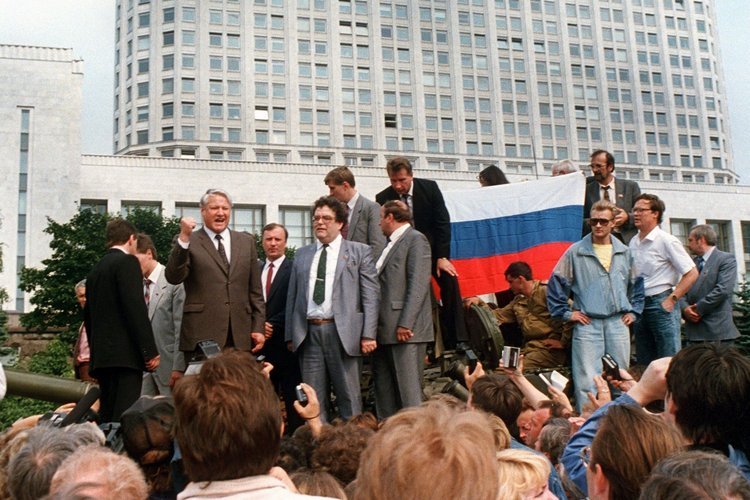
August 19, 1991: President of the RSFSR (Russian Soviet Federative Socialist Republic), Boris Yeltsin, on top of a tank in front of what then was the seat of the Supreme Soviet of the RSFSR, suddenly named “The White House”, playing his melodramatic part in the staged spectacle of “countering a coup attempt by old-style communists”. – Although the scene is far from convincing, the West also this time swallowed the lie.
If the Soviets were truly moving towards genuine democracy, and were intent on a true ‘Break with the Past’, these symbolic changes would be accompanied by the introduction and implementation of a de-communisation programme, the irrevocable (not cosmetic) prohibition of the Communist Party and Komsomol organisations at all levels throughout the USSR, and the removal of ‘former’ Party and Komsomol members from all the main seats of power including the KGB, the Soviet army and its political commissar administration, the Ministries, especially those for the Interior and Foreign Affairs, and the trade unions.
Yeltsin has allegedly banned the Communist Party in Russia. But the question should be asked: ‘Why did he forget to ban the Komsomol youth organisation?’ (Note by Author, Anatoliy Golitsyn: According to ‘The New York Times’ of 29 September 1991, the Komsomol voted to dissolve itself; its regulations were changed ‘to allow subordinate youth leagues in the Soviet Republics to succeed it’ – Bold print by Author, Anatoliy Golitsyn).
To carry conviction, the necessary purge of former Communists would have to be carried out at all levels, as was the intention with the de-nazification programme in Germany after the war. Without any such programme, present changes, however impressive, will remain cosmetic.
There are at present no means of distinguishing reliably between a genuine democrat and a former Communist in Russia. However one important criterion for judging the sincerity of the abrupt and virtually simultaneous conversion of former Communist leaders into true democrats would be a frank official statement from them that the Soviet Party and Government adopted a long-range strategy in the years 1958 to 1960, that ‘perestroika’ is the advanced phase of this strategy, and that it is to be abandoned forthwith in favour of normal, open, civilised relations. There has been no sign whatsoever of any such admission.
Further criteria for judging the sincerity of the abrupt conversion of ‘former’ Communist leaders into believers in true democracy would need to include:
• An official admission that the ‘dissident movement’ and its leader, Sakharov, were serving the interests of that strategy under KGB control;
• Public exposure of the main KGB agents among Soviet scientists, priests, writers and theatre and movie personalities who have been playing an active role in the KGB-controlled political ‘opposition’ – especially those like the ‘conservative’ Kochetov and the ‘liberal’ Tvardovskiy who in the 1960s engaged in a Party- and KGB-controlled debate intended to convey the false impression that Soviet society was evolving towards democracy;
• And finally: a categorical repudiation of any strategic intention on the part of the Soviets of working towards ‘convergence’ with the United States.
The self-evident absence of any of these criteria indicates that the symbolic changes mean no more than that the strategists had reached the conclusion that the old symbols had outlived their usefulness – at least, in the Soviet Union and Eastern Europe – and had to be replaced by new, more attractive, popular symbols. Moreover these cosmetic changes are logical and were predicted earlier by this analyst. The Soviets realised that convergence with the United States cannot be achieved under the old compromised symbols like Lenin, Dzerzhinskiy and others associated in the Western mind with terror, repression, exile and bloodshed. Convergence requires the introduction of new, attractive, national and ‘democratic’ symbols conveying the impression that Soviet ‘democracy’ is approaching the Western model.
No doubt these cosmetic changes, the reorganisation of the Soviet bureaucracy and the new, more enigmatic status of its leaders like Yeltsin will be seen by the West as a deepening of the process of Soviet ‘reform’, offering new opportunities for Western policy. But the West’s main weakness remains unchanged: it cannot grasp the fact that it is facing an acceleration in the unfolding of Soviet convergence strategy which is intended to procure the subservience of the West to Moscow under an ultimate Communist World Government.
The Machiavellian boldness and imagination displayed by the Soviet strategists through their staged ‘coup’ and its preordained defeat are alarming. No doubt these manoeuvres will be followed not only by faked suicides, but also by staged trials of the alleged leaders of the ‘coup’. These leaders may well be sentenced to apparent prison terms. But in fact they will live in comfortable retirement in resort areas like the Crimea and the Caucasus. Russia is a big country and places can be found for them to hide.
The ‘coup’ and its ‘defeat’ show that the Soviets will go to any lengths in pursuit of their convergence strategy. This reminds me of remarks by Vladimir Zhenikov, the former KGB Rezident in Finland, and Aleksey Novikov, another KGB officer, at the time the strategy was adopted in 1961.
Both of them had recently returned from home leave in Moscow. When I asked for the latest news from headquarters, both replied using different words but to the same effect: ‘This time the KGB are going to finish with capitalist America once and for all.’ I believed them then, and I believe that what is happening now is a bad omen for Western democracy.
The other alarming aspect of the situation is Western euphoria and the uncritical acceptance of present Soviet developments at their face value. This shows how easily the West can be taken in by staged Soviet spectacles, and how justified the stragetists are in believing that their ‘era of provocations’ will produce the intended results. Furthermore, Western euphoria and naïveté serve only to encourage the Soviet strategists to stage new spectacles more convinced than ever that their strategic designs are realistic. (pages 141-144)
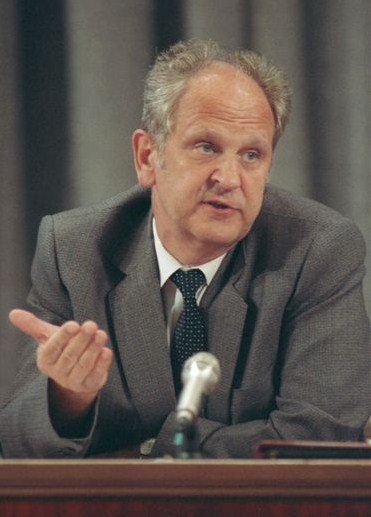
Boris Pugo, then Interior Minister of the Soviet Union, one of the – quite prominent – group of “putschists” of August 18-21, 1991, that included, among others, Head of KGB, Vladimir Kryuchkov; Defence Minister, Marshal Dmitriy Yasov; Prime Minister Valentin Pavlov; Vicepresident of the USSR, Gennadi Yanayev; Deputy Defence Minister, General Valentin Varennikov; and Secretary of the Central Committee of the CPSU, Oleg Shenin. – As the only one, Pugo was indeed announced to have, along with his wife, committed “suicide”, after the staged coup had been brought to its calculated failure (obviously in an attempt to give events greater credibility in the West). On the basis of Anatoliy Golitsyn’s analysis, one should rather assume that Pugo henceforth lived a privileged life in the hide somewhere in the vast spaces of the USSR. The other “plotters”, just as Golitsyn had predicted, were at first officially put to “arrest”, but already by 1993 released and solemnly amnestied in 1994, continuing seamlessly with their “post-Soviet” careers in business or the reformed structures of the “new Russia” or – in the case of Yasov, being already age 70 – leaving the scene for a while into temporary retirement.
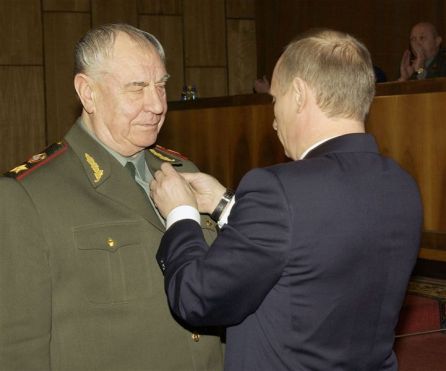
Former Defence Minister and “plotter” of 1991, Marshal Dmitriy Yasov (born 1923), on November 17, 2004, being decorated by President Vladimir Putin. – Note the expression and overall posture of Yasov, showing him, as the man of the “old” Soviet Union that he is, obviously very much pleased by how things are going for “new, post-Soviet” Russia. – In this picture you have the full continuity of the Soviet Union documented, and it even doesn’t need a single comment. Strong proof of the continuity is also the fact that Yasov in 1998 (still under Yeltsin!) returned into a prominent position as advisor at the Defence Ministry of the Russian Federation!
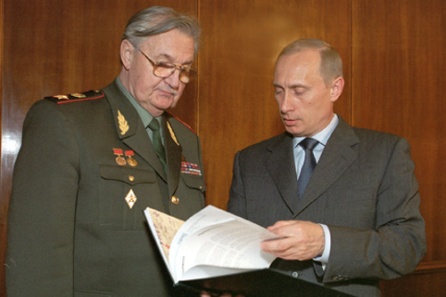
Former Deputy Defence Minister and Commander-in-Chief of the Soviet Land Forces, as well as “plotter” of 1991, General Valentin Varennikov (1923 – 2009), and President Vladimir Putin on April 11, 2002. Varennikov was from 1995 a member of the state Duma for the Communist Party of the Russian Federation and co-founded in 2003 a new “socialist-nationalist” party named “Rodina”. – Also, do carefully watch the body language of the two men (who are BOTH military men, as Putin isn’t as is always stated from the KGB but from the GRU, i.e. Soviet military intelligence, that still has kept its name till today): it shows them as part of a collective Soviet leadership and destroys the myth popular in the West of Putin, the “lonely Tsar”.
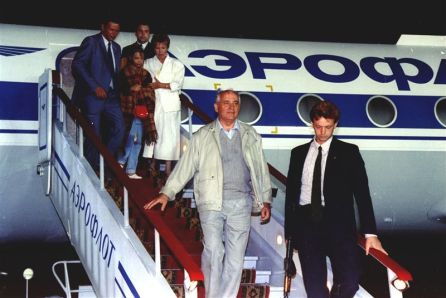
August 22, 1991, earliest morning: “Marked and traumatized” Mikhail Gorbachev’s return to Moscow, and thus mythical resurrection, after three days of “isolation” and “house-arrest” at his holiday resort on the Crimea. During the subsequent transition period until the replacement of the USSR by a “new” structure in late December of the same year, Gorbachev continued to be President of a Soviet Union gradually “deprived” of its Communist Party that, after a series of decrees by the Russian President, Boris Yeltsin, was finally terminated on November 6, 1991. – In reality, however, the Party just went underground and prepared for its new task: the overall political offensive on all fronts to achieve final communist victory.
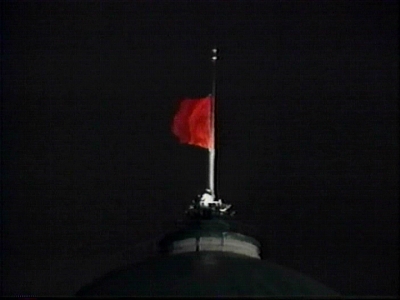
Eve of December 25, 1991 (they LOVE to usurp Christmas Day, not only for gaining maximum attention, but also, as Christopher Story points out, for quite Satanically mocking and inverting Christianity!) Formal “dissolution” of the Soviet Union and deceptive taking down of the Red Flag from the Kremlin’s roof-top, one of the most powerful images in the series of staged events since 1989. – However, after 1999, marked by the leadership change from Yeltsin to Putin, step by step all the symbols from the “Soviet era” returned – in other words, the Soviet Union started again slowly to show its true face: In 2000, the old “Stalin”-anthem by Alexandrov, that had been the anthem of the Soviet Union from 1944 to 1991, was reintroduced, albeit with a slightly changed text (people had never become familiar with the Glinka-anthem, in force from 1992 to 2000, anyway), a powerful remilitarisation of the whole (still Soviet-) Russian society took place, all complete with the “return” of red flags, impressive Soviet-style military parades on Red Square, a widespread and officially “tolerated” Soviet nostalgia and even Stalin-renaissance, and finally ever more sinistre sabre-rattling and bullying against the West (that has meanwhile given way to a sense of triumph in the face of a Marxist comrade loyally executing world revolution policy right from “White House proper” at Washington D.C.). – Not to forget the “friendly” face of the dialectic in the person of internationally operating Mikhail Gorbachev who for almost twenty years has been busy with tying the Western political, journalistic, intellectual, economic, and cultural elites into the manipulative spiderweb of communist geo-strategic engineering.
March 26, 1992
Geopolitical Strategies of Russia, the ‘Commonwealth of Independent States’ and China: A Comment on Ex-President Nixon’s Advice on Massive Aid to Russia
In an earlier Memorandum to the CIA this analyst explained the common Sino-Soviet long range strategy of convergence with the West and the intended exploitation for the purposes of this strategy of the new openings arising from the ‘reformed’ political structure of the former USSR and the emergence of the alleged ‘democrats’, ‘non-Communists’ and ‘independents’ who are running it.
The present assessment shows how, because of Western ignorance of and confusion about the strategy underlying ‘perestroika’ and because of Western political and economic support for the so-called reform of the Soviet system, the Commonwealth of Independent States (CIS) has been successfully installed and has begun to carry out concrete new geopolitical strategies within the framework of the long-standing overall Communist strategy of convergence.
These strategies are still being guided and coordinated by the same Soviet strategists who have simply shifted away from the use of the old worn-out ideology and the familiar but obsolete patterns, to the exploitation of geopolitical factors and of the new potentialities of the ‘reformed’ Communist system. The common feature of these geopolitical strategies is the manipulation and use of the ‘democratic’ and ‘independent’ images which the change in form from the USSR to the CIS and its individual members has provided so abundantly and the nature of which the West has, so far, failed to comprehend.
The following upgraded strategies may be distinguished:
• The first strategy involves the CIS and Russia in particular dealing directly with longstanding American allies like Germany and Japan and causing their allegiance to be shifted away from the United States towards economic and political alliance with the CIS and especially with Russia.
To this end Russia is exploiting American economic rivalry with Germany and Japan, together with the large-scale involvement of Germany and Japan in economic cooperation with Russia and the offer to them of lucrative market and investment opportunities in Russia. China can be expected to join in this campaign to steal away old American allies by concentrating on offering the Japanese various investment opportunities in China.
• A second upgraded strategy involves the use of the new ‘independent’ Muslim states in the CIS to establish and develop economic and political cooperation with the fundamentalists in Iran and elsewhere in the Muslim world.
According to this assessment the much-advertised feud between the Armenians and the Azerbaijanis of Turkish descent in Nagorno-Karabakh may be a tactical ploy to involve Turkey, Iran and other Muslim countries in support of eventual alliance with Azerbaijan and other Central Asian Muslim states in the CIS. This strategy takes into account the growing power of the fundamentalists and the possibility of their gaining control over substantial oil reserves.
A primary objective of the strategy here is to achieve a partnership with the fundamentalists in Iran and Algeria and to replace the present American-oriented rulers of Saudi Arabia with fundamentalists. The opening in Saudi Arabia of a Russian Embassy and the probable opening of Embassies by Muslim states of the CIS should be seen, not only as an attempt to extract a few extra Saudi billions, but as part of an offensive to bring about a political reorientation in that country.
Chinese Muslims can also be expected to play an active role in promoting alliances with the fundamentalists. The supply of missiles to Iran by the Chinese should be looked at in the context of this strategy.
• The third strategy is to facilitate a shift of the emerging regime in South Africa from the Western sphere of influence towards close economic and political cooperation and alliance with the CIS using for this purpose old friendships with leaders of the African National Congress and the South African Communist Party with which it is effectively merged. One can expect that the offensive to facilitate such a partnership will become more active and more visible than ever, after the ‘reforms’ in the CIS and South Africa have stabilised.
• The fourth strategy is that of using and manipulating the changes in the former Soviet Union to bring about, in the longer run, radical changes in relations between the United States and Israel, in the political power structure in Israel itself, in Israel’s position in the Middle East and in world opinion towards Israel.
The fact that the new leaders in Russia have promised the withdrawal of Soviet troops from Germany, the Baltic countries and Poland, and that they are insisting on a seven-year term for the strategic arms reduction treaty being negotiated with the United States, are indications that the Russian strategists have their own timetable. This is not based on what is going to occur in the CIS according to the optimistic expectations of Western observers, but rather upon the Soviet estimate of the time needed for the strategies described above to take effect. The possibility that the United States will lose valuable allies during this period is not something new. There is nothing permanent in international relations. The Americans experienced this not so long ago when they suddenly lost Iran.
The vulnerability of the United States arises from the fact that its basic premises, assumptions and perceptions about the present and future of Russia and the CIS are wrong. Where the United States sees golden opportunities, it is in reality facing traps set for it by the Soviet long-range strategists. The impact on the United States of the successful execution of these strategies would be devastating.
The loss of old allies and the loss of oil reserves, following the equally catastrophic loss of South Africa, would result in the re-emergence of the CIS and China as stronger adversaries, and in an ‘irreversible’ change in the balance of world power in their favour. The United States would be weakened and divided and the pressure for the impetus towards convergence of the CIS and China with the United States on Sino-Russian terms would be intensified.
The Dangerous Advice of Mr Richard Nixon
In this context a comment need to be made on former President Nixon’s criticism of President Bush for giving insufficient aid to Russia and his recommendation that massive economic technological aid comparable in scale to the Marshall Plan should be provided to the CIS. Nixon suggested that the present administration was missing an historic opportunity to help Yeltsin and to transform Russia into a democracy. This analyst believes Mr. Nixon’s advice to be erroneous and damaging to the vital interests of the United States for three important reasons:
1. Mr. Nixon has no understanding of the true nature and meaning of the changes in the former Soviet Union. He does not appreciate the calculated origin of the new realities there. He fails to see that ‘perestroika’ and the introduction of quasi-democracy and limited capitalism are all being carried out on the lines of Lenin’s New Economic Policy within the framework of the long-range strategy adopted by the Soviet and Chinese leaders in 1958-60.
2. Mr. Nixon puts too much trust in the former Communist leaders and in their instant conversion into ‘democrats’, ‘non-Communists’ and ‘independents’. He does not realise that this is a tactical conversion along the lines of Lenin’s classic advice to Communists to abandon leftist and revolutionary phrases and to adopt a rightist, opportunistic image in order to achieve their strategic objectives.
3. Mr. Nixon ignores the geopolitical strategic designs of the present leaders of the CIS and China aimed at weakening the United States and at achieving convergence. Even more important, he misinterprets the motive forces at work in the structure of the CIS. Following his advice by extending massive aid to the CIS will have the opposite effect to that which he intends. It will not transform Russia into a democracy and it will not prevent a new despotism there. But it will finance the transformation of Russia and the CIS into a more viable, more powerful adversary of the United States which will resume its old ideological hostility towards genuine American democracy and capitalism. It will allow the leaders of the CIS and Communist China to accelerate the pace at which they carry out their aggressive strategies against the United States and its present allies. And it will lubricate slush funds, directing hard currency into offshore bank accounts to finance intelligence activities.
Here in the United States we have a high regard for Mr Nixon’s opinions. But it is more important to consider how the leaders of the CIS regard Mr Nixon and his metamorphosis from a fervent anti-Communist into a strong supporter of Gorbachev, Yeltsin and ‘perestroika’, and an advocate of massive aid to Russia. The question was put somewhat diplomatically to the Russian Ambassador, Lukin, by a Western journalist. Watching Ambassador Lukin on the television screen while he was giving his cunning reply, this analyst was left in no doubt that the CIS leaders regard Mr Nixon’s conversion in the light of Lenin’s alleged advice on how to assess and deal with Western politicians.
Lenin is supposed to have divided Western politicians into two categories: those who were clever, anti-Communist adversaries who should be taken on, confronted and dealt with seriously; and those who were confused and ‘useful idiots’, who could be exploited up to the hilt in the Communist interest.
Since the Soviet long-range strategy and its final phase of ‘perestroika’ were based upon Lenin’s New Economic Policy experience and were imbued with Leninist spirit and thought, it is natural that successive Communist leaders should have seen Mr Nixon through Lenin’s eyes. In 1959, when Mr. Nixon held strongly anti-Communist views, Khrushchev, who initiated the long range strategy designed to bury capitalism in America, invited him to Moscow through the Soviet ambassador in Washington and took him seriously – that is to say, flattered him – by debating his views on Communism with him. Brezhnev took him equally seriously by simultaneously engaging him in SALT negotiations while fighting him in Vietnam, and then concluding the agreement on Vietnam which led to the American defeat there. During the impeachment process, Soviet officials mocked Mr. Nixon. According to an American reporter, Soviet officials and journalists asked him at the time with obvious sarcasm: ‘What are you doing to our Nixon?’ Now that Mr Nixon is Yeltsin’s most ardent supporter and exponent of the case for a Marshall Plan for the CIS, its leaders must be laughing their heads off recalling Lenin’s phrase about ‘useful idiots’ – while harvesting the benefits of Mr Nixon’s support for their devious policies.
Retaining the Capacity to Think
US intelligence agencies should be on the lookout for signs of the implementation of the geopolitical strategies of the CIS and its members and should provide policymakers with timely warnings. To be successful, these agencies must first distance themselves from the superficial assessments of ignorant television commentators who accept at face value everything that emanates from CIS officials or TV channels. They should focus on developing reliable human intelligence on the real strategic intentions and actions of the CIS and should analyse developments in terms of the geopolitical strategies described above.
The ‘reformed’ KGB is active and its intelligence offensive against the West continues as before. In fact, its political and operational capabilities have been broadened. Instead of the familiar unified KGB the West is now faced with fifteen KGBs which have not only changed their names, but have adopted a new modus operandi – or, to cite Lenin, a ‘new way of working’.
The Central Intelligence Agency’s analysts should ask themselves the question why, if Communism is really ‘dead’, if the USSR has really disintegrated and if the Communist ship of state is really sinking, there has not been a wave of high-level defectors comparable to and greater than the wave which occurred after the death of Stalin in 1953.
High-level defectors might have been expected not only from the intelligence and security services but from the armed forces, the Central Committee apparatus, the diplomatic service and Arbatov’s Institute for the Study of the USA and Canada. The absence of high-level defectors of such calibre to date indicates that the former Soviet machinery of state has been successfully transformed into the ‘state of the whole people’, as envisaged in the Party programme adopted by the 22nd Party Congress in October-November 1961.
The armed services of the CIS remain a formidable force with nuclear capability as well as political commissars. The United States should be on guard and should conserve its military strength because basic American assumptions about the military strategies of Russia and China will turn out to have been confused, if not totally erroneous. The United States should ignore Mr Nixon’s advice and steer clear of deep economic and technological commitments to Russia, the CIS and China. It should warn its allies such as Japan, Germany and France against such commitments. It should concentrate on addressing the immediate problems which beset the country at home and undermine its strength.
Abroad it should pursue an active foreign policy to maintain its position of world leadership, preserving and strengthening its alliances. But, for all this to be possible, it must first shed its naïve illusions about the nature of the changes that have occurred in the ‘ex’-Soviet Union (CIS). It must recognise that democratisation there is false and that the fundamental nature of the adversary has not changed: only its strategy and tactics have changed, in that they have become more candid, more realistic and more dangerous.
Only if the United States comprehends the calculated nature of the changes and the Leninist strategy which lies behind them, will it wake up to the realisation that financing the economic revival of the present Russian/CIS system will enable the strategists to pursue more effectively their objectives of engineering an irreversible shift in the world balance of power and eventual convergence with the West.
This ‘convergence’ is to take place not on the West’s terms – as élite Western globalists surely imagine – but rather on the terms intended by the Leninist strategic planners. The resulting ‘one world’ will be Marxist-Leninist-Gramscian-Communist – hardly what unwitting Western collaborators truly want to see established. (pages 149–153)
April 30, 1993
[…] Similarly, current and future Western aid for Russia will fail to deflect the Russian leaders from their long-term objectives of world hegemony which they will continue to pursue in concert with the Communist Chinese.
While US policymakers are mobilising massive Western support for Russia and building up optimistic expectations of the future for democracy there, the same Soviet strategists as before are quietly carrying out their strategy. As this analyst has argued in previous Memoranda and publicly in ‘New Lies for Old’, the late Academician Sakharov under the guise of a ‘dissident’ was used as an unofficial mouthpiece of the former Soviet régime before being officially ‘rehabilitated’ and lionised under Gorbachev’s ‘perestroika’. In the late 1960s he went some way towards expressing publicly the essence of Soviet strategy, though without revealing that the developments he foresaw were deliberately planned. He predicted that in the period 1968 to 1980 ‘a growing ideological struggle in the socialist countries between Stalinist and Maoist forces on the one hand and the realistic forces of leftist Leninist Communists (and leftist Westerners) on the other will lead… in the Soviet Union… first to a multi-Party system and acute ideological struggle and discussions and then to the ideological victory of the (Leninist) realists, affirming the policy of increasing peaceful coexistence, strengthening democracy and expanding economic reforms’.
The period 1972 to 1985 would be characterised by pressure from the progressive forces in the West combining with pressure from the example of the socialist countries to implement a programme of convergence with socialism, ‘i.e. social progress, peaceful coexistence and collaboration with socialism on a world scale and changes in the structure of ownership. This phase includes an expanded role for the intelligentsia and an attack on the forces of racism and militarism’. In 1972 to 1990, ‘the Soviet Union and the United States, having overcome their alienation, solve the problem of saving the poorer half of the world… At the same time disarmament will proceed’. In 1980 to 2000, ‘socialist convergence will reduce differences in social structure, promote intellectual freedom, science and economic progress, and lead to the creation of a World Government and the smoothing of national contradictions.’
All Sakharov’s main predictions have so far been fulfilled with the exception of Russian-American partnership in solving the problem of the poorer half of the world and the creation of a World Government. What Sakharov, like the present Russian leaders, clearly had in mind was East-West convergence on socialist terms leading to World Government dominated by the Russians and the Chinese.
But ignoring the long-term strategy behind the developments in Russia, US policymakers have plunged into partnership with the so-called ‘Russian reformers’ without realising where this partnership is intended by them to lead.
Sakharov foresaw World Government by the year 2000. The question may indeed be on the agenda within the next seven years. Within that period, if present trends continue, Russia, with Western help, may well be on the road to a technological revolution surpassing the Chinese Communist ‘economic miracle’ without loss of political control by the present governing élite of ‘realistic Leninists’.
A campaign for a new system of World Government will be launched at Summit level and will be accompanied by pressure from below, the active use of agents of influence and secret assassinations of leaders who are seen as obstacles. The campaign will come as a surprise to the US Administration. In the ensuing negotiations, the US President of the day will find himself facing combined pressure from the Russians and the Chinese. The Chinese will by then have adopted a ‘reformed’, pseudo-democratic system. In the course of the negotiations the Russians and the Chinese will begin to reveal their true colours, their fundamental antagonism to the free world and the threat they represent to it. The US policy of partnership with Russia will be exposed as bankrupt. Internally in the United States this will lead to divisions, recriminations and a search for scapegoats. Externally, the reputation of the United States as the leader of the free world will be irreparably damaged and its alliances, particularly with countries like Japan which have been pressured into helping the Russians out, will be jeopardised.
The US President will find himself without the finest armed services in the world. Reformed and cut back by budget reductions based on mistaken assessments of long-term threats, the services will be equipped for handling regional conflicts but will be unprepared for global confrontation.
US intelligence and counter-intelligence, if they survive, will have lost any remaining effectiveness from continuing financial pressure and a campaign of revisionist allegations like those that the CIA and the FBI were involved respectively in the assassinations of President Kennedy and Dr Martin Luther King.
Too late it will be realised that there have been no equivalent reductions in the power and effectiveness of the Russian and Chinese armed forces or their intelligence and security services. A real swing in the balance of power in favour of a Sino-Soviet alliance vis-à-vis the free world will have taken place giving the Russian and Chinese a preponderant share in setting up the new World Government system and leaving the West with little choice but to compete with them in designing the New World Social Order. If the Russian leaders continue to demonstrate to the Russian people that they can successfully extract Western aid and contribute to signs of economic progress, the Russian people will follow them and, like the Chinese, will end up laughing with their leaders at the folly of the West. (pages 165-167)
l
4. OVERWHELMING EVIDENCE OF A SEAMLESS CONTINUITY OF THE OLD USSR
What was almost impossible to predict at the height of George H. W. Bush’s ‘New World Order’ frenzy back in 1991, unless one would have studied Anatoliy Golitsyn’s book New Lies for Old, is the fact that the pan-communist bloc had in the late 1950s ‘scientifically’ developed an utterly complex long-range strategy to achieve communist world victory, by all means. The fall of the Berlin Wall was not the achievement of Ronald Reagan, but a coldly calculated chess move by Moscow. As was the whole seeming wave of ‘democratisation’ in Eastern Europe in that year of 1989 a tightly scheduled deception operation planned and coordinated by the Soviet strategists. The abolition of the Communist Party of the Soviet Union was a swindle; so was the alleged dissolution of the USSR in late December 1991; it wasn’t dissolved but simply relabelled as, henceforth, the “Commonwealth of Independent States”. Moscow still controls all “former” Soviet republics the same way as ever. But, as you could read in the excerpts from Golitsyn’s two books further above, it was all part of the strategy. The communist bloc could massively modernise and improve both their economies and their military, invade all supranational structures by a multitude of seemingly independent “Soviet Unions”, as well as flood the West with agents of influence and instant-entrepreneurs ‘eager to do business’, as William McIlhaney put it. All objectives, as can easily be seen if one opens one’s eyes, have been met. Former Western Europe is being gradually swallowed by the communist East, the key step of which was of course the EU-enlargement of 2004, which was set into force, MIND: on May 1st of that year: Labour Day!!! Whilst the United States finds itself, indeed, in an ever more critical position of isolation. Monetaristic-Corporatist Globalism has been used, exploited, and hi-jacked for the purpose of the revolution. Capitalism (a communist term, by the way) is in the process of being defeated and crushed by the communists, ironically via capitalist means!
Let’s once more recapitulate. 1989: Four years into the rule of Mikhail Gorbachev, two years after his proclamation of ‘Perestroika’, but nevertheless out of the blue sky, a series of collapses shook all communist regimes in Eastern Europe. In almost regular intervals, TV-viewers in the West could watch, like the falling of dominoes, the ‘toppling’ of one regime after the other. Strangely, both the Western media and politics took events at face value and bought in the deception. The fact is, however, that Poland’s Solidarność had been but an artificial and controlled opposition movement, and Czechoslovakia’s Charta 77, of which Václav Havel had been a member, but a fake dissident group. The ‘collapse’ of Honecker’s regime in East Germany came as a complete surprise to both Helmut Kohl and even Erich Honecker himself; yet things went miraculously smooth. The same suspicious ‘smoothness’ could be seen in the ‘transitions’ within the other satellite states, with merely one single dramatic scene at the end: the lynching of Romanian dictator Nicolae Ceauşescu on Christmas Day 1989 (they seem to LOVE usurping Christmas Day for their insidious provocations: two years later, Gorbachev declared the Soviet Union abolished also on Christmas Day).
Within half a year, the geopolitical landscape of Europe had completely changed, so it appeared. The Berlin Wall was gone. The Iron Curtain, that had divided Europe for such a long time, was declared a thing of the past. Even the late Archduke of Austria, Otto von Habsburg, for decades head of the Paneuropa Movement, along with one the Gorbachevs of Hungary, Imre Pozsgay (who today is an advisor to present “nationalist” Hungarian Prime Minister Viktor Orban), had enthusiastically held on August 19, 1989 a “Pan-Europan Picnic” near the Austrian-Hungarian border at the Hungarian town of Sopron (in German named Ödenburg), certain that now the peoples and cultures of Central Europe, that had been so dear to him, would finally come together. The event “quickened” the release of 600 to 700 East Germans into the West, although Hungarian border control had been simply instructed to look the other way and let them go. Everyone was cheering, nowhere could be heard even the slightest expression of doubt about the genuineness of it all. However, tragically, the Archduke was cynically used by the communists to assist them in a duplicitous propaganda coup. They are masters in letting the hated “class enemy” do the work for them! Today, Otto von Habsburg’s whole-hearted engagement isn’t even a footnote in the history of the alleged “fall” of communism. Instead, twenty years later, in 2009, right on the spot where Austria back in 1989 had politely – and as it thought: “heroically” – opened its border and allowed everybody in, was unveiled a monument in the typical style of Socialist Realism, deceptively titled in German: “Umbruch” (i.e., radical change), but at the same time titled in Hungarian: “Áttörés”. Yet, the word “áttörés” does in no way mean radical change, but “pounding”, “pinking”, “breakthrough”, as in military breakthrough! In other words, that monument’s real message, that’s hiding in plain sight, is that the “collapse of communism” and the removal of the Iron Curtain were only facilitating a full-scale INVASION, by “peaceful” means!
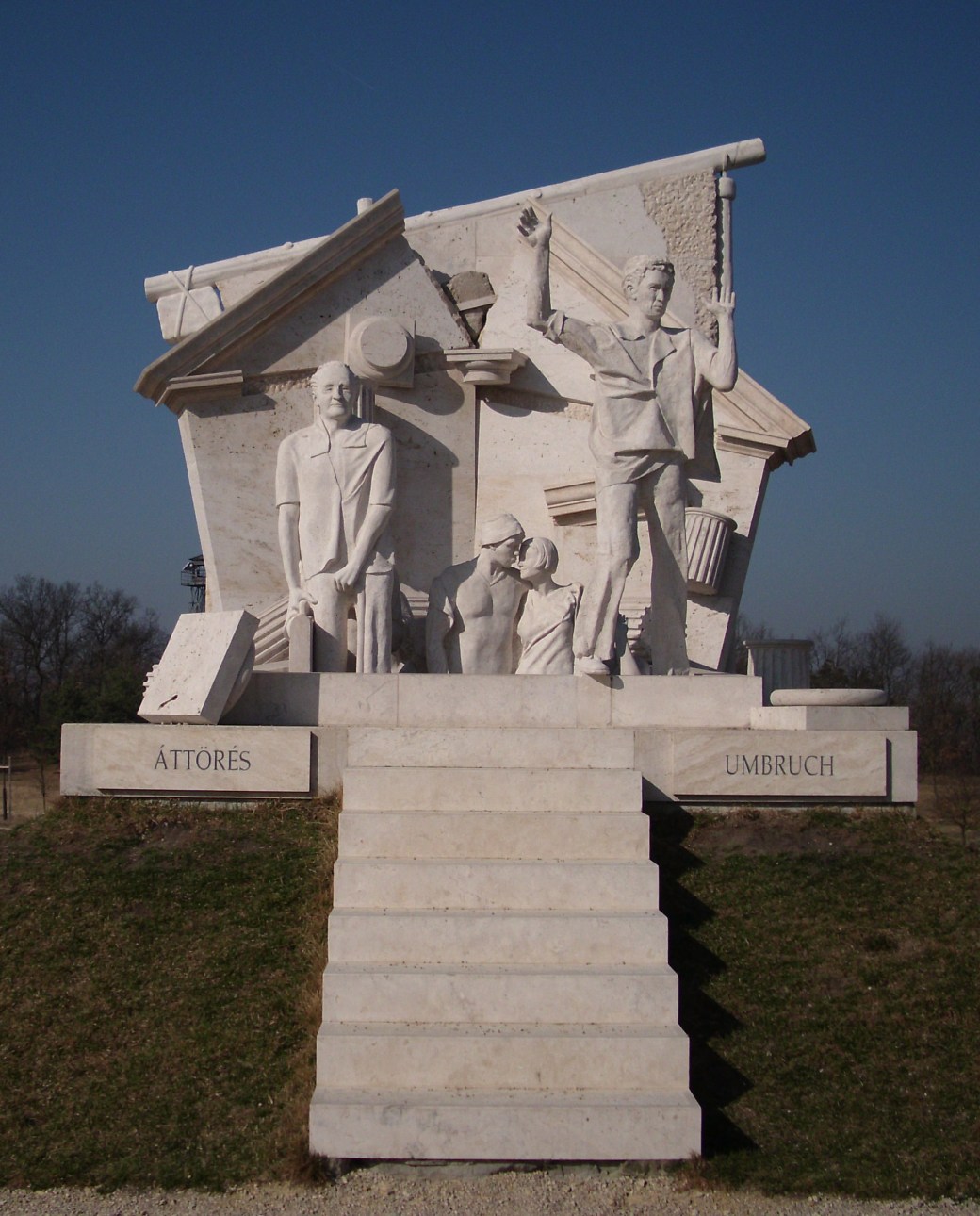
Referring to that event of August 1989, “former” communist East German Agit-Prop leader and now Federal Chancellor of unified Germany, Angela Merkel, made in 2009 the following devious remark: “Hungary gave wings to the will of the Germans from the GDR.” No mentioning of Western Europe; no mentioning of Austria that, after all, had opened its borders; and no mentioning, certainly, of the heir of the last Kaiser of the Austro-Hungarian Monarchy, who had helped them so generously. Rather, the communists are merely congratulating each other for the accomplishment of this great historic task of overwhelming the West, without the West realising at all what was going on! Today, since the outside borders of the European Schengen Agreement were shifted away in late 2007 from the eastern borders of once Western Europe further towards the East, partly Finland, but definitely Germany, Austria and Italy have practically no borders protecting them any more against the unchanged communist sphere!!! Borders have been taken away; so have been national currencies, with the exception of Britain, Sweden and Denmark; as well as distinctive passport formats (they are now all of the same burgundy colour that had always been and still is the colour of (Soviet-)Russian passports, with the format of EU and Russian passports meanwhile perfectly “harmonised”). And soon will even vanish national tax hegemony and national militaries. The nation state in Western Europe is gone and is now being swallowed, via the EU’s ever progressing convergence with the communist East and the unchanged Soviet Union, into an all-Eurasian communist bloc; and trains will again be deporting dissenters and “enemies of the people” all across Europe, this time into the new Eurasian-communist concentration camps of the future.
By October 1990, Germany was formally reunified. Chancellor Helmut Kohl was convinced he had written world history. 10 years later, however, in the aftermath of the CDU donation affair of 1999, Kohl had been turned virtually overnight into a persona non grata, without his protégé and successor in the post of CDU Party chairman, double-faced “ex-“communist Angela Merkel, coming to his assistance at all.
Although the inspirer of this giant ‘liberalisation process’, the Soviet Union itself didn’t take the decisive step before 1991. Again, events appeared dramatic (the bizarre ‘August coup’), but again were completely construed. Also the sequence of events wasn’t logical but, for the trained eye, obviously a prepared script being acted out in typical Leninist boldness. Still, the West chose to most readily believe what it had been wishing for so desperately for so long.
As 1991 turned into 1992, the world as a whole was different. Within two and half years, communism in both Eastern Europe and the Soviet Union had ‘abolished itself’ and had given way to an allegedly new, ‘post-communist’ and ‘democratic’ era, albeit under the very same personell operating on the same old mindset and objective of Marxism-Leninism!
But, as we look closer, especially in the case of the “New Russia”, we see nothing but a change of labels. NOTHING was abolished. Things merely took on a new mask more convenient to the gullible West:
• The Union of Socialist Soviet Republics became (except for the 3 Baltic republics that are now in the EU) the “Commonwealth of Independent States”, a theoretical construct rather than an entity recognised by International Law; yet, it shows the unchanged internal union of all supposed ‘post-Soviet’ and newly ‘independent’ republics. There has been no change!
• The RSFSR (Russian Socialist Federative Soviet Republic) was now the “Russian Federation”.
• The military alliance of the Warsaw Pact and the communist economic community COMECON were replaced by informal collaboration behind the scenes (which as for their military cooperation is more than alarming as the East European countries are now NATO member states at the same time).
• The CPSU was transformed into a controlled seeming multi-party system, with Communists and only Communists playing their theatrical roles for Western consumption, whereas the communist youth organisation Komsomol, far from being dissolved, was ‘transformed’ into a series of new “youth leagues”; with their newspaper “Komsomolskaya Pravda”, now a mainstream newspaper, still there!
• The secret services were renamed, not for the first time at all in Soviet history, this time from KGB to FSB. The ‘reforms’ were, at best, cosmetic. Military intelligence, however, kept its name, GRU (by the way, according to Christopher Story, Putin is originally GRU, i.e. military intelligence, not KGB/FSB).
• The classically Soviet central planning economy “matured” (in the Leninist sense of the word) into a display-only of a free market economy, complete with pompous company buildings, boards of directors, shareholders, and even a Moscow Stock Exchange; yet, all controlled, as ever, by the Party and intelligence apparatus. Like with the instant ‘democrats’, no one in the West seems to have wondered where the instant ‘marketeers’ and instant ‘entrepreneurs’ had suddenly come from, particularly how they could have ever acquired their enormous starting capitals in a system that had rigorously made impossible any private accumulation of wealth whatsoever. (It is these instant-oligarchs, by the way, who effectively besiege nowadays, with all their unchanged revolutionary prolet behaviour, the top luxury resorts of Western Europe. The once so elegant French Côte d’Azur, for one example, is now at 30% in Bolshevist hands. Bourgeois, let alone aristocratic, exclusiveness is under attack.)
• On September 12, 2005, the Governor of Ulyanovsk introduced a henceforth annual “Day of Conception” (or merely “Procreation Day”), as part of the nationwide efforts to overcome the Russian Federation’s demographic crisis, which means that couples in the area are given a day off so to basically do their best to make a baby, for which, should it then be born on June 12, the “post-Soviet era’s” so-called Russia Day, attractive monetary rewards are paid by the state. The peculiar thing about this, apart from the militaristic aspect of it, is the fact that Ulyanovsk is named after the “father” of the Bolshevist Revolution, Vladimir Ilyich Lenin, whose real surname was Ulyanov. Thus, this initiative and the babies it encourages to be brought into existence are very visibly dedicated to Lenin, and as such to the continuing cause of the communist revolution.
• All “formerly”-Soviet media- resp. propaganda outlets have remained perfectly intact: their “press agencies” (Ria) Novosti and (Itar) Tass; the flagship of Soviet newspapers and organ of the Communist Party, Pravda (i.e. “Truth”); Izvestia; Komsomolskaya Pravda, and so forth. How much criticism is really allowed, can be seen in the deaths of several journalists working for the “critical”, “post-Soviet” Novaya Gazeta (co-owned by Mikhail Gorbachev, by the way), among them most prominently Anna Politkovskaya, famous for her investigations of the Chechnya situation, who was shot dead by an unknown killer in the staircase of her house, execution-style, on October 7, 2006, and thus on Vladimir Putin’s birthday. In her well-known 2004 book, “Putin’s Russia: Life in a Failing Democracy”, far from revealing the full continuity of the Soviet system, she may well have made a fatal mistake, obviously crossing a red line: she ridiculed Putin, describing him as a pale secret service officer who now, instead of guarding the limousine convoys, strode up the ceremonial stairs of the Kremlin Palace like a new czar; and neither did she miss letting her readers know of the funny contortions by Putin and comrades when trying to perform, during Mass in Russian orthodox churches, the sign of the cross. Putin, by the way, took cynical revenge by commenting on her death saying, “she had brought more damage to Russia by her death, than by her work.” (Which perfectly sums it up: Politkovskaya, despite her courageous reporting on Chechniya, showed no signs of knowledge of overall Soviet strategy or of the Chechniya War being a pseudo-war set up by Soviet military intelligence primarily so to project into the West the illusion that “Russia” too is fighting Al Quaida, which, like all political terrorism since the 1960s, has been set up by the Soviets in the first place as a seemingly non-connected proxy; which also solves the ‘mystery’ of 9/11. Anna Politkovskaya’s tragic death, seen from the perspective of Soviet power, was nothing more than the crushing of an annoying insect).
• According to the late author and political analyst Christopher Story, there has also been no change in the cruel GULag system. Mr. Story said he was in the possession of lists giving the actual “street addresses” of 1,700 concentration camps throughout “Russia”. And let’s remember defector Yuri Bezmenov’s estimate made in 1984 that at any given time up to 30 million people were imprisoned in Gulag camps. As for the ‘luckier’ common citizens of Russia, they can’t move freely either, as they would possibly wish, because the old Soviet internal passport system known as “prapiska”, that regulates any movement through the country, is still in place. Regarding foreign tourists intending to travel Russia on an individual basis, they will have so many bureaucratic obstacles put in front of them that they will gladly give in and either join a guided (and controlled) travel-tour or won’t come to Russia in the first place.
• The ‘liberalisations’ have come to pass solely in “Russia”, and within Russia mainly in Moscow. The other ex-Soviet republics (except the Baltics and, for a while, Ukraine and Georgia) have maintained their open oppression. There wasn’t even a cosmetic change, apart from their alleged independence with new flags and new coats of arms. Their ‘independence’ is an illusion. They are unchangedly tied to Moscow, the same old centre of Soviet power. This means also that as for military- and intelligence capabilities these republics must be added to those of the “Russian Federation”. They are still ONE. As for alleged cultural re-nationalisation of these republics, at every opportunity (i.e. in TV documentaries on these republics as are shown at an amazing rate on German TV channels, obviously so to prepare people for the merger soon to come) one can see that always and everywhere officials and even ordinary people do not speak the national language but Russian! Also, a de-Russianisation in these republics, whether Kasakhstan or anywhere else, never happened. There still lives, as ever, a considerable portion of ethnic Russians in these territories (which one can easily see in sports: 3 out of 4 athletes, say from Kasakhstan, aren’t Kasakhs but ethnic Russians!).
• The old Soviet cadre training school for future Third-World revolutionaries and terrorists, infamous Patrice-Lumumba University for Peoples’ Friendship, is now called “Russian University for Peoples’ Friendship”. It’s still there! And if one looks closely, thanks to high-resolution digital photography (you can enlarge the picture yourself, if you wish), one can see in the emblem on the front of the building the complete coat of arms of the allegedly defunkt USSR, including Hammer & Sickle and even the acronym “CCCP”, meaning: USSR!!! WHAT BOLDNESS!!! This is a photograph made not 25 years ago, but – as one can easily see – in recent years (note the Russian tricolore, the clothes people are wearing, and the photo technology anyway).
• The monstrous Red Stars on the Kremlin towers, installed by Stalin in the 1930s, haven’t been removed to date, and never will be. And they’re still lighted from within, day and night, 24/7, by thousands of Watts. Also, the Red Star in fact has never vanished from “Russian” military vehicles, aircraft and ships and was in March 2010 also officially re-adopted as the emblem of the Russian Armed Forces, however with the more ‘sympathetic’ facelifting of having a fine blue-white margin (and thus a Russian tricolore) around its edges: deception everywhere (for that, click to enlarge)!
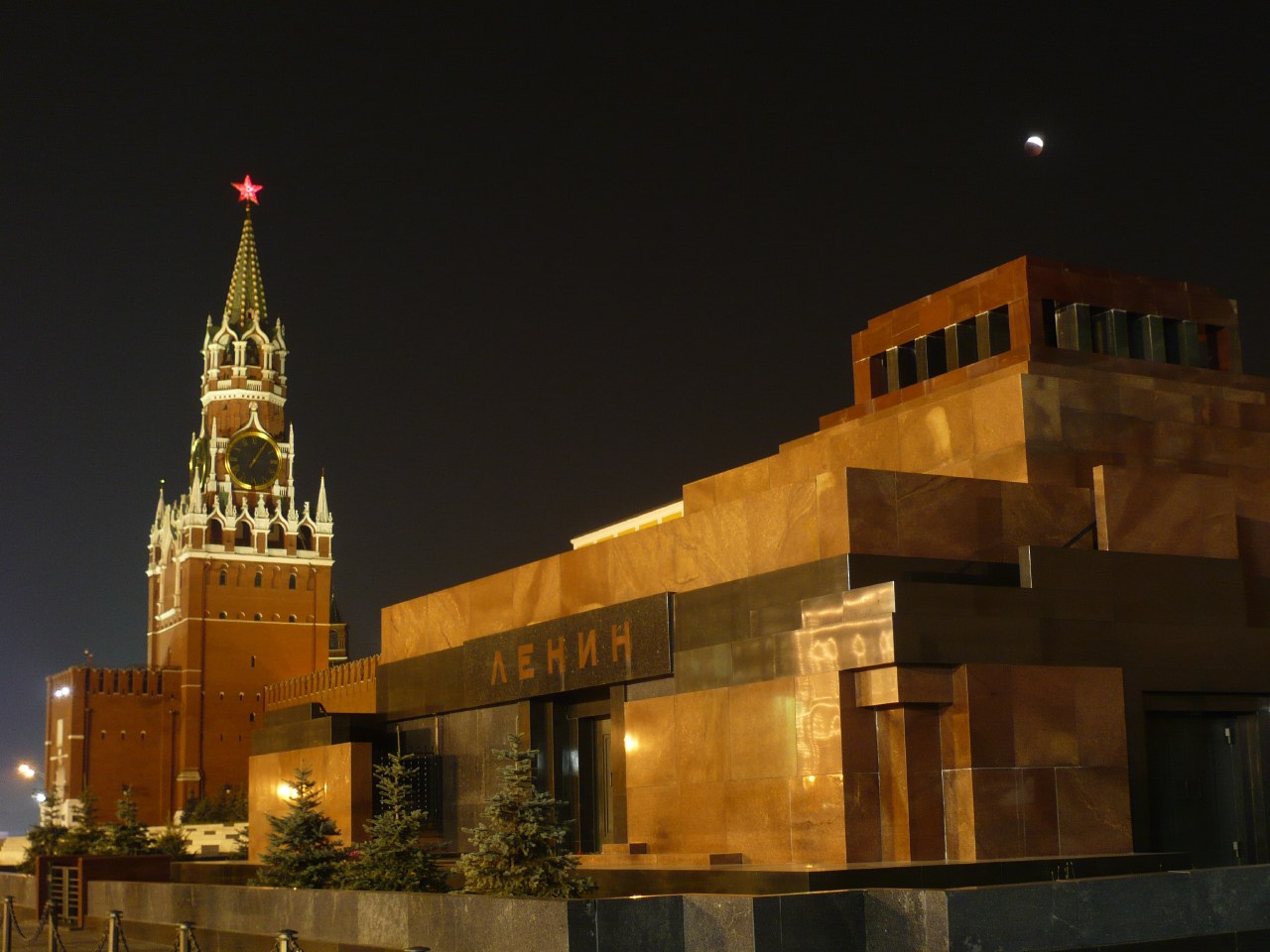
A night view of the most grandiose of the Kremlin towers, Spasskaya Tower, with the bright shining Red Star on top of it (had the communist era indeed been abandoned, the lightings for these Red Stars would certainly have been immediately switched off by the end of 1991 and finally the Stars themselves removed; none of which, of course, ever took place). In the foreground the ’Holy of Holies’ not only of the unchanged Soviet Union, but indeed of world communism: the sinistre and demonic Lenin Mausoleum, that still hosts Lenin’s corpse like in the ‘old days’ of the Soviet Union; no change. And ‘pilgrimage’ – maybe on a lesser scale, but even that can’t be known for sure – still is going on today! Also, it’s funny to see them ‘hiding’ the Lenin Mausoleum for their May 9th Military Parades, but having it for the rest of the year prominently visible as always, and so well-kept and ever perfectly cleaned and polished!
• Whatever new orders and medals may have been introduced since 1992 to give the “change” credibility, most awards still show the same old Soviet esthetics and, in some cases, next to identical design. The Order of Lenin, the highest decoration in the Soviet era, couldn’t possibly be transformed, for obvious reasons. Yet, the award medal “Hero of the Soviet Union” is now, merely with a change in the colour of its ribbon, the award medal “Hero of the Russian Federation.” [!!!] The former “Order of Friendship of Peoples” is now the “Order of Friendship”, with the Soviet coat of arms in the centre replaced by a mere globe but otherwise the same. Furthermore, the design of the Medals for Distinction in Military Service, 1stand 2nd Class, hasn’t changed at all! – Everyone can check out these bold continuities on the Wikipedia pages on Soviet resp. Russian awards and medals.
• Officials and representatives of the “New Russia” still address each other, in unchanged revolutionary manner, by first plus patronymic names without family name, albeit without saying “Comrade” any longer, at least in front of Western cameras. Thus, Vladimir Putin is “Vladimir Vladimirovich”, and Mikhail Gorbachev is “Mikhail Sergeyevich”. Whereas the obligatory address in the military and the militia is still, e.g.: “Tovarishch General”, i.e. “Comrade General”! Nothing has changed!
• The old Soviet anthem, that had replaced the Internationale in 1944, commissioned by Stalin and written by Alexandrov, was again adopted in the year 2000, after a break of 8 years during which a traditional tune by Mikhail Glinka was in use but never really taken to heart by anyone. Watch for this a little YouTube presentation by this author entitled, What’s just Wrong with the “New Russia”, that has both the Glinka anthem and the old and new Soviet anthem in it.
• The unchanged communist ruling class in the unchanged Soviet Union’s unchanged “classless society” loves Vladimir Putin. He has managed to reintroduce the image of a benevolent, albeit rigid (and cruel if necessary) “father of the nation” not seen since the days of Yossif Stalin. His manifold public appearances serve this purpose: Putin, the statesman; Putin, the pilot; Putin, the navy man; Putin, the craftsman; Putin, the sportsman (in fact, he once was a very successful judoka); Putin, also, the half-naked partisan; Putin, the attender of church services; Putin, the traditional Russian; and so on and so forth. This has nothing to do with the behaviour of Western politicians especially before elections, but represents rather, once again, an all-powerful totalitarian “Beloved Leader” in the making! (And Golitsyn even foresaw this: after the calculated chaos under Yeltsin, possibly a change to a military leadership: Putin comes from the military intelligence service, GRU.)
• On August 25, 2009, Moscow’s Kurskaya Metro station was solemnly re-opened after complete renovation. However, the renovation of this socialist-classicist ‘underground palace’, first opened on New Year’s Day of 1950 under Stalin, with elegant marble floors and huge Red Stars on the stucco ceilings, also included the restoration of inscriptions on the vestibule in the entrance hall praising “Uncle Joe”, that had been removed in the course of Khrushchev’s deceptive “de-Stalinisation” after the dictator’s death in 1953: “Stalin raised us to be loyal to the people, inspired us to labor and deeds,” derived from the second verse of the original text of the Soviet Unions’ Alexandrov anthem adopted in 1944, abolished in 1992, and again introduced, with again changed lyrics, under Putin in the year 2000. As can be seen in the picture below, the highly metaphysical niche of light in the background no more has the original statue of Stalin, that after its removal by Khrushchev went lost and was now finally decided not be put up again as a copy. Otherwise, the whole original Stalinist architecture is perfectly restored (as is being restored Stalinism itself, that was in fact merely a more square-headed variant of Leninism and not a deviation from it, and along with it the full militarisation of Soviet society akin to the 1930s and ‘40s; Putin, as a man of military intelligence and along with his friends, conducts this militaristic renaissance with great zeal and great ambition, as war might well be needed to finally reach complete communist victory throughout the world).
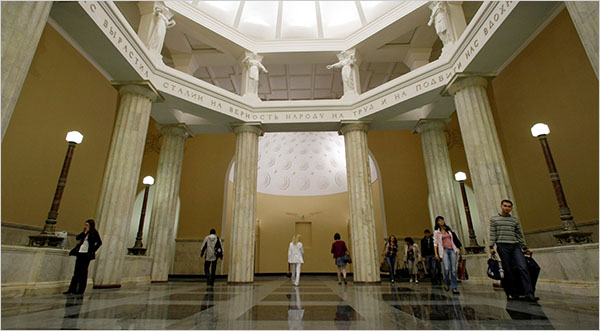
Kurskaya Metro Station in Moscow. The vestibule in the entrance hall now again carrying praises of Stalin!
Also, there are inscribed the maxims, “For the People, For Stalin” and “For the Defence of Stalingrad”. Dmitri Gayev, chief of the Moscow Metro services, said in the opening ceremony, “Our task was to restore the station in its original style. This station is an architectural monument.” – It’s quite interesting to see, as one looks at the various ‘art works’ of socialist realism resp. socialist classicism, also known as ‘Stalin Gothic’, how closely it all resembles the type of architecture favoured by Stalin’s rival dictator, Adolf Hitler. Well, the two totalitarianisms weren’t too far from each other anyway and until 1941 indeed viewed each other not as enemies but as ideological cousins and friends.
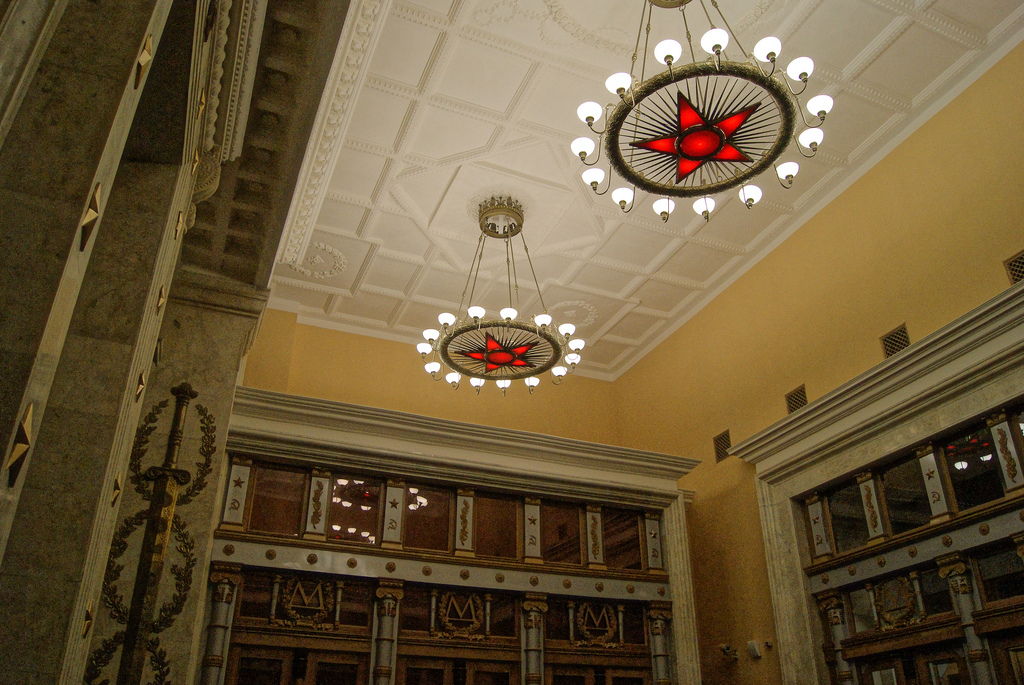
Kurskaya Metro station, Moscow: socialist classicism ‘at its best’! Mind the devilish Red Stars within the chandeliers on the ceiling: they look almost like pentagrams although inside them are in fact circles and not pentagons. Also, the individual lamps making up these chandeliers are 15 in number. The 15 seems to be quite loved by communists, probably they see it as their sort of ‘trinity’, namely 3 times the ‘Hermetic’ number 5! (15 is also, at least officially, the number of the Grand Arcane card within the Kabbalistic Tarot system entitled “The Devil”, although some authors argue, the true number of the devil might rather be the 11 instead.)
• Virtually NO city in the whole of “Russia” has ever removed its inevitable Lenin monuments prominently placed in the main squares or in front of administrative buildings. There was removed only a little number of Lenin statues back in 1991/92, mainly in Moscow and solely for Western consumption. If you want to enlarge any of the pictures below (so to be able to spot valuable details such as the Soviet coat of arms with Hammer & Sickle on official buildings), just click on the respective image! (One more sidenote: In November 2012, Russia Today ‘reported’ about an alleged debate in the Russian state Duma on the need of getting rid of all Lenin monuments across the country, except maybe those of particular artistic value: yet another monstrous distraction along their insidious road of dialectical deception; the timing of such disinformation rather seems to indicate the exact opposite: they are very close to launching their final strike so to cement – once and for all, as they believe – communist world domination.)
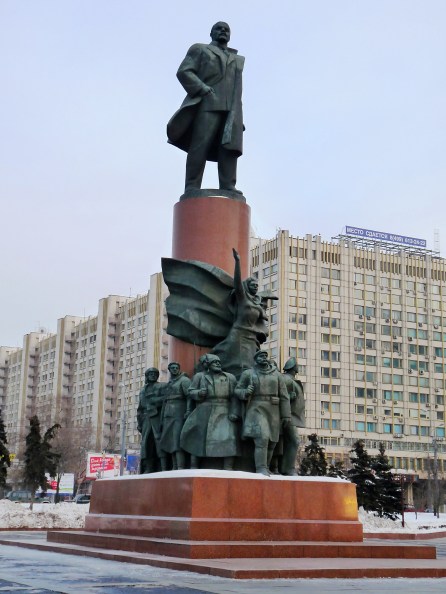
Moscow, Kaluzhskaja Square: What a tribute to the founder of the Soviet state, Vladimir Ilyich Ulyanov, a.k.a. Lenin. And it’s still there!
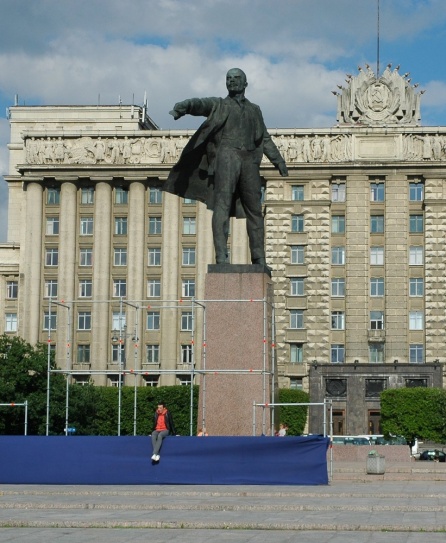
Leningrad/St. Petersburg: A Lenin monument in front of a government building. Note the full Soviet coat of arms with Hammer & Sickle still there on the fassade of the building as ever!
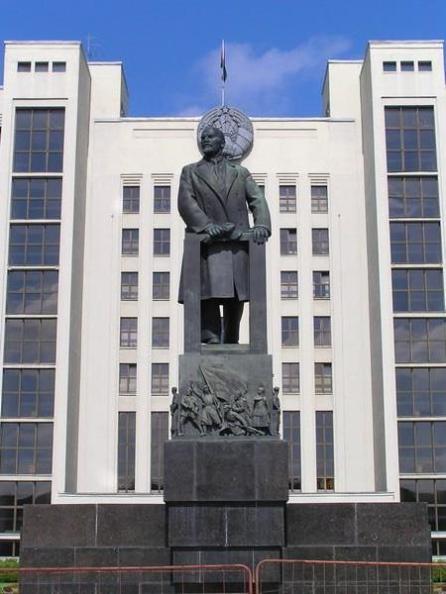
Minsk, capital of Belarus: Lenin monument in front of the Belorussian parliament. Note the coat of arms on the front of the building: it’s the official coat of arms of today’s Belarus, that is almost a replica of the coat of arms of the old USSR!
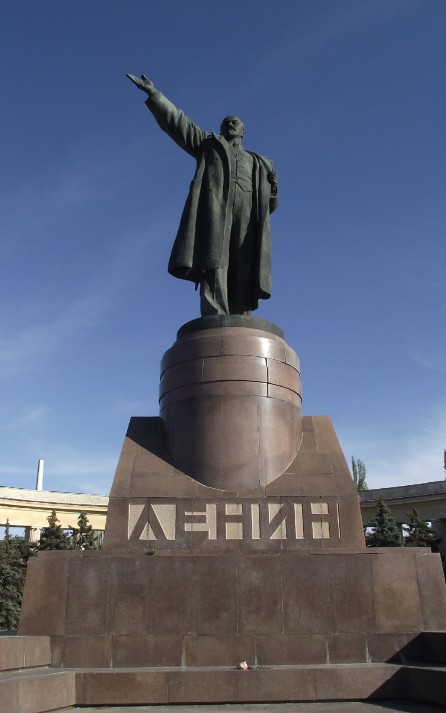
Stalingrad/Volgograd: Comrade Lenin again. – By the way, on February 2, 2013, the 70th anniversary of the Soviet armies’ victory in the battle of Stalingrad, now-Volgograd was SOLEMNLY re-named for one day into Stalingrad. What’s more is that the official “New Russia” is now entering into a “discussion” about returning to the name honouring “Uncle Joe”: Stalingrad. A ‘referendum’ is looming on the horizon. If indeed Volgograd should be renamed into Stalingrad, it’s probably only a matter of years until St. Petersburg will be renamed into LENINGRAD!!!
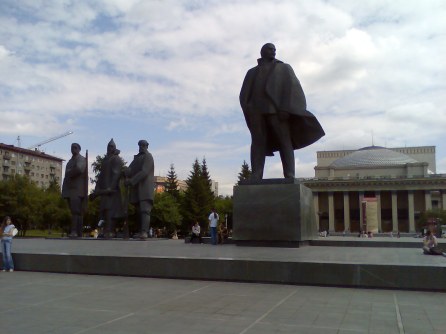
Novosibirsk: Comrade Lenin, dominating the scene as everywhere. The “Russian Federation” STILL IS the state of Lenin!!!
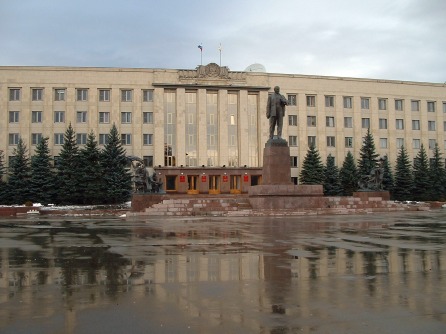
Stavropol, the region of origin of Mikhail Gorbachev. Note also here the unchanged Soviet coat of arms in the Stalinistic architecture!
• The Moscow railway station from which trains leave for what is supposed to be again St. Petersburg is still named “Leningradskaya” resp. “Leningradskiy Vokzal” (i.e. Leningrad Railway Station), in Cyrillic writing: “Ленингра́дский вокза́л”, which you can compare to what you are seeing in the picture below. – How is that?! And mind the Communist Red Star on top of the tower that is visibly lighted from within just like the Red Stars on the Kremlin towers. (Click to enlarge!)
• The military parades on Victory Day, May 9th, are back (since 2005), with full armory (since 2008), including even Topol-M nuclear missiles (below: images from the Victory Day Parade of 2012)
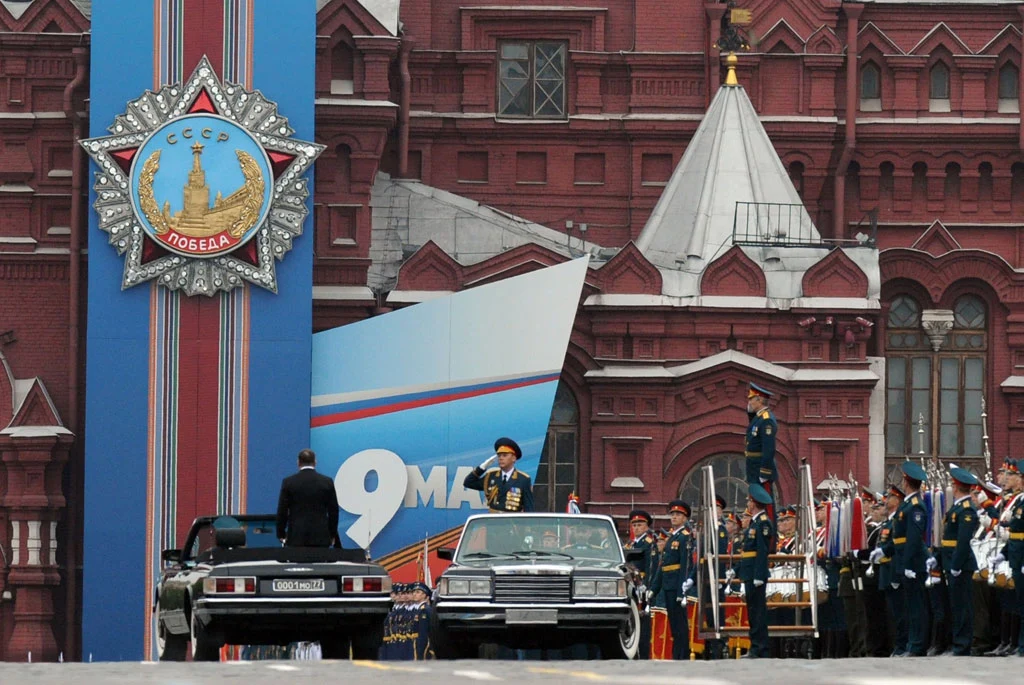
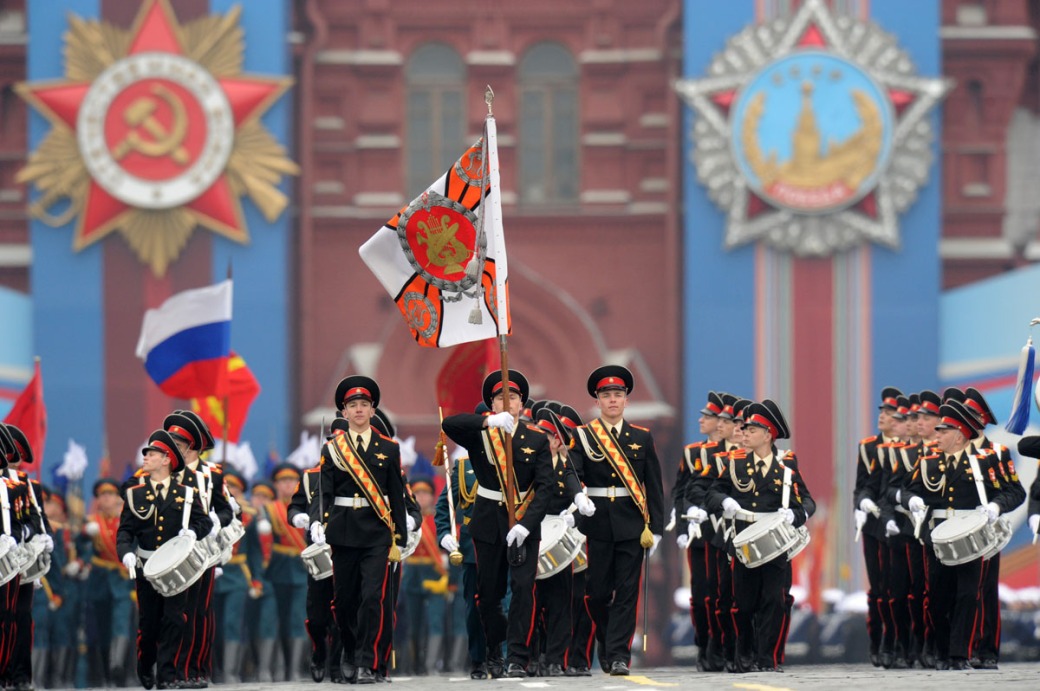
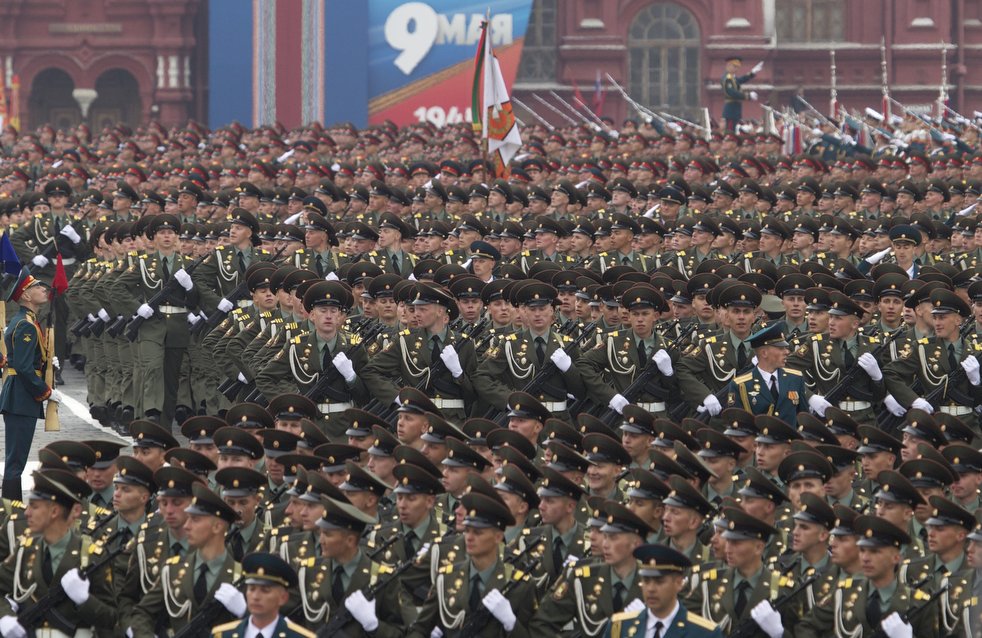
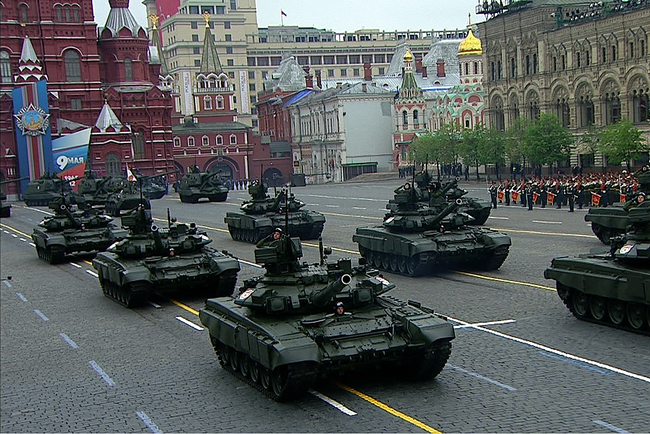
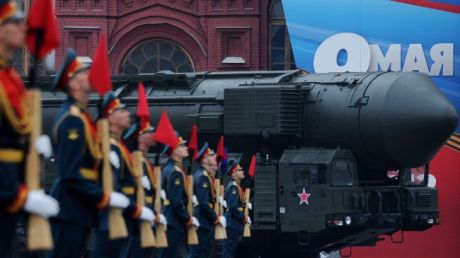
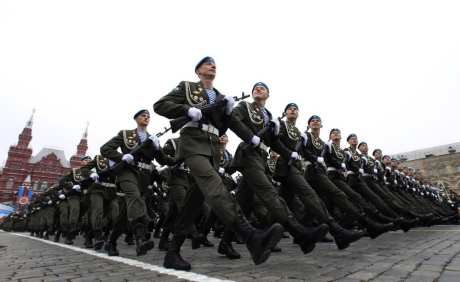
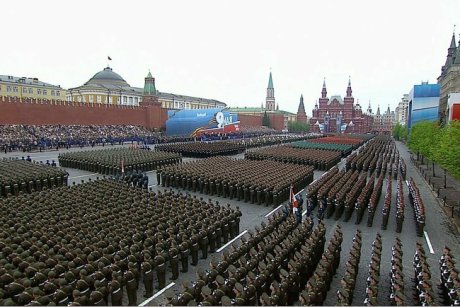
(For those who want to get a more authentic idea of what such a modern-day, “post-Soviet” Victory Day Parade is like, just view there on YouTube an 82-minute live-broadcast of the 2012 Parade on Red Square from Russia’s Channel One; although it’s all in Russian, you’ll get a far better picture than from viewing the international propaganda coverage of the event from “Russia Today”, as what you will see here is an unchangedly revolutionary, Marxist-Leninist Soviet Union, more than twenty years after its alleged demise.)
• “Russian” space-rockets are still known under “Soyus” (i.e. Union); the “Russian” resupply spacecrafts still under “Progress”!
• “Russian” football clubs – and also those in the “former” satellite states of Eastern Europe – are unchangedly named, in “good old” communist, revolutionary and militaristic fashion: Dynamo; Rubin; Lokomotiv; Spartak; Zenit; Rotor; Torpedo; Saturn; Salyut; Avangard; even there still is RED STAR Belgrade!
• The state airline Aeroflot (well, everything is still state-owned except small businesses) still has its old Soviet logo showing Hammer and Sickle. Below: a modern-day Airbus A-320 of the Aeroflot flleet, and the airline’s logo in close-up view (click to enlarge).
• In March 2011, the “Russian Federation” for the last time changed its clocks to daylight saving; they didn’t set them back in autumn any more, but are henceforth having daylight saving time the year round. This marks a return to the old Soviet Decree Time. The step is highly symbolic. After two decades of seeming rapprochement with Europe, they now turn the other way, expecting of course that the whole of Europe will follow in due time, whether by daylight saving regulation or by political standards. Indeed, the question of year-round daylight saving seems to have been vividly discussed in EU circles. Once that happens, it will almost certainly coincide with the final political merger of former Western Europe and the unchanged Soviet Union, needless to say: on Soviet terms!
• On March 29, 2012, it became known that soon-to-return President Vladimir Putin was planning to renew an old Soviet workers’ ‘tradition’ (the word ‘tradition’, in combination with revolutionary communism, should always be put under apostrophes), namely official competitions in five categories of professions: Big Brother again is looking for the ‘best stonemason’ in the country, the ‘best welder’, the ‘best miner’, the ‘best electrician,’ and the ‘best truck driver.’ The annual winner will be granted a prize of 300,000.- rubles, i.e. roughly $ 6,000,-! The second gets 200,000,-, the third 100,000.-. But, it seems, the West remains fast asleep no matter what …
• One last important point: Supposed Chechen sabotage and terror attacks in ‘Russia’: Whether the bloody attacks in the Moscow underground (mimicking London’s 7/7), attacks against rail lines, and of course the war in Chechniya, that is yet another Leninist hall of mirrors, these should rather be carefully examined as for being events staged by Russian military intelligence so to keep their argument alive that ‘Russia’ too has a ‘Muslim” resp. “Al Qaida” problem, by which they’re able to divert attention from the fact that it has been and still is the Soviet Union that created international terrorism in general, and Al Quaida in particular, and to continue to penetrate Western security structures on the basis of ‘necessary cooperation’ in the face of global problems …
One could go on for pages and pages as, in fact, the continuity is all-pervading. There has been no change whatsoever!
The question, never asked in the West, should have been: Why wasn’t there a violent uprising of the people and a witch-hunt after all communists (like in Hungary in 1956 before it was crushed)? Why wasn’t that sinistre Lenin Mausoleum on Red Square blown up into pieces? Why weren’t 74 years of Soviet history properly reviewed and the communists’ rewriting of history corrected? Why wasn’t there done any “grief work” so much needed after three generations of brutal oppression and unimaginable crimes? And why wasn’t there a sort of Nuremberg trial, with thousands and tens or even hundreds of thousands of subsequent executions? Why was there this spooky change of labels without any change in substance whatsoever? The answer has already been given above: because the ‘changes’ were planned, coordinated, and controlled; and because it’s still the same people now working still under the same old Soviet system, and so for their unchanged goal of worldwide communist victory!
l
5. COMMUNIST MILITARY BUILD-UP AND INCREASING POLITICAL BLACKMAIL
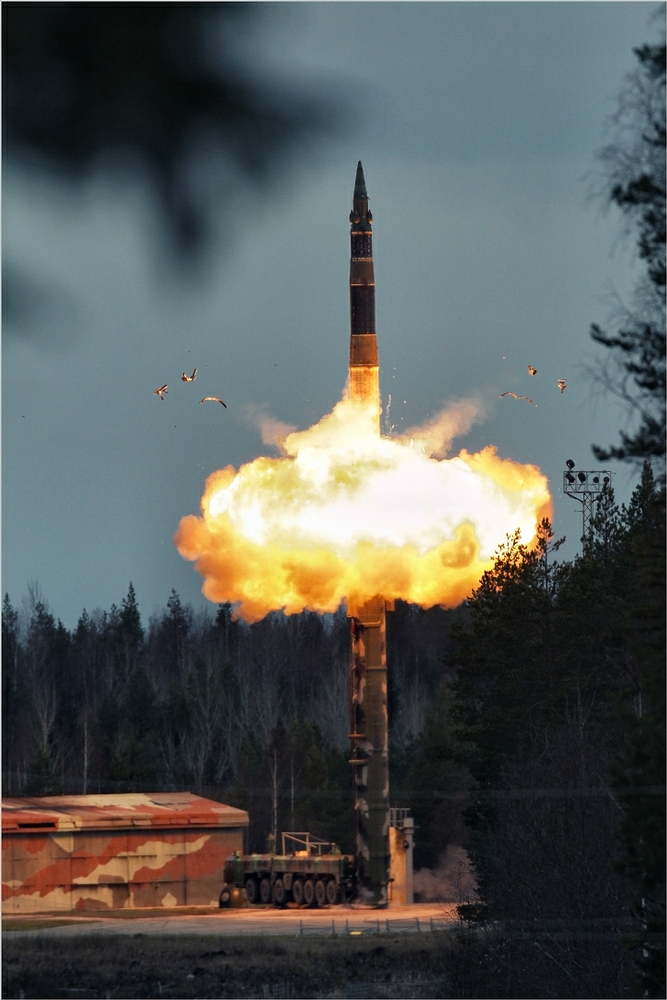
A Russian Topol-M intercontinental ballistic missile being fired from a mobile launching base.
A (Soviet-) Russian Topol-M (a.k.a. SS-27 Mod.1 Sickle B) Intercontinental Ballistic Missile fired from a mobile transport erector launcher (the United States, in contrast, relies now solely on its silo-based, 40-year-old and increasingly unreliable Minuteman-IIIs to be replaced by an updated design not before 2030, if at all). The Topol-M, an advanced version of the SS-25 Sickle and designed alternatively also for the launch from submarines, is a fairly unmatched hi-tec weapon developed in the ‘Post-Soviet’ era under Yeltsin. Its range is 11,000 km, with a circular error probability, due to satellite control, of only 200 m. It is equipped either with one 800 KT nuclear warhead (which equates to 44 to 61 Hiroshima bombs) or instead with a multiple independently targetable warhead (MIRV). Its most important feature, however, is that it can hardly be intercepted (which indeed opens for the unchanged Soviets, along with their equally advanced missile defence, the long-desired possibility for military blackmail against the West; and, yet the present U.S. Administration is working towards “Global Zero” of nuclear weapons, which would, even with the most powerful conventional weapons replacing them, leave America and the West without its nuclear deterrent). The Topol-M is able to perform complex evasion manoeuvres to escape interception; is equipped with a counter-targeting system; can emit decoys so to confuse defence missiles; and is shielded against radiation, EMP, nuclear explosions over 500 meters away, as well as laser attacks. Officially, there were deployed, as of late 2010, 52 Topol-Ms in silos and 18 on mobile launchers. By the turn from 2011 to 2012, that total number of 70 Topol-Ms should have increased to 78. By the year 2020, the Russian Strategic Rocket Forces say they plan to be in the possession of as many as 177 land-based Topol-Ms (silo or mobile). However, given the long tradition of Soviet cheating, real numbers should be assumed to be considerably higher. Add to this the possibly hundreds of Topols (SS-25-Sickle), Iskanders (SS-26 Stone), SS-19s and the 30 UR-100UTTKh (SS-19) and 108 RS-24 ‘Yars’ (SS-29), not to mention their biological and chemical arsenals as well as weaponry such as the cargo-container Club-K missile system that equates to a true unrestricted-warfare terror weapon, it can be secretively launched from within a seemingly harmless cargo container and thus, theoretically, from any Western freight port, from commercial ships at sea, from civilan trucks or trains. Also, the Russians have made enormous progress in all other military fields, whether tanks, submarines, torpedo technology, and aircraft! This doesn’t include the highly secretive area of Tesla weapons (directed energy weapons), where they are said to be far ahead of the United States. The unchanged Soviet Union, still more or less disguised as a “New Russia” but also including, lest we forget, the whole number of “former” Soviet republics, has a toughly trained and, so we can assume, highly motivated military. The source of their optimism and their morale is their ideology. And the Soviet Generals, who have been pushing for many years towards ever more arming up, are convinced they can fight and win a global war (in which, of course, they will be greatly assisted by their communist ally China, a country with 1.34 billion people, i.e. 19% of the world’s total population, and all other communist countries throughout the world). Furthermore, the open societies of the West will have another cruel surprise: communist cells – mainly immigrants, one can expect – in their midst; who will have drawn up death lists of anticommunists, conservatives, traditionalists, priests etc.: everybody who will not be seen “fit” for living in the future communist world society.
Some of the following will be better understood after reading chapter 7 and Appendix II of another article on this blog, ‘Forward, Comrades! Not back!’ – America and the World on the Brink of Global Communism. All facts listed below have been been meticulously researched as well as thoroughly meditated upon by this author, based on the methodology of unmatched top Soviet defector Anatoliy Golitsyn, author of “New Lies for Old” and “The Perestroika Deception”.
The war threats by Russia and China during the last decade, after a clever display of the “weak look” in the 1990s, were many and have intensified over the time. By now, it appears they are prepared and ready to go for it and finally crush their hated “class enemy”, with or without war, so to establish their long-desired world communist society. The West’s desperate choice will then solely be to either sign its unconditional surrender to communist world rule straight away or to accept a life-or-death military confrontation that, by human reckoning, it cannot win; not any longer.
May 13, 2000, Moscow: Only 6 days after his pompous inauguration as Russian President and as his very first act in office, former military intelligence (GRU) officer Vladimir Putin decrees the reorganisation of the territory of the Russian Federation into 8 administrative regions resp. federal districts in exactly the same manner as precisely to the day Yossif Stalin had divided the once Russian Socialist Federative Soviet Republic in those same 8 military districts on May 13, 1941 as a preparatory measure for the war against Germany that already was in the air (and that just as well could have been a Soviet invasion of Germany, had not the Germans attacked first). Thus, again, the secretly continuing USSR has entered a phase of immediate war preparation as early as the year 2000! Also, the already otherwise existing military districts of today happen to be identical with the newly formed regions, that are each henceforth under the control of two to five “presidential plenipotentiary envoys”, mostly military men: a system with a much stronger and more effective ‘power vertical’. Also, there were reports in that week in 2000 about a possible amnesty of as many as 120,000 prison inmates obviously to be trained for service in the military, which too follows the Stalin pattern at the beginning of the Soviet-German war. Below: The 8 federal districts of the Russian Federation (i.e. of the ‘former’ RSFSR): Northwestern, Central, Southern, North Caucasian, Volga, Urals, Siberian, and Far Eastern.
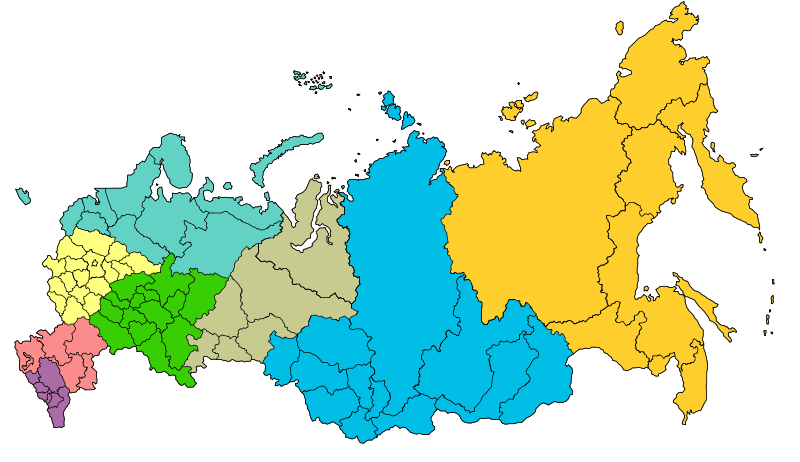
November 11, 2002, Brussels: Following a summit meeting where he had met EU leaders and discussed i.a. the Chechniya crisis (and only weeks after the hostage tragedy in Moscow’s Dubrovka musical theatre, in which 39 Chechen militants and at least 129 hostages were gassed to death in a highly controversial Spetsnaz operation), Russian President Vladimir Putin turned a press conference into a veritable scandal; yet, it took a day of listening to the tapes for the Western journalists to realise what he had actually said, as the Russian interpreters either hesitated to translate in full or just couldn’t catch up with the speed of his outburst. What had happened: A reporter of the French daily Le Monde was asking about the possible use of heavy weapons against civilians in Chechniya, to which Putin gave back, among other elaborations, “If you want to become an Islamic radical and have yourself circumcised, I invite you to come to Moscow. Our nation is multi-confessional, we have experts in the field. I would recommend that he who does the surgery does it so you’ll have nothing growing back afterward.” Wow!!! Although Putin’s aides did their best to explain away the remark, arguing the President had been exhausted and was sick and tired of Chechniya, nevertheless: what a statement! Whereby the sobering political reality of the Chechniya war is that it is a staged war controlled from both sides of the conflict by the Kremlin. For what ends, one could ask? To be able to show the West that they too have an ‘Islamic problem’ and put themselves on the green tables with the political leaders of the West and tie them into ever deeper cross-border co-operation between all sorts of intelligence services and possibly police. So it’s but a construed pretext to further undermine and penetrate Western services and to have yet another strong argument along the lines of “Global problems need global solutions.” The irony of it all, however, is that global terrorism is basically a communist invention: Mainly since the ‘50s and ‘60s, none other than the Soviets, along with the Chinese and all other communist allies, had systematically formed a worldwide network of terror organisations, mostly labelled as “liberation movements.”
May 9, 2005, Moscow, Red Square: 15 years after their last May 9th “Victory Day” parade on Red Square in 1990 (the last Victory Day in the official USSR of 1991 saw no parade, maybe as a deceptive ‘peace’ gesture towards newly reunified Germany), the Russians now hold a highly Soviet-style veterans’ parade celebrating the 60th anniversary of Soviet victory over Nazi Germany (the ‘New Russia’ still refers to WW II, in unchanged Soviet fashion, as the ‘Great Patriotic War’!).
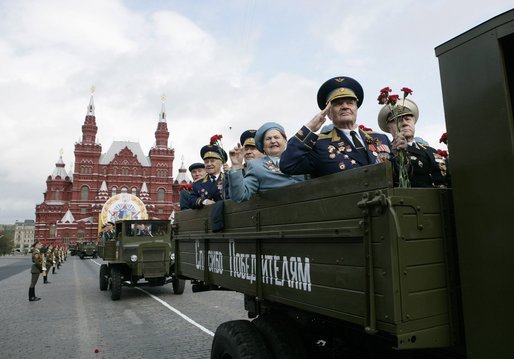
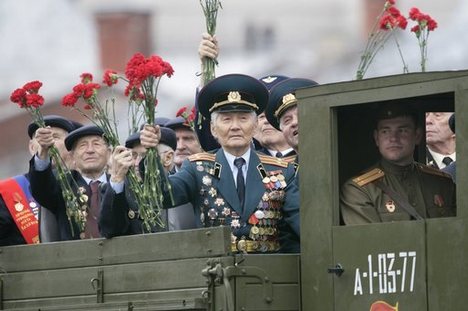
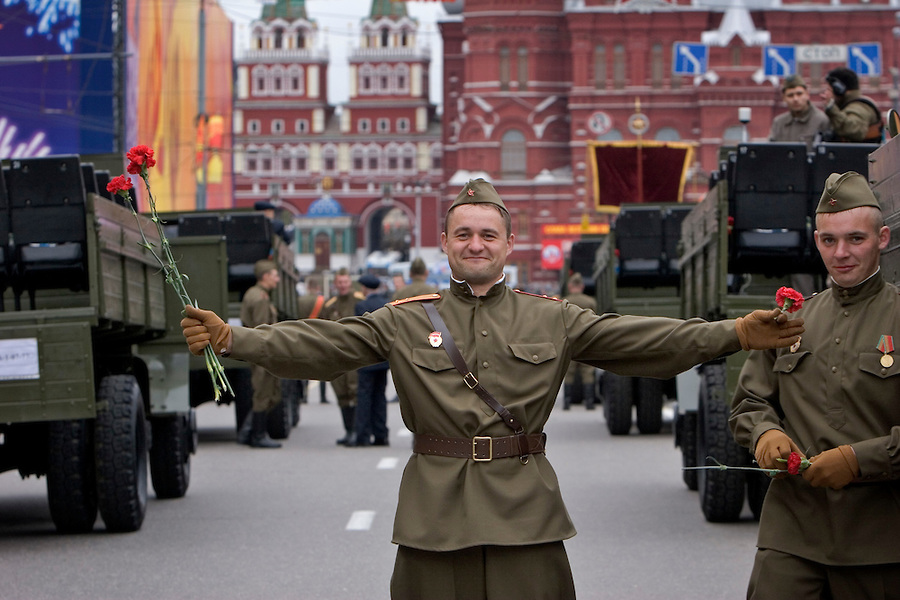
Also Western leaders such as Jacques Chirac and Tony Blair attended the parade. – Although still an historical display of WW-II machinery, along with old men of 80 or older, the parade was far from being mere nostalgia: the reviving of the old Soviet habit of Red-Square parades was in itself a strong signal: we are back, or more accurately: we are still the old Soviet Bolsheviks (and from 2008, these parades were indeed geared up to full-scale, state-of-the-art military parades like in the times of the overt Soviet Union, albeit still with the Lenin Mausoleum hidden behind pompous scenes of Russian flags and revolutionary paintings). Plus, this 2005 parade probably marked the starting shot for an overall wave of very brutal anti-Western and, it seems, pre-WW-III propaganda (that is now everywhere on the internet, especially on Youtube); in fact, that turn again towards a much more overt military regime had already taken place by the succession by Vladimir Putin into the office of President in the year 2000, who according to the late British analyst Christopher Story is not, as widely held, KGB, but GRU, i.e. Soviet foreign military intelligence (a rivalling structure to the KGB and much more secretive than the KGB); in other words: the current Soviet-Russian leadership, probably more than any other Soviet leadership since the days of Stalin and just-as-cruel Khrushchev, consists of experts in war, not in civil affairs! And Putin may well be the man to lead the unchanged USSR, along with the whole communist bloc, to worldwide victory as he is now most likely to be President for another two 6-year-terms, i.e. until the year 2024 (although we should leave behind our Western misconception that this is about individual people: they work as a collective, also at the leadership level!).
September 2006, China: After much internal debate, the U.S. Pentagon finally publishes the fact that China had successfully proven its capability of blinding U.S. surveillance satellites with powerful ground-based laser beams. Test attacks were subsequently executed by the American military to assess the severity of the problem. – Everybody should read the 1999 book “Unrestricted Warfare: China’s Masterplan to Destroy America” written indeed by two colonels of Red China’s People’s Liberation Army, Qiao Liang and Wang Xiangsui. Beside its boastfulness and aggressive style, the book first and foremost reveals the all-but-politically-correct approach by China (and certainly also Russia): warfare by all means. After all, they are carrying out a revolution, world revolution, and they won’t stop at anything to get their way, as for instance their 24/7 cyber war against Western institutions and corporations greatly illustrates. Nevertheless, Americans and Europeans most civilisedly maintain their diplomatic and business ties with them, simply because there is no alternative any longer: the monster has already grown far too powerful, not the least thanks to those Western politicos who opened this door into self-destruction and utter defeat some fourty years ago…
October 26, 2006, East China Sea, between Japan and Taiwan: During a U.S. Navy exercise in the region, suddenly and surprisedly a Chinese Song-class attack submarine surfaced within nine miles, i.e. within torpedoing distance, of the aircraft carrier USS Kitty Hawk. None of the whole number of escorting ships of the compound (that must have included also submarines) had been aware of the presence of the Chinese submarine prior to its surfacing! The incident naturally caused great shock (not to speak of embarrassment) in American military circles as it revealed a degree of sophistication of China’s submarine fleet that had neither been known nor expected. The consequences from this new reality are far-reaching: the Navies of the West might now well be rendered useless and defenceless against Chinese (and certainly Russian) submarine approaches and attacks. Asked by American diplomats why the submarine had been shadowing the U.S. fleet, Beijing pretended ignorance and dismissed the affair as coincidental.
January 18, 2007, Xichang Space Centre, China: Despite its earlier denials about developing space weapons, China undertakes the shooting down of a redundant weather satellite of its own by a ground-space ballistic missile fired from the Xichang space centre in the North-West province of Sichuan. This first anti-satellite test by any country for two decades again causes great nervousness in the West. Yet, the Chinese Foreign Ministry stone-walls the protests, arguing it had not been informed of any such missile test, and ‘assuring’, “We are opposed to any arms race in space and we will not get into any arms race in space.” Yet, in spite of this series of ‘Sputnik shocks’, American and Western circles try to carry on with business as usual, still unable to realise where all this is headed. Not only have Russia and China been in a firm alliance for half a century, and meanwhile show it quite openly, their final intention of course is not defence or emancipation against a “Pax Americana” and so forth, but preparing for overall communist triumph on a global scale. This is what Western politicians, whatever their and their elites’ agenda may be and insofar they’re not already communist moles themselves, cannot see through.
February 10, 2007, Munich, Germany: At the 43rd annual Munich Security Conference that always takes place at the Hotel Bayerischer Hof, that year under the motto “Global Crises · Global Responsibility”, then and from May 2012 again President of the Russian Federation, Vladimir Putin, delivered a rather unfriendly early Valentine’s Day present for his ‘partners’ in the West: a most aggressive, threatening, and Leninistically bold speech that came as a total surprise and certainly caused a lot of headache in Western political circles as it mercilessly destroyed all illusions of an American-dominated ‘unipolar’ world. Worse, during the whole speech Putin appeared to be almost exploding with cold fury (this author watched it live on Bavarian television; there is a full recording on the Youtube channel “PernatyZmey”). Whatever calculated his ‘fury’ may have been, it showed more clearly than anything else during the previous years that the Russians “mean it”; mean what, unfortunately, seems still not to have been understood to this day, i.e. communist world dominion, in other words: a ‘unipolar’ world controlled by them! Some key passages (taken from www.ag-friedensforschung.de/themen/Sicherheitskonferenz/2007-putin.html; the website gives the official English translation from the website of the President of the Russian Federation, www.president.kremlin.ru):
“[…] The unipolar world that had been proposed after the Cold War did not take place either. The history of humanity certainly has gone through unipolar periods and seen aspirations to world supremacy. And what hasn’t happened in world history? However, what is a unipolar world? However one might embellish this term, at the end of the day it refers to one type of situation, namely one centre of authority, one centre of force, one centre of decision-making. It is a world in which there is one master, one sovereign. And at the end of the day this is pernicious not only for all those within this system, but also for the sovereign itself because it destroys itself from within. And this certainly has nothing in common with democracy. Because, as you know, democracy is the power of the majority in light of the interests and opinions of the minority. Incidentally, Russia – we – are constantly being taught about democracy. But for some reason those who teach us do not want to learn themselves. […] We are seeing a greater and greater disdain for the basic principles of international law. And independent legal norms are, as a matter of fact, coming increasingly closer to one state’s legal system. One state and, of course, first and foremost the United States, has overstepped its national borders in every way. This is visible in the economic, political, cultural and educational policies it imposes on other nations. Well, who likes this? Who is happy about this? In international relations we increasingly see the desire to resolve a given question according to so-called issues of political expediency, based on the current political climate. And of course this is extremely dangerous. It results in the fact that no one feels safe. I want to emphasise this – no one feels safe! Because no one can feel that international law is like a stone wall that will protect them. Of course such a policy stimulates an arms race. […] Madam Federal Chancellor already mentioned this. The combined GDP measured in purchasing power parity of countries such as India and China is already greater than that of the United States. And a similar calculation with the GDP of the BRIC countries – Brazil, Russia, India and China – surpasses the cumulative GDP of the EU. And according to experts this gap will only increase in the future. There is no reason to doubt that the economic potential of the new centres of global economic growth will inevitably be converted into political influence and will strengthen multipolarity. […] Did not our country have a peaceful transition to democracy? Indeed, we witnessed a peaceful transformation of the Soviet regime – a peaceful transformation! And what a regime! With what a number of weapons, including nuclear weapons! Why should we start bombing and shooting now at every available opportunity? Is it the case when without the threat of mutual destruction we do not have enough political culture, respect for democratic values and for the law? […] Plans to expand certain elements of the anti-missile defence system to Europe cannot help but disturb us. Who needs the next step of what would be, in this case, an inevitable arms race? I deeply doubt that Europeans themselves do. Missile weapons with a range of about five to eight thousand kilometres that really pose a threat to Europe do not exist in any of the so-called problem countries. And in the near future and prospects, this will not happen and is not even foreseeable. And any hypothetical launch of, for example, a North Korean rocket to American territory through western Europe obviously contradicts the laws of ballistics. As we say in Russia, it would be like using the right hand to reach the left ear. […] But what is happening at the same time? Simultaneously the so-called flexible frontline American bases with up to five thousand men in each. It turns out that NATO has put its frontline forces on our borders, and we continue to strictly fulfil the treaty [on Conventional Armed Forces in Europe] obligations and do not react to these actions at all. I think that NATO expansion does not have any relation with the modernisation of the Alliance itself or with ensuring security in Europe. On the contrary, it represents a serious provocation that reduces the level of mutual trust. And we have the right to ask: against whom is this expansion intended? And what happened to the assurances our western partners made after the dissolution of the Warsaw Pact? Where are those declarations today? No one even remembers them. But I will allow myself to remind this audience what was said. I would like to quote the speech of NATO General Secretary Mr Woerner in Brussels on 17 May 1990. He said at the time that: ‘the fact that we are ready not to place a NATO army outside of German territory gives the Soviet Union a firm security guarantee’. Where are these guarantees? The stones and concrete blocks of the Berlin Wall have long been distributed as souvenirs. But we should not forget that the fall of the Berlin Wall was possible thanks to a historic choice – one that was also made by our people, the people of Russia – a choice in favour of democracy, freedom, openness and a sincere partnership with all the members of the big European family. And now they are trying to impose new dividing lines and walls on us – these walls may be virtual but they are nevertheless dividing, ones that cut through our continent. And is it possible that we will once again require many years and decades, as well as several generations of politicians, to dissemble and dismantle these new walls? […] In conclusion I would like to note the following. We very often – and personally, I very often – hear appeals by our partners, including our European partners, to the effect that Russia should play an increasingly active role in world affairs. In connection with this I would allow myself to make one small remark. It is hardly necessary to incite us to do so. Russia is a country with a hi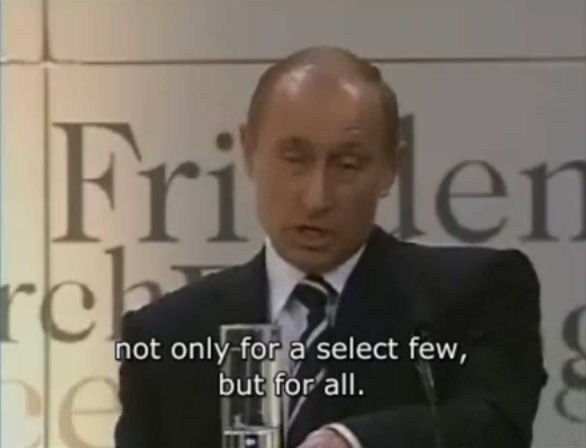 story that spans more than a thousand years and has practically always used the privilege to carry out an independent foreign policy. We are not going to change this tradition today. At the same time, we are well aware of how the world has changed and we have a realistic sense of our own opportunities and potential. And of course we would like to interact with responsible and independent partners with whom we could work together in constructing a fair and democratic world order that would ensure security and prosperity not only for a select few, but for all.”
story that spans more than a thousand years and has practically always used the privilege to carry out an independent foreign policy. We are not going to change this tradition today. At the same time, we are well aware of how the world has changed and we have a realistic sense of our own opportunities and potential. And of course we would like to interact with responsible and independent partners with whom we could work together in constructing a fair and democratic world order that would ensure security and prosperity not only for a select few, but for all.”
That latter statement, “a fair and democratic world order that would ensure security and prosperity not only for a select few, but for all”, shows without doubt they’re indeed still headed for world communism. In these extracts one can see as clear as the blue sky that the unchanged Soviets will do everything to manoeuvre American military presence out from the European continent, engage the Europeans in an ever tighter co-operation in all spheres that would finally mean a merger between the EU and the so-called Russian Federation, on communist terms, and leave the U.S. in complete political and military isolation. Given Putin’s mentioning of the growing economic and political power of Brazil, Russia, India and China (the so-called BRIC states; indeed bricks in their ever rising all-communist world architecture), one can see coming on the horizon what Stalin once said had to be achieved: the change of the encirclement of socialism by capitalism to the encirclement of capitalism by socialism. Putin’s speech was an open demonstration of unchanged Soviet hate against the one great obstacle on their way to an all-communist world, the United States of America; and the psychological effect on quite a number of Western politicians seems indeed to have been devastating.
January 2008, Gulf of Biscay: Russian battle ships and aircraft hold military manoeuvres just off the Atlantic coast of NATO members France and Spain! A Russian Navy spokesman proudly terms it “the biggest exercise of its kind in the area since Soviet times.”
February 14, 2008, Moscow: Again, Happy Valentine’s Day! Outgoing President Vladimir Putin gives the last international press conference of his (second) term as President of the Russian Federation. The thing lasts, Soviet-style, about five (!) hours, and even surpasses in aggressiveness his speech of February 10, 2007 in Munich. Adrian Blomfield writes in his February 15, 2008 article “Vladimir Putin’s nuclear threat to the West” on The Telegraph’s website, “Vladimir Putin has delivered perhaps his most menacing tirade against the West yet, repeating threats to train nuclear missiles on Europe and warning of unspecified retaliation if Kosovo declared independence. Addressing his last press conference as Russian president, Mr Putin mounted a defiant display that demonstrated more emphatically than ever the widening gulf between Moscow and its former Cold War rivals. In a vintage performance, the former KGB spy laced almost five hours of invective with crude insults, threats and admonitions often expressed in the argot of the Russian street. Reserving his greatest ire for the United States, which he accused of harbouring a colonial mentality towards Russia, Mr Putin again said that Europe would pay the consequences for a Washington-backed plan to erect a missile shield in Poland and the Czech Republic. ‘Our generals, our security council, consider these moves a threat to our national security,’ he said. ‘We asked our partners to stop but no one listened to us. So if they continue we will have to react appropiately by retargeting our missiles.’ Mr Putin also made similar threats against Ukraine if it joined Nato. The Russian leader – often accused of returning his country to a state of autocracy – portrayed his nuclear threat as an act of democratic generosity, saying he was acting in the interests of Europeans who opposed American military expansionism. […] He told Western observers who refused to monitor the forthcoming election, widely seen as a sham, that they should ‘rather teach their own wives how to cook cabbage soup.’” [!!!!!] – The world has now been on the brink of World War III for quite some time, and Putin’s sinistre ‘recommendation’ to the West their wives should learn how to cook cabbage soup is along the same lines as Gorbachev’s threat of Dec. 10, 2011 that Germany could have had on New Year’s Eve 2011/12 full dinner tables for the last time. The message: prepare for poverty and hunger, because we are going to crush you. And the cabbage soup comment even contains an additional element: the Western societies, by decades of communist/feminist indoctrination, will be completely HELPLESS; with men unable or unwilling to fight, and women who know nothing about the basic necessities of survival in a time of crisis or war!!!
May 9, 2008, Moscow, Red Square: The first Victory-Day parade on Red Square, after three years of ‘nostalgic’ parades, that displays again, like in Soviet times, Russia’s ‘military power’. Russian propaganda outlet ‘Russia Today’ (RT) starts its live broadcast with the following Soviet-to-the-core design:
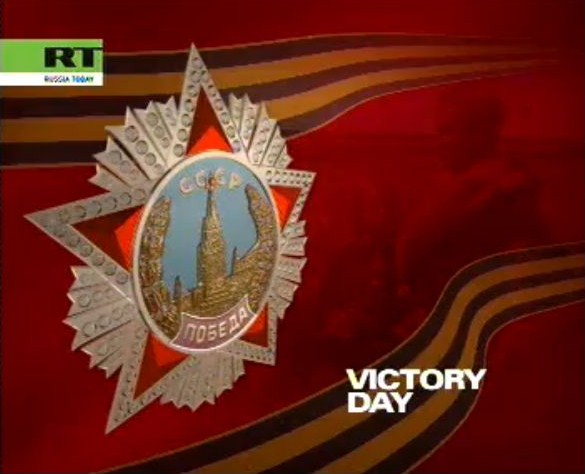
This is NOT made up! It’s the present allegedly ‘post-communist’ Russian reality that in fact differs not one iota from the former reality under overt Soviet communism. Yet, hardly anybody in the West seems to have asked himself why supposedly post-Soviet Russia is so much in love with its Soviet “past”!!! You have depicted here the highest military decoration in the Soviet Armed Forces for WW II service (made of platinum, rubies, and 150 diamonds!), the Order of Victory (“ПОБЕДА”), showing Spasskaya Tower on Red Square and in front of it the inevitable Lenin Mausoleum. As this is an original Soviet award, you of course get the Soviet Union’s acronym on top: “CCCP”, i.e. USSR. Yet, Victory Day has always had a double meaning: pompously celebrating Soviet victory in 1945, but also anticipating all-encompassing global victory for world communism! That second meaning has acquired much greater relevance and actuality today.
RT’s presenter of this propaganda farce, an Englishman by name of Kevin Owen, asks his studio guest Sergey Lebedev, Managing Director of the “Ligerion Group” and military consultant (not the Sergey Lebedev who was until 2007 Director of Russian Foreign Intelligence and is now the Executive Secretary of the CIS), why this event is “bigger than in recent years”. Lebedev’s cryptical answer, in stiff Soviet-English prose: “Well, ahhh, actually, ahhh, parade is a tradition [sic!] of this country, and this year specifically the combat material is returning to the scene, and it’s going to be part of the show.” (A classic non-answer! However, there might be very much an explanation that Mr. Lebedev carefully hid from us: After all, 2008 was the year when Marxist-to-the-core Comrade Obama strove for presidential nomination and was finally elected President of the United States. Everybody should check out on the web the two interviews, as audio-files, with computer expert Tom Fife – one time at Jeff Rense, the other time and more in-depth at Jeff Nyquist, both also given on this blog in full transcripts done by this author, as can be found in the parallel article, ‘Forward, Comrades! Not Back!’ – America and the World in the Brink to Global Communism -, where Mr. Fife spoke about a very peculiar incident back in early 1992 at a Moscow farewell party with Russian business partners with whom he and other Westerners were engaged in a joint venture: there was a heated argument on that evening, or rather a monologue, by the host’s wife, a committed communist, who – never mind that the USSR had been officially abolished two months prior – boasted that America would in due time have a black president, and he would be a communist, a Soviet; he was already around, had attended America’s elite universities, was “Ivy League”, he had a white American mother and an African father, he grew up in Hawaii; he would be irresistable for Americans, and he would be a great blessing for world communism; his name was Barack. – As one listens to these interviews one can’t help sensing that Tom Fife is telling the truth, which in that case would mean that America has already been, since that chaotic inauguration on January 20/21, 2009 and without knowing, in a state of post-revolution!!! Obama, now that he is re-elected, has already begun showing a quite different face from what he has shown so far, as his task is obviously to push the United States right into full-blown communism, which he and his wife already in their 2008 campaign, remember, quite openly said they would.) Owen: “Combat material. What are we talking about there?” Lebedev: “We are talking about the hardware, the military hardware.” Owen: “Okay, so, we are seeing, what, tanks, and big military hardware like we saw back in the nineties?” Lebedev: “Yes, exactly. And I’d say that the nation was expecting for this event for a long time.” [sic!] … Owen: “How important is it to Russia, Sergey, and Russians, in 2008, 63 years on?” Lebedev: “Well, I’d say it’s very important because the country underwent very serious changes, and there were difficult times during this reform [a coded confirmation of the unbroken continuity from the overtly communist era to ‘post-Soviet’ covert communism], and the nation needs certain good landmarks, this is primarily the internal event and importance. But, on second thought, we have to remind that Russia is also a serious player in the world arena, it has its national interests, and it should have certain tools to protect them.” – A threat. The truth is the Soviet military has never been meant and still today is not meant as a defence force but as the means to eventually overwhelm and crush the West, whether by its actual use or by mere military blackmail.
By the way, it’s worth comparing these May 9th parades since 2008 to those until 1990 (as presented, e.g., on the propaganda Youtube channels “RedSamurai84” and “RussiaToday”): The whole procedure and atmosphere are absolutely identical! More than that, the rapid changes that have taken place in the past decades in the West, and not to the better, seem to have left the continuing USSR completely untouched: as one watches closely the faces of the young, of the old, of the military, there is not the slightest difference between, say, 1985 or 1990, and 2008! Lest we forget, there had been no 1968 in the Soviet Union, no drug pandemic like in the West, no anti-authoritarian education, no ‘peace’ movement, no undermining of patriotism, no gay movement, and so forth. The West had been brought down by these Leninist/Gramscian/Frankfurt School subversion strategies; the communist bloc, in contrast, had stayed the same, which is why they can now come up and teach the West ‘old-fashioned’ discipline and ‘manners’. (Also, Minister of Defence and soldiers address each other in unchanged communist fashion by “TОВАРИЩ”, Tovarishch, thus: “Comrade”, which is still the official way of address in Russia’s military!) The only differences remaining the Lenin Mausoleum being hidden behind huge scenes, the leadership therefore standing not on top but in front of it, no huge Lenin portrait covering the fassade of the reactivated shopping centre Gum opposite to the Kremlin wall, and the Defence Minister these days being not an army general but a ‘civilian’.
May 9, 2010, Moscow, Red Square: This time, the Soviets achieved a special propaganda coup: In the Victory Day parade participated units of the three WWII allies, United States, Britain, and France. As they were marching to Soviet military music and rendered their military salute to the leaders of the unchangedly totalitarian Soviet state, with whom they had been for so many decades (and still are) in a life-or-death struggle, one inevitably felt reminded of the Olympic summer games of 1936 in Berlin when also then the British and French delegations gave their salute to Adolf Hitler. History is repeating itself.
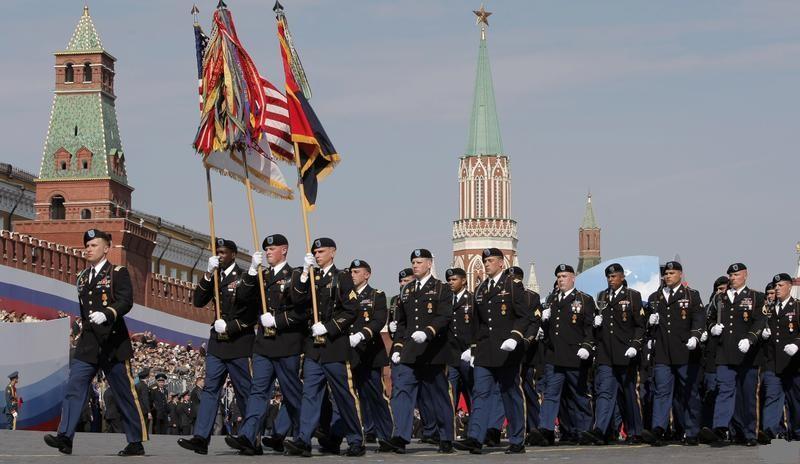
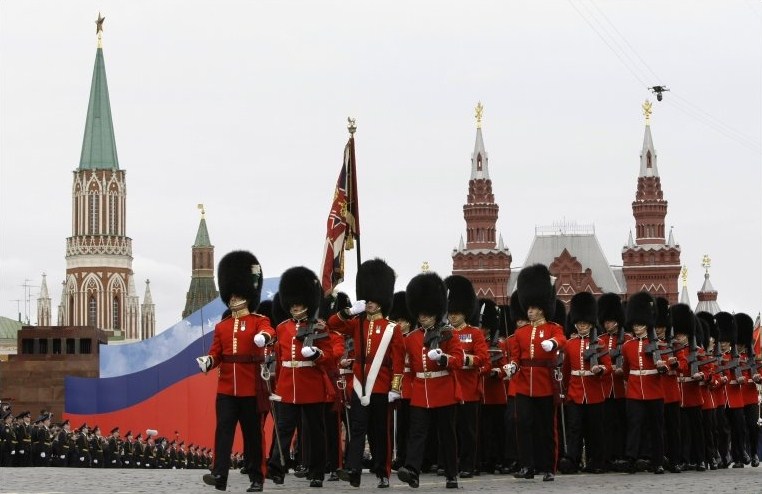
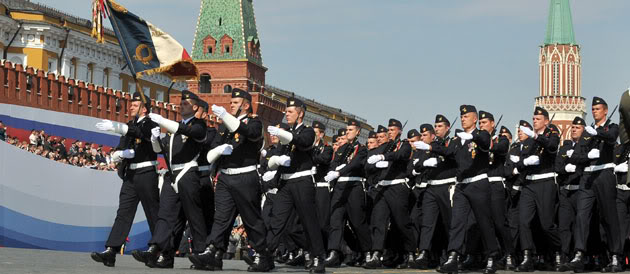
l
If one looks at the list of “foreign” statesmen attending, the Parade was, with the sole exceptions of German Chancellor Angela Merkel (herself a “former” East German communist) and Israeli President Shimon Peres (a lifelong socialist), an all-Soviet resp. all-Eurasian-communist gathering. How come? British Prime Minister Gordon Brown was in the middle of an election campaign; U.S. President (if we can call him that) Barack Obama had whatever other things to do; then-French President Nicolas Sarkozy and Italian Prime Minister of the day, Silvio Berlusconi, were busy with fighting the European monetary crisis; whilst the Russian Federation vehemently refused as alternative guests the Prince of Wales for Britain, and Vice President (if we can call him that) Joe Biden for the United States (the ambassadors of the U.S. and Britain to the Russian Federation attended, instead). Thus, the all-communist who’s who present reads as follows: Hosts Dmitriy Medvedev and Vladimir Putin, at the time President and Prime Minister of the ‘former’ RSFSR and now-Russian Federation; Nursultan Nazarbayev, President of the ‘once’-SSR of Kazakhstan; Gurbanguly Berdimuhamedov, President of the ‘once’-SSR of Turkmenistan; Emomalii Rahmon, President of the ‘once’-SSR of Tajikistan; Ilham Aliyev, President of the ‘once’-SSR of Azerbaijan; Serzh Sargsyan, President of the ‘once’-SSR of Armenia; Toomas Hendrik Ilves, President of the ‘once’-SSR of Estonia; Valdis Zatlers, President of the ‘once’-SSR of Latvia; Eduard Kokoity, ‘President’ of the renegade Georgian territory of South Ossetia; Sergei Bagapsh, ‘President’ of the renegade Georgian territory of Abkhasia; the remaining 7 “ex”-Soviet republics, Ukraine, Belarus, Lithuania, Georgia, Moldova, Kyrgysztan, and Uzebekistan were not represented, possibly not to make it too obvious. From outside the “former” Soviet Union, but still from within the communist bloc, had come: Hu Jintao, then-President of the People’s Republic of China; Tsakhiagiin Elbegdorj, President of the “once”-People’s Republic of Mongolia; and Nguyen Minh Triet, President of the Socialist Republic of Vietnam; as well as from the “former” Eastern European satellites, Bronislaw Komorowski, President of Poland; Vaclav Klaus, President of Czechia; Ivan Gasparovic, President of Slovakia; Georgi Parvanov, President of Bulgaria; only Hungary and Romania were not represented. Finally, from former Yugoslavia (that had always been an informal but integral part of the Bloc), had come all leaders except the one from Bosnia-Herzegovina: Boris Tadic, President of Serbia; Ivo Josipovic, President of Croatia; Danilo Türk, President of Slovenia; Gjorge Ivanov, President of Macedonia; and Filip Vujanovic, President of newly ‘independent’ Montenegro.
The question now arises: What does Germany as the only ‘Western’ guest nation except Israel have to do in such an obvious all-communist assembly? Well, as Christopher Story and others have repeatedly pointed out, the German reunification of 1990 was in fact NOT, as was widely believed, a process of large and economically powerful West Germany ‘swallowing’ and thus annihilating communist East Germany, but very much on the contrary of communist East Germany being put in the position to massively infiltrate, subvert, and revolutionise a West German society that was in no way prepared for such an undeclared ideological offensive; after all, communism – according to the official narrative – had gone out of business. The disastrous result of this merger, that was solely to the detriment of the West Germans, can be seen today in the astonishing instance that present-day-Germany has both as head of state and as head of government respectively, a figure from the communist East: as for the former, an alleged once-Pastor and ‘regime sceptic’ but in fact protégé, who nevertheless sees no need to legalise his wild marriage now that he is Federal President of Germany, by name of Joachim Gauck; as for the latter, of course, Angela Merkel as Chancellor. Although her pre-1989-biography has been widely deleted (as has been common routine with the instant-democrats of the “former” communist world), it has become known that she was in no way a silent dissident under the communist system of East Germany, but rather grew up as part of the communist state and Party elite (her father, a ‘Pastor’ from Hamburg, West Germany, but ardent communist, changed sides in late 1954, brought his young family with him, and became a powerful GDR ‘church apparatchik’ known under “the Red Kasner”). Angela Merkel, then Angela Kasner, was even ‘privileged’ enough during her university years to partly pursue her Physics studies at a university in the Soviet Union. The family was also allowed – in the 1970s! – to travel to Western countries such as Italy. Merkel later became a tough agit-prop secretary in East Germany’s communist youth organisation, “Freie Deutsche Jugend”, and was there responsible for ‘culture and political education’. So, there’s no doubt she is a communist plant (though most Germans even today, unable to understand the incurable mindset of Marxists-Leninists, view her as a simple political opportunist), well-placed right from 1990 in West Germany’s Christian-Democratic Party, CDU, right under the wings of then Chancellor Helmut Kohl, who generously promoted Merkel’s CDU career, until he lost power in 1998 and became nationwide persona non grata due to a greatly exaggerated party donation affair in 1999, whilst she showed in that critical moment her true communist face and let him fall. In 2000 finally she became Party chairman, and in 2005 German Chancellor. Helmut Kohl, on the other hand, will soon have turned into a widely forgotten footnote in the reunification process of the two German states. Anatoliy Golitsyn called this communist practice of silent outmanoeuvering and takeover “cuckoo egg” politics: once the foreign chick hatches, it starts dominating the nest; a pattern we can now see everywhere in the Western world. Also, Merkel’s policies have in no way brought a return to a more conservative line compared to the preceding Red-Green government in power from 1998 till 2005; instead she has seamlessly continued the revolutionary path begun by Gerd Schröder and Joschka Fischer, two first-class declared Western Marxists, who were now followed in 2005 by a plain Marxist-Leninist from the communist East. Reunified Germany today has in fact become a communist state, as are most member states of the European Union now in a fast transition process to what will inevitably turn out as plain, hard-core communism.
Towards the end of the parade, by the way, the “European Anthem” was played, i.e. Schiller’s Ode to Joy from Beethoven’s 9th Symphony, firmly underlining the Soviet objective openly declared since the late 1980s of a “Common European Home from the Atlantic to Vladivostok”, in plain English of course: a unified Eurasian communist monolith with a free Western Europe having become a thing of the past. And we’re almost there already!
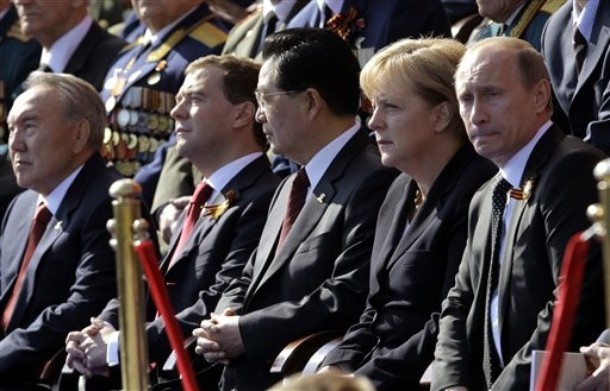
“Former” East German communist and now Chancellor of a (communistically) unified Germany, Angela Merkel, carefully watches the military parade on Moscow’s Red Square, while ‘beautifully’ framed by her Marxist-Leninist comrades (from left to right): Nursultan Nazarbayev (Stalinist dictator-president of Kazakhstan), Dmitry Medvedev (then-President and now-Prime Minister of the Russian Federation), Hu Jintao (then-President of the People’s Republic of China), and Vladimir Putin (then-Prime Minister and now-again President of the Russian Federation): Germany (and along with it, the European Union) is visibly part of the Russian-China military axis; with the U.S. being effectively isolated and even in the grip of a shadowy clique of communist revolutionaries itself!
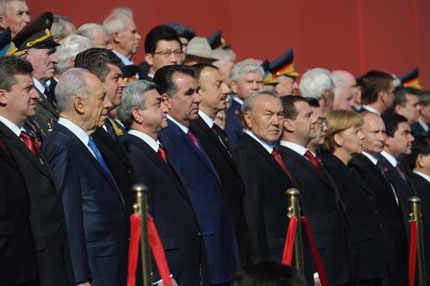
Shimon Peres (a lifelong socialist) and Angela Merkel (an “ex”-communist): the only ‘Western’ guests on Moscow’s Red Square in the midst of an all-communist gathering!!!
Also, the 2010 Victory Day Parade was the first in the ‘post-Soviet era’ in which the old and since the year 2000 restored Soviet Stalin anthem was again played, and so in front of troops from the U.S., Britain, and France!
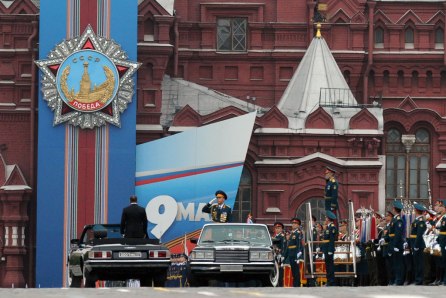
Finally, the commanders’ limousines are now for the first time pitch-black, outside and inside, instead of formerly light-grey; which adds to the intimidation (picture from the 2012 Victory Day Parade)
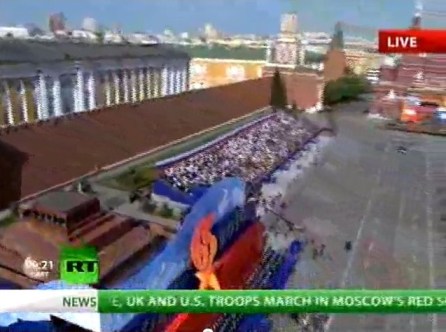
A clever way of ‘hiding’ and at the same time showing the Lenin Mausoleum. An overhead camera serves the trick! So happened on May 9, 2010, and so for the first time. Hence, each year they ‘restore’ the old Soviet Union a little bit further. The day it will be officially again the USSR will be of course a traumatic day for the West that will then see that it has been duped over all those years and has now ended up trapped and defeated.
November 7, 2010, Moscow, Red Square: For the first time since the fake dissolution of the Soviet Union, it seems, also a Revolution Day celebration was held on Red Square. Not a military parade with armory but nevertheless a parade with some military units and Komsomol youth, commemorating officially the Revolution Day parade of 1941 (not the October Revolution itself, “of course”…). The marching blocks of the youth organisations are being welcomed by the speakers, in good old Soviet fashion, as ‘activists’ and ‘patriots’. There is also some theatrical re-enacting of the Red Army’s fight, starting in 1941, against the nearing German armies. The salute is not taken by the President of the Russian Federation but by the Moscow Mayor, but it can be expected that sooner or later also November 7th will return to being an annual full-scale military parade in the old Soviet format. They’re merely letting go of their temporary democratic mask step by step. Some impressions:
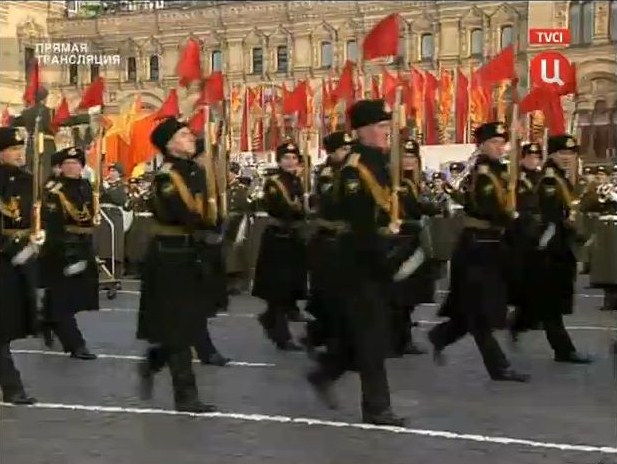
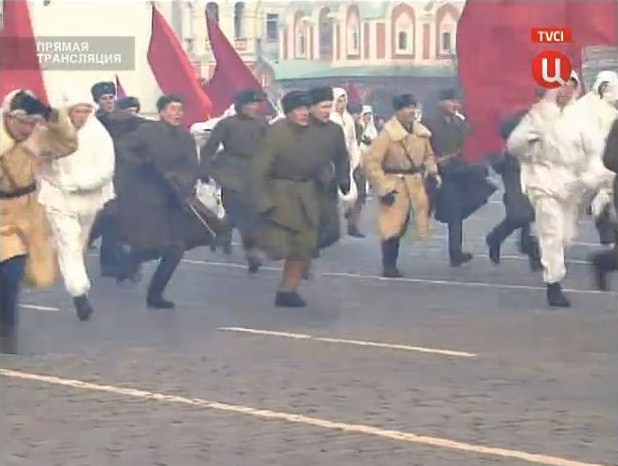
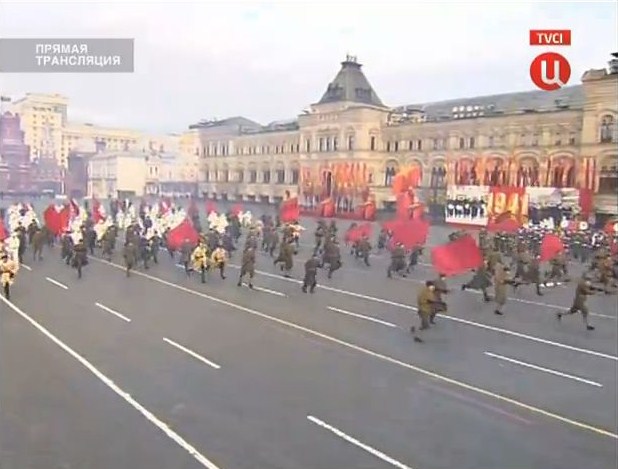
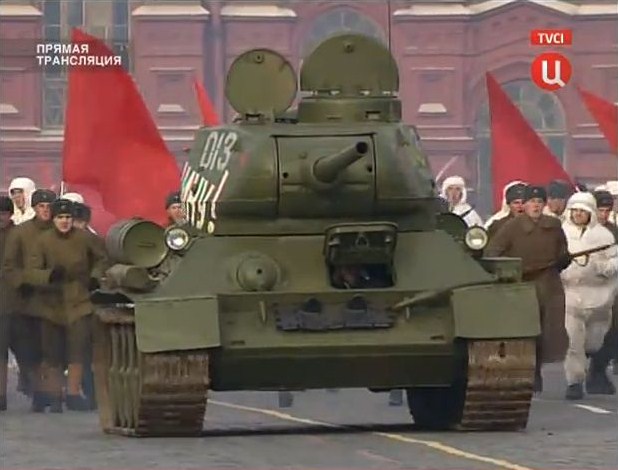
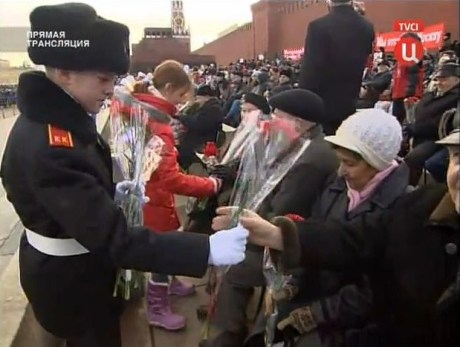
l
As one watches these parades, as well as the overall revived revolutionary spirit and self-esteem of the Leninst state (also, if not particularly, among the young), one can’t help feeling reminded of Nazi Germany’s infamous propaganda minister Joseph Goebbels when he boasted that others may have to rely on the force of guns to control their people, but that the German National-Socialist state, in contrast, had achieved to win over the very hearts of the people, thus its success. It seems the “post-Soviet”, pragmatic Leninists of the Andropov stream have meanwhile mastered this art as well. It’s no longer the “dictatorship of the proletariat”, but the “state of the whole people”.
November 8, 2010, off the coast of Los Angeles: A mysterious missile launch some 35 miles off the Southern Californian coast resulted in widespread uncertainty and confusion. All DoD entities positively confirmed there had been no missile test. At the same time, the Pentagon ruled out that it could have been a missile launch by a foreign power, coming up with the ridiculous explanation it must have been an airliner or a “toy rocket”. Yet, former U.S. Ambassador to NATO as well as former Deputy Secretary of Defense Robert Ellsworth identified the projectile as “a big missile.” Also, retired U.S. Air Force Lieutenant General Tom McInerney’s assessment was, “Look, this is not an airplane because of the plume, and the way you see that plume. Airplanes do not con at sea level or 5,000 feet like that. I spent 35 years flying fighters, and I never saw an airplane con like that. That is a missile, it’s launched from a submarine, and you can see it go through a correction course, and then it gets on a very smooth trajectory, meaning that the guidance system is now kicked in, it’s going at about 45° away from you, that’s why you are not seeing a lot of vertical velocity.” Could it have been a Chinese or (Soviet)-Russian missile fired from one of their super-quiet submarines?
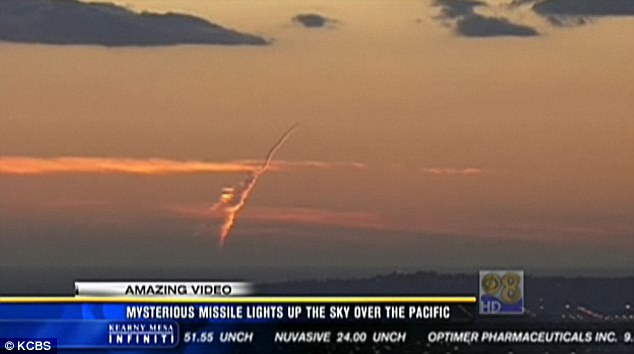 l
l
May 9, 2011, Moscow, Red Square: The Victory Day parade starts with the grim WW II song “Sviashchennaya voyna” (The Sacred War) written in 1941 by Alexandrov, the composer also of the Soviet anthem of 1944. The lyrics, then applied to invading Nazi Germany, might well be directed today to the “decadent imperialist” West: ”The huge country is rising / Is rising for the deathly battle / Against the dark fascist force / Against their cursed hordes – (Refrain:) Let our noble wrath / Seethe like waves / The national war is going / The Sacred War – Will resist the oppressors / Of right notions (ideas) / Rapists, bandits / People’s tormentors – Refrain – Don’t their black wings dare / Fly over our Motherland / Don’t the enemy dare tread / Our immense fields – Refrain – Let us put a bullet into the brow / Of the rotten fascist vermin / Let us make a strong coffin / For such breed – Refrain”. One can ask whether this has still anything to do with “commemoration”. It rather feels like a call to battle here and now!
There have been many more explicit World War III threats (it’s clear they are now trying to impose their will on the West, and be it through war), from both Russian and Chinese Generals as well as from the political leadership, usually whenever the West tries to act in ways that could interfere with the communist goal of complete world domination. First it was George W. Bush’s project of stationing defence missiles in Poland (that was cancelled by successor Obama) and the question of Kosovo’s independence from Serbia; then it was the Georgia crisis in August of 2008; now it is a downgraded American plan for missile stationing in Eastern Europe; the permanent tensions with Iran; and the situation in Syria (a close satellite country that Russia and China are determined to defend). Furthermore, there are the unresolved Taiwan question, recurring tensions between North- and South Korea, and a number of other issues in the Far Eastern region. Not to forget Russia’s repeated intrusions into Swedish, Norwegian and British airspace and the revived permanent reconnaissance flights of their (upgraded) propeller ‘Bear’ bombers; the latter being possibly more of a symbolic act.
But there occurred one more major incident on December 10, 2011 in Munich, Germany: Mikhail Gorbachev was there and received from the conservative Hanns Seidel Foundation their Franz Josef Strauß Award. His acceptance speech, however, turned into a brutal Leninist attack speech, full with contempt and ‘schadenfreude’ against the West, combined with very serious undertones of military blackmail, basically telling us: Accept communism or face World War III! Do read this speech (as well as the rest of that treatise) in chapter 6 of a closely related article on this blog: ‘Forward, Comrades! Not Back!’ – America and the World on the Brink of Global Communism.
l
6. CASE STUDY I: NOVEMBER 9, 2009, 20th ANNIVERSARY OF THE FALL OF THE BERLIN WALL (“20 JAHRE MAUERFALL”): A SPECIAL CELEBRATION FOR THE COMMUNISTS
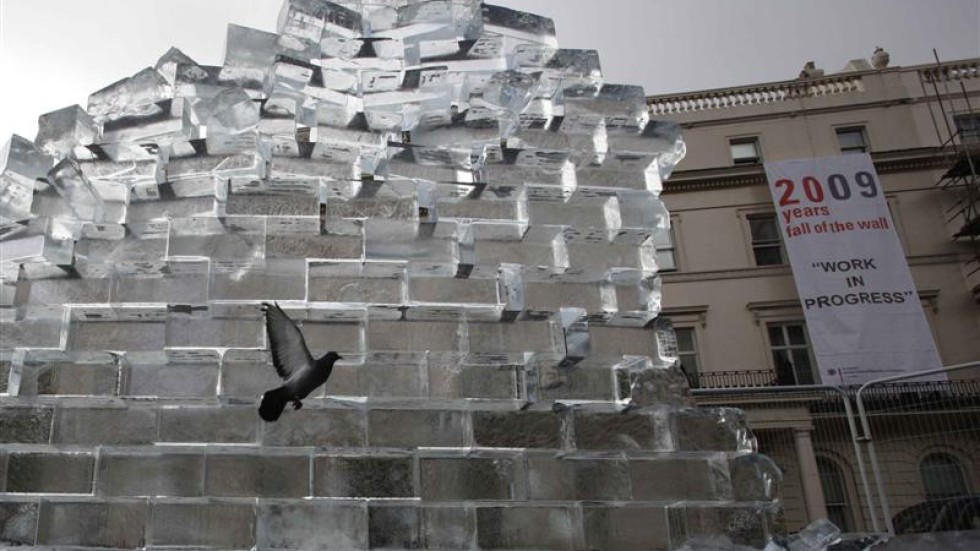
November 9, 2009, in front of the German Embassy in London: Note the banner in the background: Underneath the motto “2009: 20 Years Fall of the Wall”, one can read the stranger-than-strange maxim, “Work in Progress”, all kept in communism’s favourite colours red and black resp. grey. This is clearly yet another display of utmost Leninist boldness: first, both ‘work’ and ‘progress’ are key words in the communist vocabulary. Second, ‘work in progress’ reveals the objective (as well as outcome) of the events of 1989: the furtherance of the world revolution, that truly is – the word ‘revolution’ expresses it anyway – a never-ending ‘work in progress’ indeed. Berlin: the launching base of the long-prepared-for offensive, that gained tremendous momentum through the reunification of Germany. The whole world: the building-site for overall communist victory! The symbolism of the wall made of ice-bricks in the foreground of the picture (created by the English/German artist couple Manon Awst and Benjamin Walther) is rather striking as well: this wall doesn’t need tearing down, it simply melts away and dissolves into the air, just like the communist strategists accurately foresaw the ‘magical’ removal, in the perception of the West, of the image of the enemy. The unchanged Leninists are true adepts in deception and psychological warfare! – Also, this wall of ice bricks seems to contain an additional connotation: it was Gorbachev’s demonic ‘heat’ that so wonderfully broke the Iron Lady’s ice!
The 20th anniversary celebrations of the fall of the Berlin Wall had been planned, with German precision and renewed German self-esteem, both as an impressive spectacle for the world and a colourful party for the people of Germany. And statesmen and elder statesmen, liars and liees (or co-liars) alike, attended the commemoration at the Brandenburg Gate. Not among them, ironically, were the two who so greatly but erroneously had taken pride in ‘having faced down communism’ and ‘having won the Cold War’, Ronald Reagan and Margaret Thatcher. Former President Reagan was no more alive; Baroness Thatcher had not come to Berlin, probably due to bad health. The third conservative of 1989, former German Chancellor Kohl, did cover a tight schedule during the whole day, but too was now very weak, notwithstanding his being widely forgotten if not persona non grata in Germany since the so-called CDU donation affair of 1999. In other words, and this is symbolic, those who were triumphing then, were either dead or appeared beaten today. Which left the scene almost completely for Gorbachev, who seems to be acting with even greater vigour and resoluteness now than as General Secretary back in the 1980s, so obviously looking forward to the nearing completion of the world revolution. Among the old guard that did attend, however, were Henry Kissinger and Hans-Dietrich Genscher, who according to Christopher Story had been working through their entire careers as Soviet moles within their respective political surroundings.
Yet, still hours ahead of the main festivities at night, there was set up i.a. a highly questionable ‘celebration’ at the former checkpoint “Bornholmer Straße”, the first border crossing to be opened in the events of November 9, 1989. In a re-enactment of sorts of the ‘Trabant invasion’ of 1989, Angela Merkel and some 100 former ‘dissidents’ and ‘democratic activists’ of the communist German Democratic Republic were solemnly if not triumphantly marching across that bridge known as Bornholmer Brücke but correctly named Bösebrücke, and they did so, of course, starting from their old communist East into what once was the French sector of West Berlin (and not the American or British sector!). Among them were the East-West-communist chansonnier Wolf Biermann (who was also the stepfather and artistic mentor of East German punk diva and certainly agent of influence once she arrived in the West, Nina Hagen) and the plain East-German Joachim Gauck, a GDR-church-politico who claims to have been suffering political persecution, but in fact was friendly with the communist regime and enjoyed privileges unknown to the ordinary East-German (ironically it was him who oversaw the agency responsible for processing the archives of the former East-German state security, MfS, a.k.a. “Stasi”); today, he defines himself, in classical Leninist fashion, as a ‘left-liberal conservative’ (sic!); his candidacy for the German State Presidency in 2010 was indeed supported, albeit not by the successor of the East-German SED, “Die Linke”, but nevertheless by both Social Democrats and (Red-)Greens; much worse: after a suspiciously hyped corruption scandal against recent German State President Christian Wulff, which led Hr. Wulff to step down from office on February 17, 2012, within two days, CDU-CSU, SPD, Free Democrats, and Greens (in other words, all parties represented in the German Bundestag, except for “Die Linke”) agreed that Joachim Gauck should be Germany’s next State President; he was then elected on March 18 and inaugurated on March 23, 2012; the change in the highest office of Germany will certainly move the country by yet another great leap towards becoming a full-fledged communist state. Never mind that Hr. Gauck stubbornly refuses to bring his family life in order so to suit his new position: though once having been a Protestant pastor, he lives in separation from his wife and instead in a “wild marriage” with another woman: you see, they are communists, and they spit on everything of old! – Back to checkpoint “Bornholmerstraße”. Now, why did the ‘collapsing’ GDR decide to first open a border crossing named by them in 1948, and still named today, after a German communist by name of Wilhelm Böse (the surname translates to ‘evil’), who had been sentenced to death by the Nazi regime in 1944, a communist ‘martyr’? And why, subsequently, was there this odd 2009 all-communist demonstration, this jolly and optimistic ‘Mayday Parade’, again over this bridge named ‘Böse Brücke’, i.e. the ‘EVIL BRIDGE’? Communism – which represents pure, concentrated evil and very much knows that it is evil – loves such insidious in-your-face audacity, especially when hardly anyone sees the forest for the trees anymore. Quite conveniently as well, this bridge had been initially opened in 1916, as Hindenburg Bridge, on a September 11th, the birthday of their highly revered founder of the Soviet Cheka, Felix Dzerzhinsky, and later-to-be death-day of the father of the new deception strategy, Nikita Khrushchev!
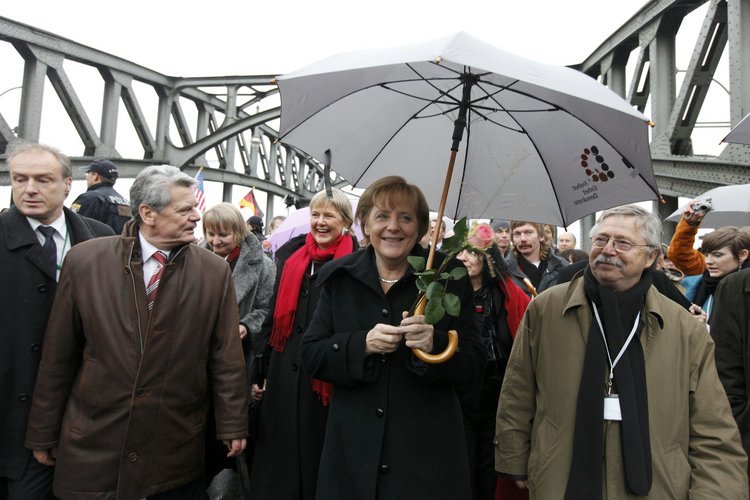
German Chancellor Merkel, flanked by (meanwhile new State President of Germany) Joachim Gauck (left) and leftist chansonnier Wolf Biermann (right): “for communists only”. All that was missing in this eery, complete-with-red-shawls, hardcore-communist manifestation (and let’s keep in mind that Angela Merkel once was a Secretary for Agitation and Propaganda in the East German communist youth organisation ‘Freie Deutsche Jugend’) would have been the intonation of the old communist East German anthem: “Auferstanden aus Ruinen, und der Zukunft zugewandt…” (“From the ruins risen newly, to the future turned, we stand …”). Poet Johannes R. Becher and composer Hanns Eisler knew, back in the year 1949, why they created an anthem metrically identical to the ancient Austrian “Kaiserhymne” in use as the national anthem of West Germany: For, the East-German (and pan-communist) political objective over all those decades, whatever ridiculed in the West, had been a re-unification of the two German states on communist terms. And they accomplished it, not by the use of tanks, but by the most perfidious deception ever in the history of mankind. And soon, all the mindless partying and cheering will give way in the former West to a solid sense of defeat.
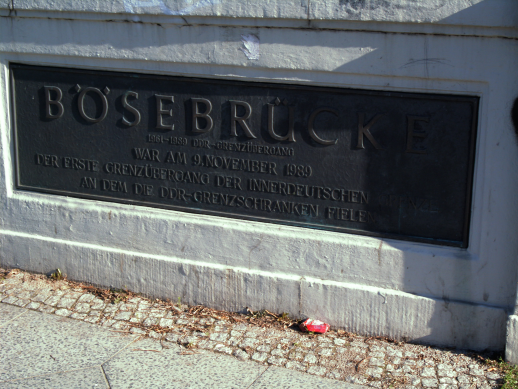
A commemorating tablet at Bösebrücke (Böse Bridge, i.e. ‘evil bridge’), applied in 1998, reminding of the events of November 9th, 1989. The simple fact that – say, the ‘changes’ had indeed been genuine, which they weren’t – this so important site still carries the name of the communist Wilhelm Böse (instead of, for example, again that of Reichspräsident Hindenburg after whom it had initially been named), doesn’t make any sense at all – unless, of course, the whole ‘collapse’ of communism was a hoax (which it was) and the subsequent reunification of Germany not a matter accomplished on the terms of the West but on communist terms! – Indicators indeed confirming this grim reality, even on the surface of things, are plenty. A quick check via Google Earth of the street names of East German cities and towns shows that all their ‘former’ revolutionary/socialist/communist idols are still being held in high regard: Voltaire, Alexander Pushkin, Karl Marx, Friedrich Engels, (they did away with Lenin), Maxim Gorki, Ferdinand Lasalle, August Bebel, Émile Zola, Rosa Luxemburg, Wilhelm and Karl Liebknecht, Clara Zetkin, Ernst Thälmann, Bertolt Brecht, Sergey Prokoviev, Yuri Gagarin, even Walter Ulbricht. Also, they still have streets, scattered across the country, with such ‘colourful’ ideological names as “Straße der Pariser Kommune” (Street of the Paris Commune), “Straße des Friedens” (Street of Peace), “Straße der Demokratie” (Street of Democracy), “Straße der Freiheit” (Street of Liberty), “Straße des Fortschritts” (Street of Progress), “Straße der Werktätigen” (Street of the Workers), “Straße der Zukunft” (Street of the Future), “Straße der Solidarität” (Street of Solidarity), “Straße der Opfer des Faschismus” (Street of the Victims of Fascism), “Straße des 8. Mai” (Street of the 8th of May), “Straße der Befreiung” (Street of the Liberation), “Straße der Republik” (Street of the Republic), “Straße der Arbeit” (Street of Labour), “Straße der Einheit” (Street of Unity), “Straße der Völkerfreundschaft” (Street of Peoples’ Friendship), “Weg der Freundschaft” (Way of Friendship), “Straße der Nationen” (Street of the Nations), “Straße der Jugend” (Street of the Youth), “Straße des Bergmanns” (Street of the Miner), “Spartakusstraße” (Spartacus Street; ‘Spartacus’, a name so widely popular in communism since its beginning, had been the codename of the forerunner, as we go back in history, of Marx and Babeuf: Adam Weishaupt, founder of the ultra-radical and hyper-Utopian Illuminati network, that indeed held those very same sick views and ideas of a completely egalitarian and collectivised society!), “Allee der Kosmonauten” (Alley of the Cosmonauts), “Platz der Vereinten Nationen” (United Nations Square), and so forth; you get the picture…
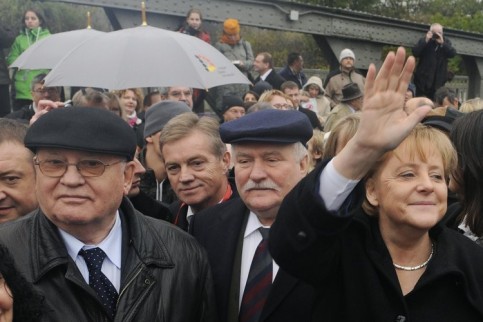
Fake ‘conservative’ Chancellor Angela Merkel with fake ‘reformer’ Mikhail Gorbachev and fake ‘independent trade union leader’ and ‘first democratic Polish President’ Lech Wałesa at Bösebrücke. What a display of all-communist harmony and friendship! (This photograph also provides, maybe, a good opportunity to look behind Angela Merkel’s ‘democratic’ mask: concentrate on her eyes, and you might sense pure Leninist evil…)
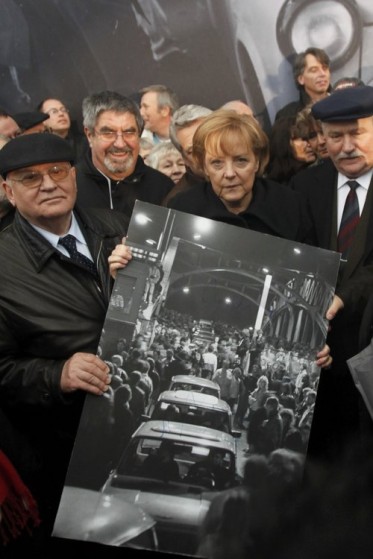
Mind the uniformly black clothes of these people (including those of Angela Merkel), the dark red here and there, the ‘workers’ caps’ of Gorbachev and Wałesa, the triumphant face of Gorbachev (he is wearing a leather jacket!), and the somewhat conspiratorial mood that lies over the scene. The message couldn’t be much clearer: WE won the Cold War, it is us who are now in control, and we are now building our world communist empire.
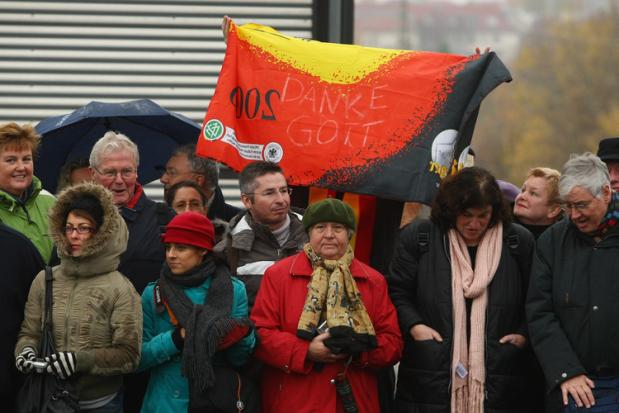
Reality upside down: Although the German reunification opened the door for West Germany to become a fully-fledged Communist society, these people “thank God” for it …
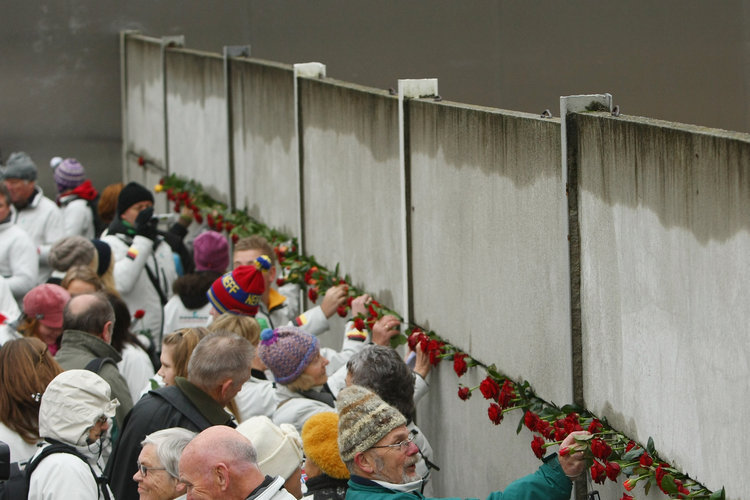
People put flowers at a remnant of the once Berlin Wall, in an apparent act of commemoration of that grim chapter of German history. Yet, how come they almost uniformly show up with deep red roses? Has their had some old East German propagandist his insidious hand in this, turning it all into a display of pro-communist nostalgia instead?
There took place a number of other high-profile events over the whole day. In the morning, there was held an (of course:) Ecumenical church service at Berlin’s Gethsemane Church, where Archbishop Robert Zollitsch, head of the German Bishops’ Conference, warned of “potential wall-builders” who still existed today, they shouldn’t be in charge, whether in society or in the churches (thus, he argued not only in favour of the post-Conciliar Catholic Church’s general theme of all-embracing inclusion, but also in favour of the essence of overall totalitarian intolerance masked as politically correct tolerance: all have to be one, or else…).
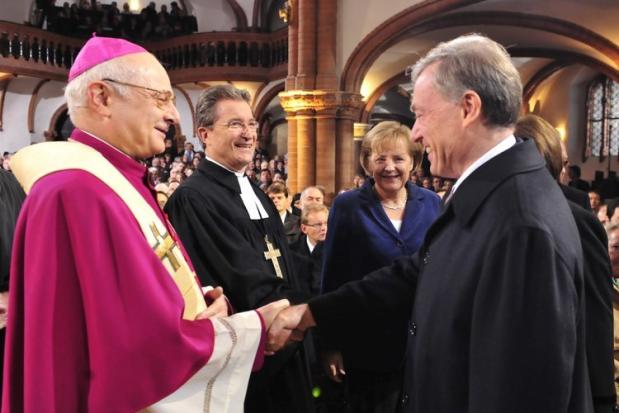
Left to right: Head of the German Conference of Catholic Bishops, Archbishop Robert Zollitsch; with former Chairman of the Council of the Evangelical Church in Germany, Bishop Wolfgang Huber; German Chancellor Angela Merkel; and then Federal President of Germany, Horst Köhler, presumably after the service at Gethsemane Church, Berlin.
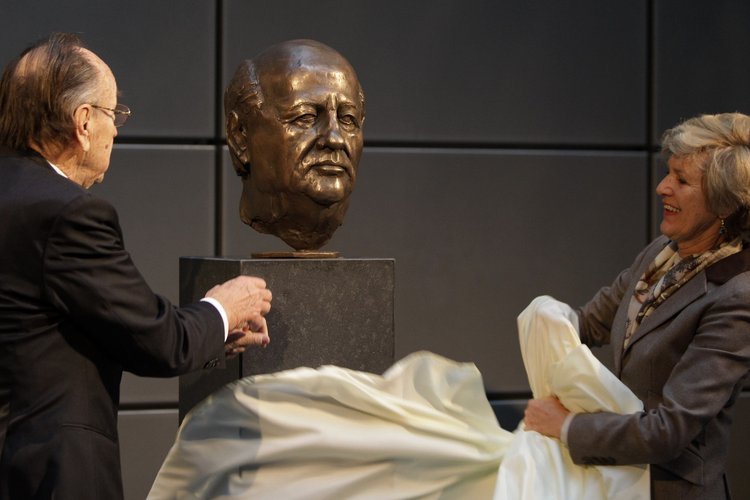
Shortly after, Gorbachev – who, given the tight schedule of successive events, hardly could have attended that church service – was honoured at the headquarters of the publishing house Axel Springer (once utterly hated by the extreme left). The doyenne of the mighty company, Friede Springer, along with German Foreign Minister of 1989, Hans-Dietrich Genscher, praised Gorbachev and unveiled a newly-made bronze bust of his. (There were no such honours for the late President Ronald Reagan, though!)
Chancellor Merkel then received U.S. Secretary of State Hillary Clinton at the Kanzleramt: kissy-kissy between a declared American feminist and a childless ‘former’ communist from ‘once-communist’ East-Germany. They afterwards met with German Foreign Minister Guido Westerwelle (like Berlin’s Mayor, Klaus Wowereit, a confessing homosexual) for a lunch of the dysfunctional, one could say.
In the afternoon, the politicos gathered at the annual Falling Walls Conference (‘International Conference on Future Breakthroughs in Science and Society’), a somewhat socialistic ‘brain-exchange’ platform, where Angela Merkel spoke on ‘Breaking the Walls of the 21st Century’.
In the early evening, finally, German State President of the day, ever politically correct Horst Köhler (who had once been Director of the IMF), received the lot of international state leaders at Bellevue Castle, quite a many of them from the ‘former’ communist satellite states of Eastern Europe (Switzerland, on the other hand, had not been invited to the celebrations, on the formal grounds that it is not a member of the European Union…)
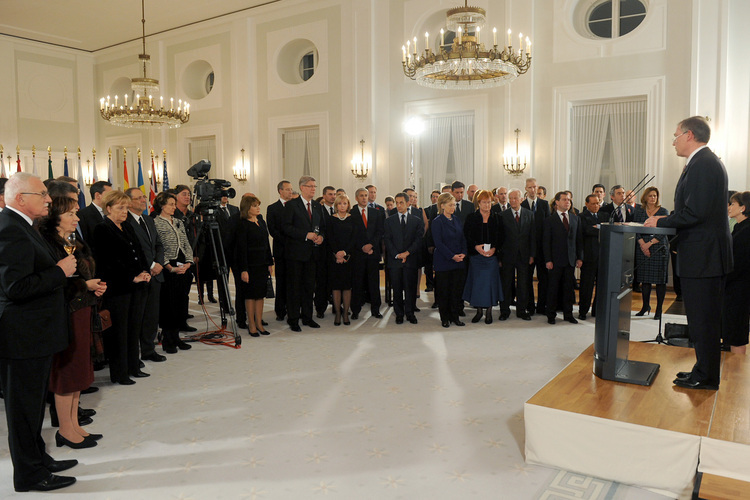
Note the almost abnormal body posture of Russian President Dmitri Medvedev standing left of Silvio Berlusconi at the righthand end of the semicircle! Although they now have a splendidly renovated Kremlin Palace, meanwhile also a brandnew Bolshoi Theatre, beautifully restored churches and monasteries throughout the country, nevertheless they themselves have remained the same old proletarian Bolsheviks and dry, technocratic apparatchiks. The new fassades shine brightly, but the content behind them is still as unpolished as ever (which is the more understandable the more one is aware of their unchanged communist despise for Western “bourgeois” etiquette).
By the time that reception was over, tens of thousands of Berliners and Berlin visitors had either reached already at the Brandenburg Gate or were on their way. The big “Fest der Freiheit” was to begin at 7 p.m.
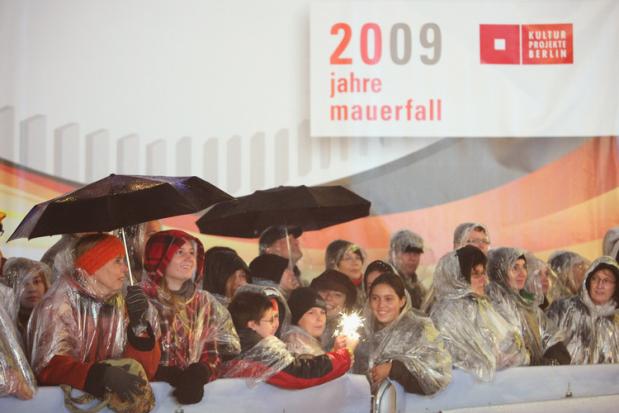
However, unlike during the day, there wasn’t just moderately wet weather but constant intense rain. Although people didn’t mind the inconvenience, there nevertheless remains an odd symbolism, ‘choreographed’ somewhere, regarding the fact that in reality there was nothing to celebrate AT ALL!!!
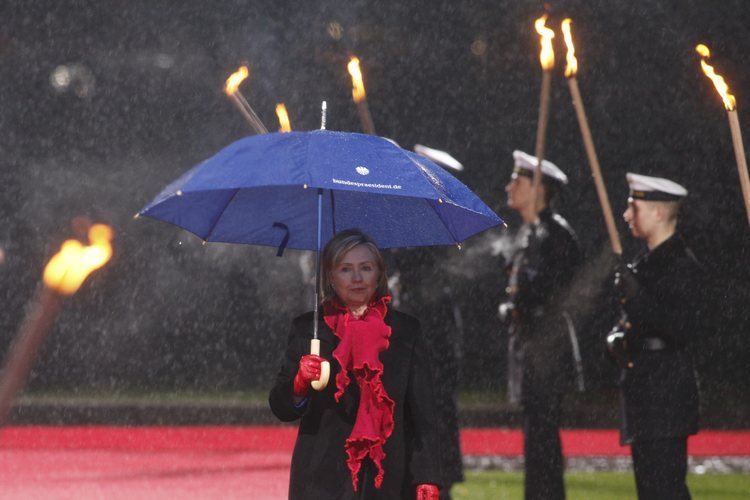
As one can see, Secretary of State Hillary Clinton perfectly met the communistic ‘dress code’ of the day!
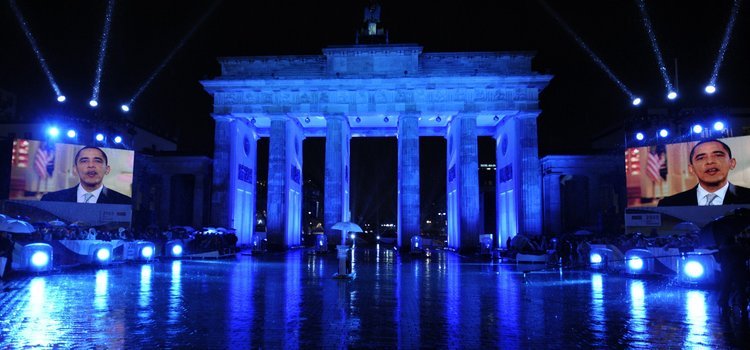
Concluding the series of solemn New World Order speeches by the state leaders and -representatives present, also the “New Tutankhamun”, via direct video-link from the White House in Washington, spoke to Germany and the world, whatever his wise-as-ever remarks may have been in detail (take note of his light-blue tie, a gesture of reverence towards the United Nations that has become a veritable fashion among politicians in recent years; also mind the frequent emphasis on blue in the light-shows of popular events nowadays, so clearly celebrating the “cold light of the Enlightenment”, or to be more specific: the cold light of Lucifer!).
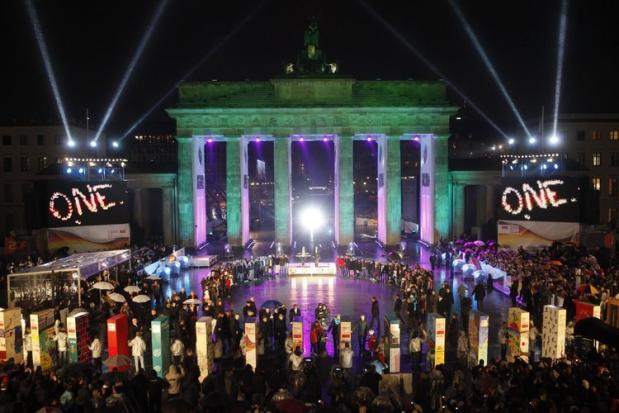
Following the official part of the celebration, entertainment, though just as political (resp. ideological), had its way. Bon Jovi sang their pathetic “We aren’t born to follow”, which couldn’t have been further from the historical truth of 1989, but revealed another key characteristic of communism: neglect and rebellion, the root of which is nothing else but Satan’s rebellion against God; communism isn’t about politics, or society, or economy, it is about complete destruction of the God-given order. Period! – Then came a soft and cosy tune entitled “We Are One” by East-German DJ Paul van Dyk alias Matthias Paul and sung by Irishman Johnny McDaid. Let’s remember that in that same month of November 2009 the newly designated President of the European Union, Herman van Rompuy, declared the year 2009 as the “first year of global governance.” Following so much “Oneness”, also the German TV-channel ARD added from early 2010 to its usual ARD-logo the maxim “Wir sind eins”, thus: “We are one”. At the exact same time, also the Austrian Broadcasting Corporation, ORF, changed the logo for its first channel from “ORF1” to “ORFeins” (thus: “ORFone” ), without however changing “ORF2” into “ORFtwo”, of course. What a wonderful era of overall merging and coming together we’re living in, aren’t we…
Yet, the final culmination of the evening was yet to come. And it was, again, quite an insidious spectacle indeed. As one can see on the previous photograph, there was prepared, along the line where once the Wall had divided Berlin, a row of one thousand “wall segments” made of polysterene foam, painted on mostly by school children, and patronised over by such larger-than-life “icons” such as Mikhail Gorbachev, Lech Wałesa, or Nelson Mandela (also the latter: a communist!). These elements, however, were set up as dominoes, and the idea was to let them solemnly fall, one after the other, at the end of the celebration. Yet, think about it: why this symbolism using dominoes? There once had been discussed in Western political circles a so-called “domino theory”, the term coined by President Eisenhower in 1954 and mainly referring to the situation at the time in South-East-Asia. What it meant was the imminent danger of a step-by-step expansion of the communist sphere, threatening every new country bordering its sphere of influence to be swallowed by it. The subsequent strategy of the United States and the West, if one can call it that, was a strict policy of containment. That is what American soldiers fought for in Korea, in Vietnam, and in so many other war theatres (unless, as some hold, the whole Cold War was a hoax in itself, being part of a dialectic of an even higher category than that of world communism): they fought and in so many cases gave their lives for keeping the Free World free. Such an idea of having to contain and ward off international communism is gone; thanks to the monstrous deception known as perestroika. The removal of the image of the enemy had won the unchanged communists their success; and now they triumph and laugh at what once was the Western world by performing, in the guise of a fancy play, their very politics of continuous expansion toward complete communist world domination.
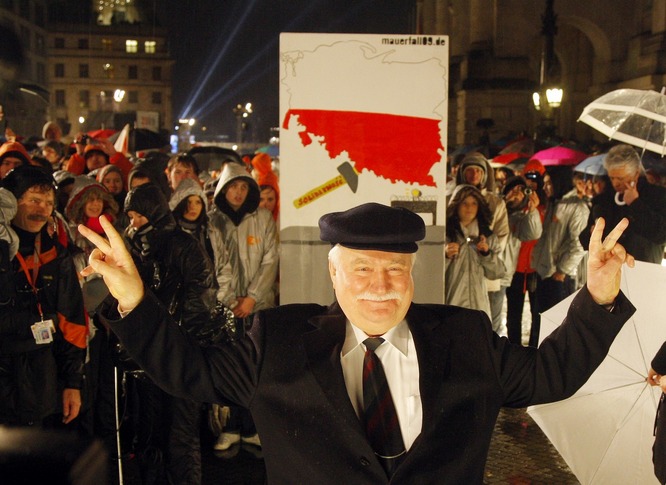
Mind the Leninist smirk of Wałesa and the victory sign: he knows what we know not. Also pay attention to the tricky design of that wall element he was shortly after to kick over and start the chain reaction: Superficially seen, the design tells us: it all started in Poland. But there is this (communist) hammer, with the “Solidarność” logo on it (Solidarność was but a controlled, fake opposition movement, with 30% of all Communist Party members and 20 % even of the Central Committee in 1980 being at the same time members of Solidarność!).
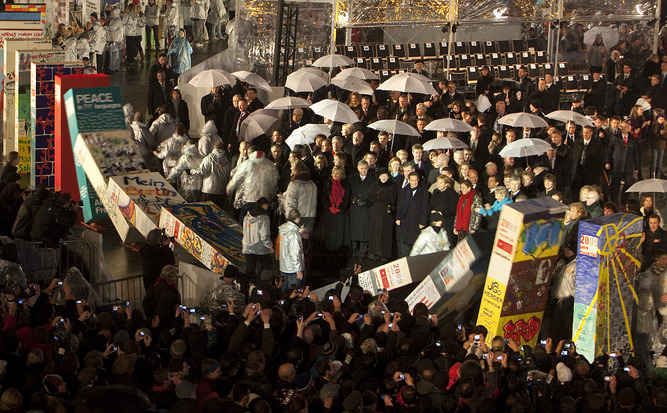
Were the state leaders watching this perfidious scene aware of its duplicity? Disciple of Marxist instructor Saul Alinsky, Hillary Clinton, might have been. Also, left-winger Gordon Brown surely must have enjoyed the act. Even alleged conservative Nicolas Sarkozy may have understood. But what about the public; of Germany; of the world; us? – At least, there was one quite comforting detail in this that wasn’t widely reported: the dominoes did not, as intended, fall all the way round, but stopped for some mysterious reason half way. This is indeed a promising omen. Also, as the first dominoes were kicked over, a cameraman, about to start off along the falling blocks on a mini-scooter of sorts, fell, which resulted in a brief blackout of the live TV-broadcast: you see, there are always unforeseeable events that give us clues: the fall of the Berlin Wall wasn’t a blessing; rather, it cruelly sealed the destiny of the Free World!
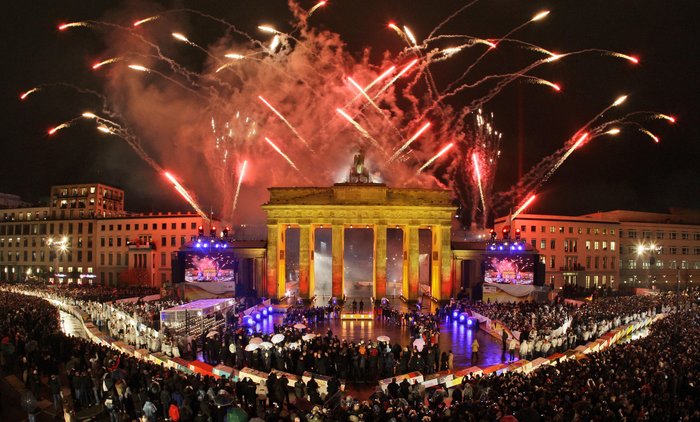
The evening was then crowned by magnificent fireworks, but again there appears a fairly disturbing element: The scene shows the Brandenburg Gate from the West, that’s where the celebrations mainly took place. As one contemplates on this firework, one almost inevitably is reminded of missiles, missiles fired from the East towards the West! We do not know whether this was the intention, but if it was it would mean indeed that WW III is just around the corner!
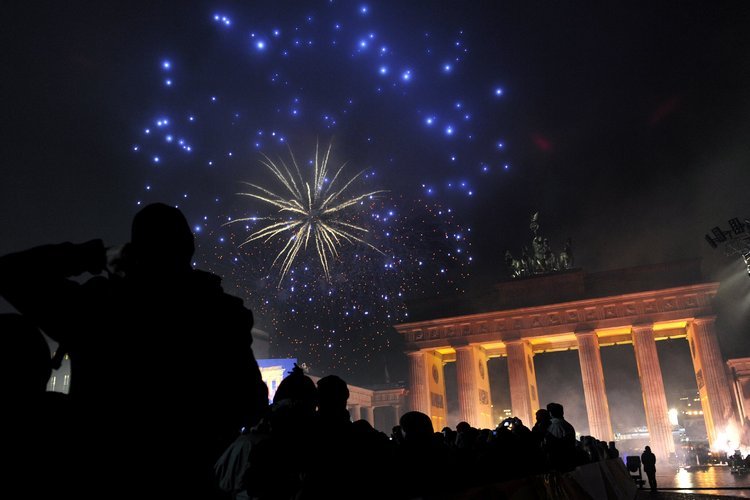
Yet, in the course of the whole evening (which this author watched live on German television) there was a brief moment perhaps more devastating than everything else, and it consisted in simply one word (unfortunately this author couldn’t find a photograph or video-clip on the web showing this moment). Mikhail Gorbachev was being interviewed live by German showmaster Thomas Gottschalk who led as TV-moderator through that night, and after finishing his boastful reminiscences, as always in Russian, Gorbachev all of a sudden grabbed Gottschalk’s hand for a firm handshake, an act completely out of the norm, and uttered a resolute and categorical “Druzhba!” – Ouch! ‘Druzhba!’ means ‘Friendship!’ and is well-known to be the all-socialist/communist greeting around the world, whether in Russian or in any other language. What boldness, what cynicism: On the night when the 75 plus % ignorant Germans naïvely celebrated the supposed fall of communism and the subsequent reunification of Germany, Gorbachev brutally nullified that illusion of ‘collapsible communism’ by that single word, that single communist greeting! The merger of East and West Germany indeed had been, at last, on communist terms, just as the whole world is now in the process of being merged, too, on no one else’s terms but on those of the communists.
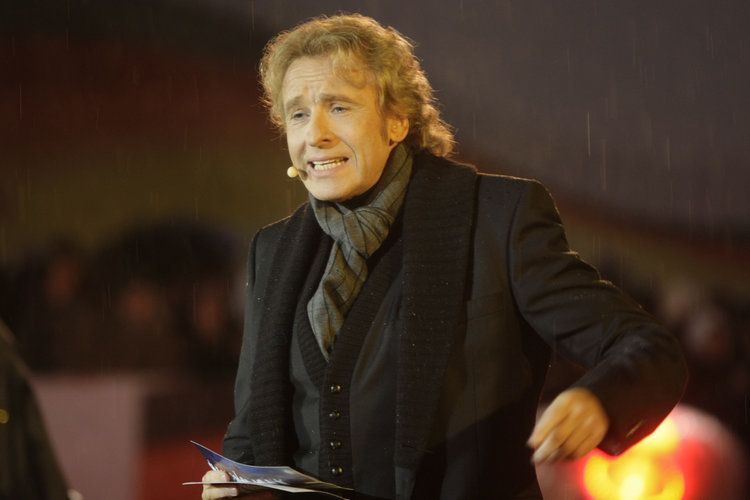
Showmaster and moderator, Thomas Gottschalk, well-protected on this evening against the rain by a huge umbrella. Thomas Gottschalk, as the most successful and popular TV-showmaster of Germany, isn’t that easily baffled. But in that moment, when Mikhail Gorbachev forced communist friendship upon him, he visibly was!
7. CASE STUDY II: THE 2006 AND 2012 NEW YEAR’S CONCERTS OF THE VIENNA PHILHARMONIC ORCHESTRA: (SOVIET-)LATVIAN CONDUCTOR MARISS JANSONS’ PECULIAR SYMBOLIC HINTS
Mariss Jansons was born in early 1943 (as of 2020, he has meanwhile died), at the height of WW II, in the Latvian capital Riga, that had been, along with the whole of the Baltics, incorporated by force into the Soviet Union in June 1940 and that was under German occupation, since Germany had opened war against the USSR, from 1941 till 1944. Being the son of a conductor and a singer, Jansons’ career path was set early. He studied piano and conducting at the prestigious Leningrad Conservatory from age 13 and continued his training, age 26, in Vienna and Salzburg. In 1973, Jansons was appointed Associate Conductor of the Leningrad Philharmonic Orchestra. From 1979 he was for two decades music director of the Oslo Philharmonic. He also worked extensively with the London Philharmonic and London Symphony Orchestras, with the Pittsburgh Symphony Orchestra, the Royal Concertgebouw Orchestra, and the Bavarian Radio Symphony Orchestra.
As the first ever conductor of “former” communist background, Mariss Jansons was invited somewhere in 2004, presumably, by the Vienna Philharmonic Orchestra to conduct on New Year’s Day 2006 their internationally known and loved annual New Year’s Concert at the Vienna Musikverein. It was the time when the “New Russia” began showing again its true face of a never-abolished Soviet Union. The “Russian Federation” had adopted natural gas as a political weapon against Western Europe; later that year there were to occur the shocking assassinations of ex-KGB/FSB-officer Alexander Litvinenko and journalist Anna Politkovskaya. More than a year earlier, the world had witnessed the unspeakable school hostage tragedy at Beslan, in which up to a thousand innocent children died (the school was, in fact, bombarded from the air). On the political platform, the whole of Eastern Europe, without for the moment Romania and Bulgaria, had joined the European Union on May 1st, 2004; and Germany had exchanged, after 7 years of Red-Green governmental adventurism, its Chancellor from West German socialist-Marxist Gerd Schröder to “former” East German plain-Marxist, hidden under the cloak of an all-German “Christian Democrat”, Angela Merkel. Things were most wonderfully unfolding for European and world communism.
In the midst of that 2006 New Year’s Concert with music mainly by, as every year, the Strauß dynasty & contemporaries, there were also, as every year, one or two gags thrown in, which the audience ritually awaits to see. However, this time, 2006, as well as with Jansons’ second New Year’s Concert in 2012, things were somewhat different. Almost certainly, Mariss Jansons’ gags weren’t nearly as innocent as most of the concert- and TV-audience might have believed.
As for the concert in 2006, there was first, just before the end of Eduard Strauß’ “Telephon Polka Francaise op. 165”, a ‘surprise call’ on Jansons’ mobile phone! He switched it off, seemingly annoyed, and the orchestra finished the piece with great fanfare. Everybody had a good laugh.
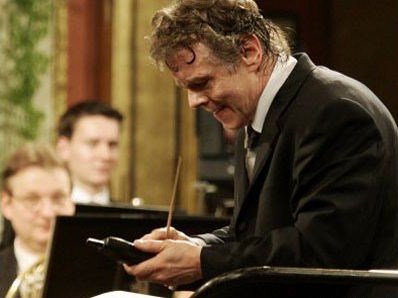
The second “joke” was after playing Johann Strauß the Younger’s “Banditen Galopp op. 378”, when one orchestra musician and Mariss Jansons, both with ancient pistols, were shooting up in the air like crazy guerilleros celebrating their victory. The act was noisy, and smoke rose up to the ceiling.
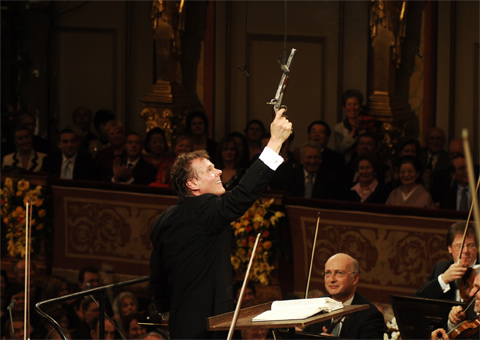
So apparently harmless, so amusing.
Yet, 6 years later, 2012, Mariss Jansons from brotherly USSR (whose favourite colour seems to be anthracite grey, by the way), in his second New Year’s Concert with the utterly bourgeois Vienna Philharmonic, came up with a set of rather puzzling “jokes” again (weirdly, this year’s flower decoration of the Musikverein’s Golden Hall was solely in white and dark red; officially explained by the national colours of both Austria and, more so, Latvia). – At first, for Joseph Strauß’ Polka Francaise “Feuerfest” (Fireproof!!!) op. 269, Mariss Jansons took it upon himself to contribute the key element of percussion of this piece, which is every now and then two hammers knocking down alternately on two differently tuned anvils. This Polka is otherwise especially lovely because it includes a boys’ choir, here represented by the Wiener Sängerknaben, and spreads an atmosphere of great jollity. Nevertheless, the image remains: two hammers, and their helves even partly red (hammer & sickle certainly would have been too obvious!).
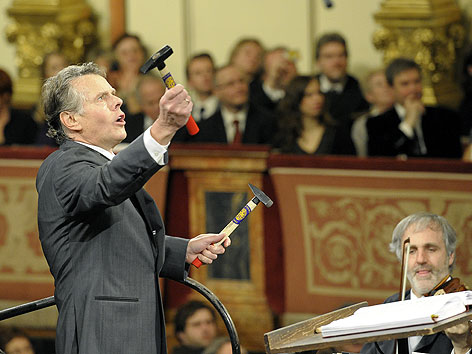
Significantly, it was this photograph showing Jansons with hammers in his hands that the (Red-)Vienna section of the deeply socialist Austrian Broadcasting Corporation ORF chose, beside a second one, for a report on their website. They certainly understood their communist comrade, no doubt!
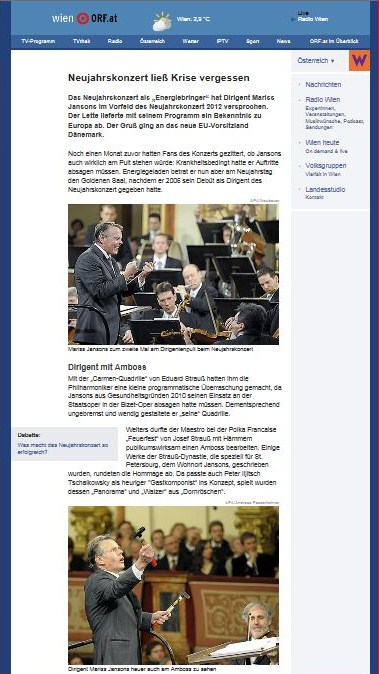
The second “joke” came towards the end of the concert after finishing Johann Strauß the Younger’s popular Polka schnell, “Tik-Tak” op. 365. A musician passes to the conductor a huge 19th-century-style alarm-clock, with Jansons vigorously pointing to it, and, sure enough, the thing rings loud enough for everybody to hear. But, whom does he try to wake up, and what for?
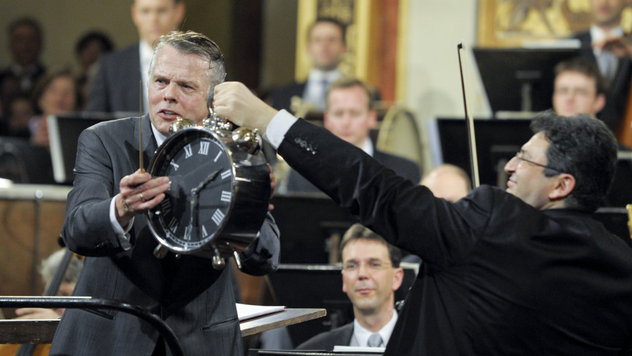
(By the way, doesn’t it seem to be the case with Jansons, just as with everybody else from the communist East, that they always appear, given their ever-same superior smirk, to know more than we do? Most probably, that is the case!)
As we try to make sense of these quite obvious allusions, going back for a moment to the 2006 concert, we should view those two images of that concert in relation to each other; as, very likely, they are giving us a quite distinct message. The pistols of course stand for war (and mind that this galop is named “Bandits”; the Bolshevists, from the earliest beginnings up to this day are just that: bandits; they know it well, and, in Satanic fashion, are even proud of it). And the ringing telephone stands for dialogue. It was, in the opinion of this author, a warning: Listen to us, talk to us, engage in dialogue and cooperation – OR ELSE. (Essentially the same message like Gorbachev’s recent speech at Munich that stood at the beginning of this presentation). Indeed, in recent years, the West (or what’s left of it) has received many explicit WW-III-threats from a number of Russian generals, mostly related to Bush-43’s missile defence plans in Eastern Europe (although this is merely an excuse for gearing up their pre-WW-III propaganda machine). So, it was basically another way of expressing the pan-communist bloc’s final phase of “cooperation-blackmail”. That was 2006.
This year, 2012, things looked even more ominous. First, we have the red hammers on the anvils (albeit without a sickle) accompanying a Polka entitled indeed “Fireproof”!!! Then we get, at the end of the Tik-Tak Polka (meaning: time is ticking!!!) that wake-up call in the form of the alarm clock! However, now it isn’t a warning anymore, so it seems, but a mere one-sided message: ‘Time’s up! Communism’s coming!’ Not enough with these two “humorous side notes”, also the choice of musical pieces, at closer look, seems to hold some uncomfortable surprises, even more so when one combines them into one larger message (unless it’s all ungrounded paranoia, but it isn’ t):
• The 2012 New Year’s Concert was actually opened with Johann & Joseph Strauß’ “Vaterländischer Marsch”; i.e. “Patriotic March”!!! The unchanged Soviets unchangedly refer to WW II as their “Great Patriotic War”, in German: Großer Vaterländischer Krieg. Interesting!
• The third piece of the altogether twenty-four was Johann Strauß the Younger’s Polka schnell op. 403, “Entweder – oder!”; i.e. “Either – Or!” Gets a bit frightening by now. This is the message of blackmail.
• The eighth of the lot was Joseph Hellmesberger Junior’s merciless “Danse Diabolique”. No explanation needed for that.
• The twelfth was Danish composer Hans Christian Lumbye’s galop “Steam Railway”. Also very fitting for a future military offensive, apart from the fact that the revolution sees itself as a train on fixed rails!!!
• The thirteenth was, as already mentioned, Joseph Strauß’ Polka Francaise op. 269, “Fireproof”; the one with the hammers (these last two even in direct succession!)
• Then there were two pieces by Tchaikovsky. Jansons isn’t Russian but Latvian; nevertheless he comes from the Russian-dominated musical tradition of the Soviet Union, and therefore Tchaikovsky makes sense (well, he isn’t too far, as a Balt, from the Scandinavian tradition either, at least geographically). But what choice: the “Panorama” and the “Waltz” from Tchaikovsky’s Ballet “The Sleeping Beauty”, that is based on the fairy tale “Dornröschen” (Little Briar Rose) from the fairy tale collection by the German Brothers Grimm, and ultimately on Charles Perrault’s story “La Belle au bois dormant” (i.e. ‘The Beauty in the Sleeping Wood’).
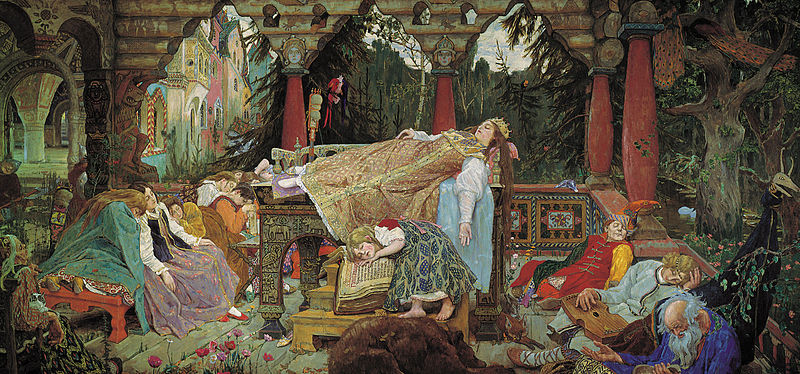
Viktor Mikhaylovich Vasnetsov (1848–1926): “Sleeping Princess” (1900-1926); Princess Aurora’s 100-year sleep since the curse by the wicked fairy Carabosse, mildened by the intercession of the benevolent Lilac Fairy, had hit her at age 16. Yet, along with Aurora, the Lilac Fairy sent the whole country to sleep – until finally a prince will come and kiss the princess back into life …
Do the unchanged Soviet communists equate Europe to the Sleeping Princess and themselves to the prince??? (There’ve been comments by Vladimir Putin towards the U.S. a few years ago, telling them to better keep their fingers off this young woman, Europe; however, this quote seems by now to be impossible to find on the web.) Well-known anyway, they love to liken their revolution to the glorious dawn of a new era. The opposite is true: Wherever communism comes to power, lights go effectively out for a very long time. Thus, one should rather liken communism to the evil witch who would like to kill the princess, with the dull result that the princess and her land enter into a century of deep coma.
• Not enough with all that, was played the Persian March op. 289 by Johann Strauß. – Nota bene, at a time when the full-grown Soviet satellite of Iran could in whatever way be involved in triggering World War III (and they’re now indeed threatening to block the Strait of Hormuz, presumably in coordination with Moscow, which would mean war because 40% of all shipped crude-oil worldwide is coming through that sea passage.)
• Further, there was played the (very elegant and Offenbach-style) Polka schnell op. 324 “Unter Donner und Blitz” (Thunder and Lightning). Rather drastic, given the fact that we live not only in an age of nuclear weapons and thermobaric vacuum bombs but also directed-energy-weapons.
• And, finally, the above-mentioned Tik-Tak Polka with the alarm clock as a brutal reminder!
In case these choices were indeed made by such insidious intention (Mariss Jansons is said to have researched the Strauß oeuvre with unusual meticulousness!), one can, on the other hand, be sure that none of the Vienna Philharmonic would have seen through the scheme. The communists are truly the world champions of deception; whereas, despite all monstrous history already written by communism, the naïve and ever-friendly West has again become unable to comprehend that such concentrated evil as practised resp. envisioned by the communists can indeed exist. The reality is, however: It existed then in 1917, and it hasn’t gone away ever since!
The reader to whom such considerations appear completely foreign or over-the-top may be reminded that tough ideological determination among Soviet-communist artists, including musicians, is anything but new. As another contemporary example, Russian conductor Valeriy Gergiyev (born 1953), who already looks wild and dangerous, holds a function within the German-Russian bilateral forum “Petersburg Dialogue”, that is a political body aimed at furthering the German/West-European convergence with “Russia” (from the fact that the German side is headed by the last Prime Minister of communist East Germany, Lothar de Maizière, one can immediately see on whose ideological terms that convergence will play out). What’s more, in the infamous South-Ossetia War of 2008, Gergiyev conducted the top-ideological piece of Soviet symphonic music, the Leningrad Symphony by Shostakovich, and so, most melodramatically, in the ruins of the South-Ossetian capital Tskhinvali that had now been in fact brought under direct Russian control (although, on the other hand, one should be more than wary of the alleged pro-Western stance of Georgian President Saakashvili as well; “post-Soviet affairs” just remains a hall of mirrors, designed to leave the non-initiated Western observer stunned, disoriented and confused).
The major difference, however, between the present-day generation and earlier Soviet generations is that those of today, even the oldest, were born into the deadly Marxist-Leninist collectivist system and were indoctrinated, formed and trained along the rigorous ideological lines of Marx and Lenin. Without exaggeration one could view them almost as a different species (Romanian pastor Richard Wurmbrand, author of Marx and Satan, characterised communism as “collective demonic possession”). They think, feel, and function differently, even though since the proclamation of “Perestroika” they have put on chique Western clothes and have increasingly “mastered” bourgeois conduct and behaviour, for which inwardly they hold nothing but contempt.
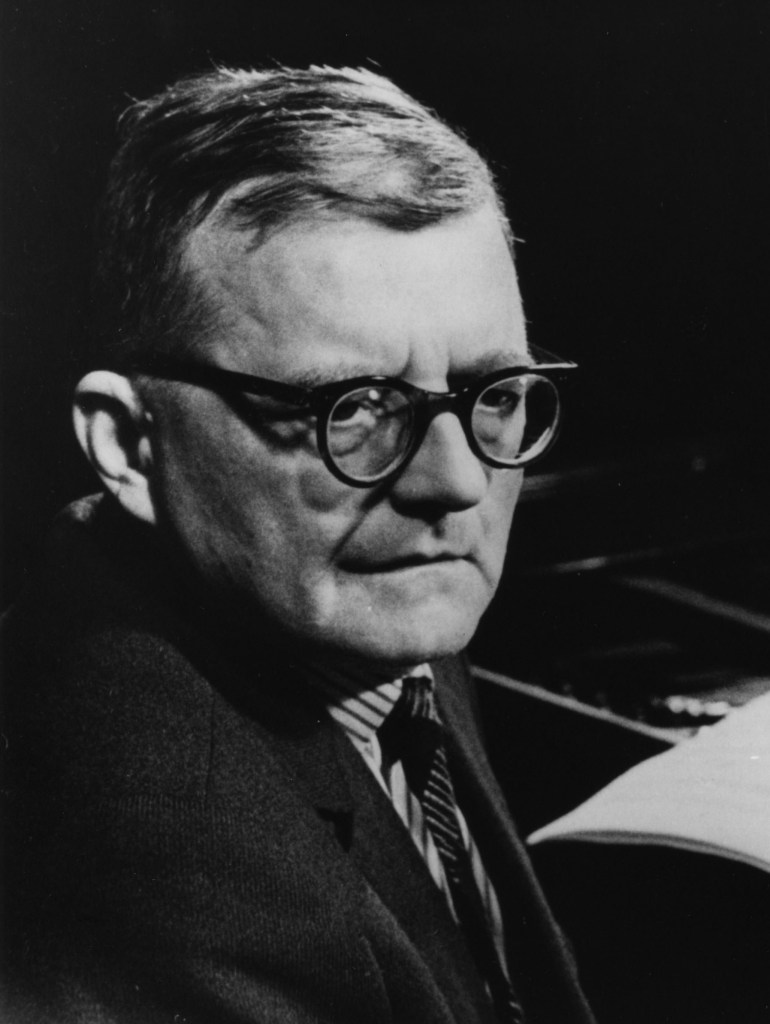 In contrast, the biography of Dmitriy Shostakovich (1906 – 1975) – although he did, for the mere sake of survival, give the system a number of highly ideological works such as “October”, “First of May”, or “Leningrad” – still shows what today has long passed: the permanent struggle within a hostile, oppressive, totalitarian system of someone who still had known, at least as a child, the old order of things. Although Shostakovich arose to the highest summits of Soviet-Russian music and certainly participated, with little zeal though, in the structures of the new proletarian environment, he remained throughout his life a quiet dissident. Many of his works show subtle irony, if not sarcasm, which was about the utmost critique possible even for someone in his position of already international fame, and it can only be guessed how Dmitriy Shostakovich, who was fascinated by the works of Stravinsky and Mahler, might have developed as a composer, had he been given the opportunity to live and breathe and work in a free, sound and God-fearing society. Legend has it that he was living, especially under Stalin, in a constant state of existential fear, with always (imagine!) a suitcase packed just in case he’d be picked up early in the morning and sent to prison, or worse. – Such a generation still aware in their hearts and minds of an era prior to the revolution no more exists. Any element of genuine opposition, genuine “reaction”, genuine restoration, has been over many decades thoroughly rooted out from the USSR’s population: they are now all “genetic” Leninists!
In contrast, the biography of Dmitriy Shostakovich (1906 – 1975) – although he did, for the mere sake of survival, give the system a number of highly ideological works such as “October”, “First of May”, or “Leningrad” – still shows what today has long passed: the permanent struggle within a hostile, oppressive, totalitarian system of someone who still had known, at least as a child, the old order of things. Although Shostakovich arose to the highest summits of Soviet-Russian music and certainly participated, with little zeal though, in the structures of the new proletarian environment, he remained throughout his life a quiet dissident. Many of his works show subtle irony, if not sarcasm, which was about the utmost critique possible even for someone in his position of already international fame, and it can only be guessed how Dmitriy Shostakovich, who was fascinated by the works of Stravinsky and Mahler, might have developed as a composer, had he been given the opportunity to live and breathe and work in a free, sound and God-fearing society. Legend has it that he was living, especially under Stalin, in a constant state of existential fear, with always (imagine!) a suitcase packed just in case he’d be picked up early in the morning and sent to prison, or worse. – Such a generation still aware in their hearts and minds of an era prior to the revolution no more exists. Any element of genuine opposition, genuine “reaction”, genuine restoration, has been over many decades thoroughly rooted out from the USSR’s population: they are now all “genetic” Leninists!
Thus, what’s left is nothing but a civilisatory and, first of all, spiritual DESERT: the perfect precondition for finally building their (whatever short-lived) Satanic kingdom on earth, not only on their territory, but meanwhile easily on a global scale. May God help us in the trials and tribulations that lie ahead of us! Amen.
l
MISSED CHANCES …
“The fundamental philosophy of Communism can be answered only by a firm and enlightened belief in God. Nothing will give more strength to the hand-to-hand combat against the conspiracy, made possible by a knowledge of its techniques, than a great Credo from the hearts and minds of the American people. Those who are educated and among whom the ravages of unbelief have particularly paved the way for an acceptance of the doctrines of Red slavery, have a peculiar obligation to assert: ‘I believe in God, the Father Almighty, Creator of Heaven and Earth.’ That humble expression of faith is the beginning of wisdom in the battle against Communism.” – Louis F. Budenz, former prominent US Communist, in his 1954 book “The Techniques of Communism”
“I would never have imagined the extreme degree to which the West actually desired to blind itself to the world situation, the extreme degree to which the West had already become a world without a will, a world gradually petrifying in the face of the danger confronting it, a world oppressed above all by the need to defend its freedom. There is a German proverb which runs ‘Mut verloren – alles verloren’: When courage is lost, all is lost. There is another, Latin one, according to which loss of reason is the true harbinger of destruction. But what happens to a society in which both these losses – the loss of courage and the loss of reason – intersect?” Aleksandr Solzhenitsyn: “Warning to the West” [5 speeches given originally in 1975/76], Hill and Wang, First Edition 1986
l
8. LITERATURE ON COMMUNISM
This author has compiled an extensive bibliography on communism. Here it is.
l
9. AUDIO & VIDEO SOURCES
There is also an elaborate collection of audio & video sources on the topic. Check it out here!
10. FINALLY…
… everybody is urgently recommended to go to the weblog of probably the most knowledgable analyst of communist affairs and communist world revolution alive today, U.S. geopolitical analyst J.R. Nyquist, a writer who watches things from a highly integrated viewpoint that includes military strategy, psychosociology, cultural history and philosophy. His website is www.jrnyquist.blog (his old site, where one can still find a lot of material, was www.jrnyquist.com). Mr. Nyquist has been doing this for thirty plus years. His reference work, Origins of the Fourth World War, was published in 1998. He also co-authored a number of books, among them Back From the Dead: The Return of the Evil Empire (2014) and The New Tactics of Global War: Reflections on the Changing Balance of Power in the Final Days of Peace (2015). J.R. Nyquist has written for online publications such as NewsMax, FinancialSense, the Sierra Times, WorldNetDaily and, more recently, the Epoch Times. He has also been a guest on various talk shows over the years. Here is one interview that he gave in mid March 2020, which of course was dealing with the Coronavirus pandemic and its connections to pan-communist strategy. Watch that interview here!
l
l
l
l
© The Contemplative Observer 2013/2020
l
